Mitac 8575X Notebook Computer with Built-In Wireless LAN User Manual 8575A E
Mitac International Corporation Notebook Computer with Built-In Wireless LAN 8575A E
Mitac >
Contents
- 1. Notebook User Manual
- 2. Notebook User Manual with mini PCI WLAN as optional device
Notebook User Manual
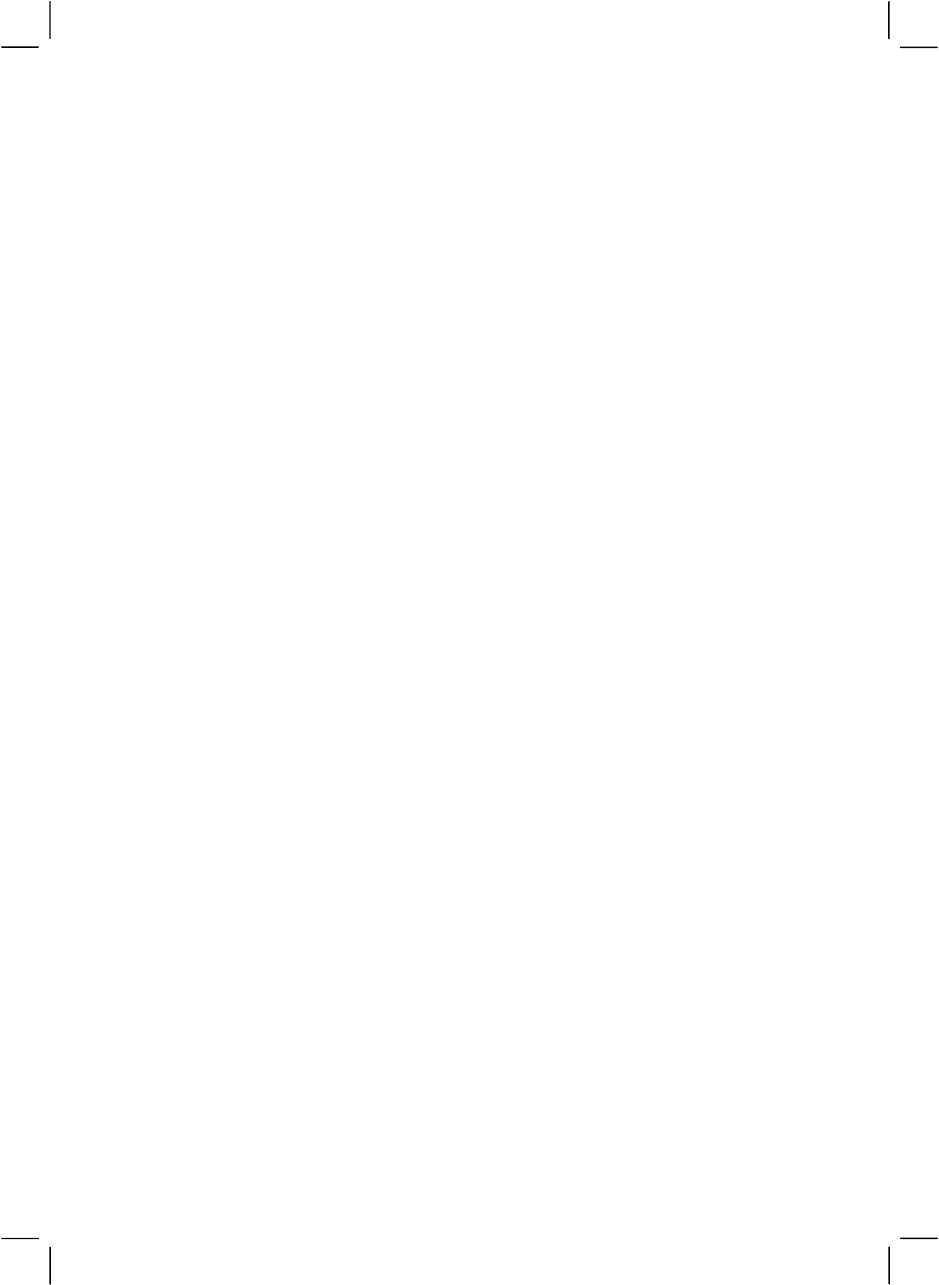
User’s Manual
Part Number: 5615 6717 5013 R00
(June 2002)

TRADEMARKS
All brand and product names are trademarks or registered trademarks of their
respective companies.
NOTE
The information in this manual is subject to change without notice.
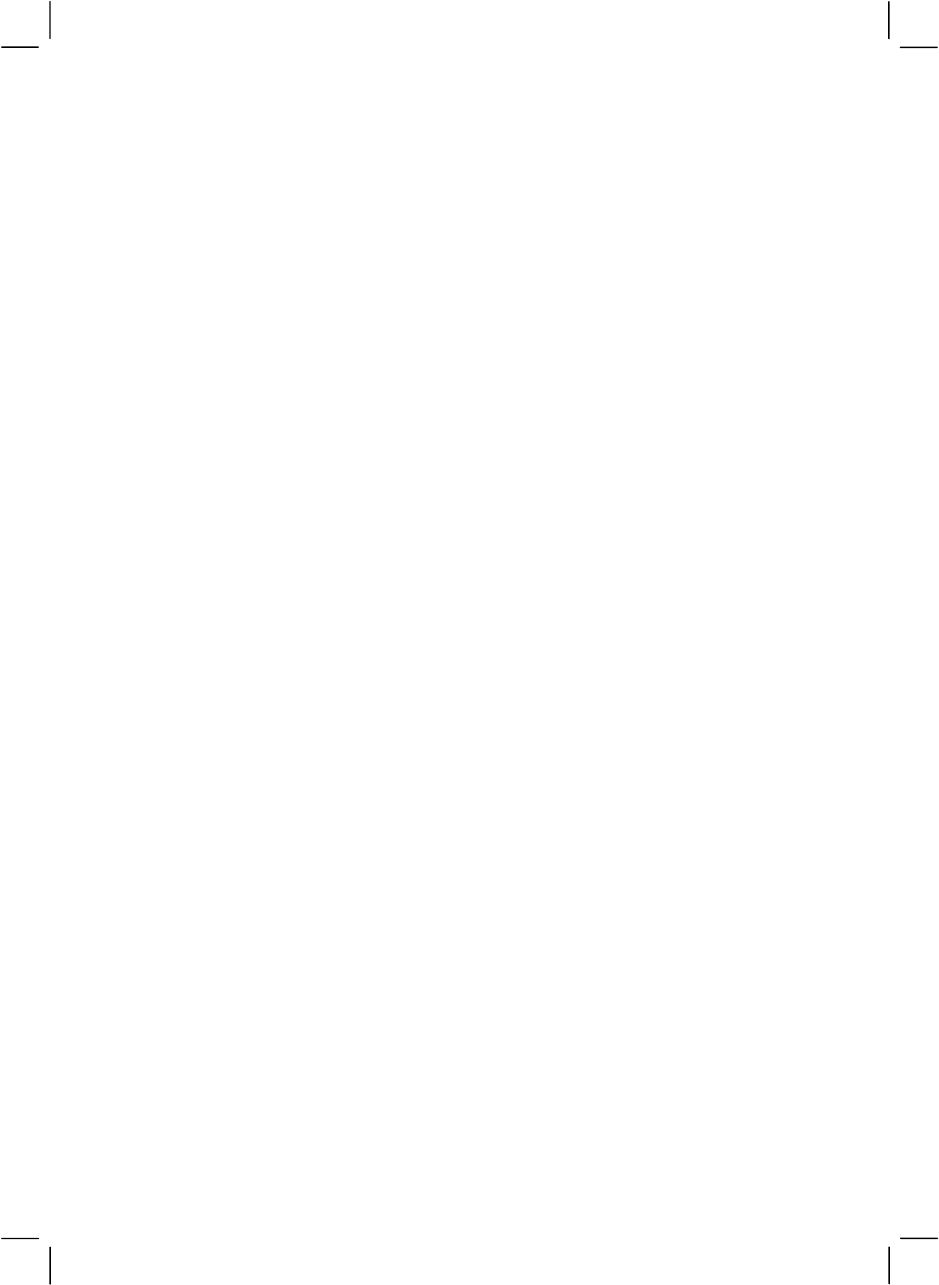
5HJXODWLRQV,QIRUPDWLRQ
&ODVV%5HJXODWLRQV
86$
Federal Communications Commission Radio Frequency Interference Statement
NOTE:
This equipment has been tested and found to comply with the limits for a Class B digital
device pursuant to Part 15 of the FCC Rules. These limits are designed to provide
reasonable protection against harmful interference in a residential installation. This
equipment generates, uses, and can radiate radio frequency energy and, if not installed
and used in accordance with the instructions, may cause harmful interference to radio
communications. However, there is no guarantee that interference will not occur in a
particular installation. If this equipment does cause harmful interference to radio or
television reception, which can be determined by turning the equipment off and on, the
user is encouraged to try to correct the interference by one or more of the following
measures:
−Reorient or relocate the receiving antenna.
−Increase the separation between the equipment and receiver.
−Connect the equipment into an outlet on a circuit different from that to which the
receiver is connected.
−Consult the dealer or an experienced radio/TV technician for help.
Any changes or modifications not expressly approved by the manufacturer could void the
user’s authority to operate the equipment.
Please note:
The use of a non-shielded interface cable with this equipment is prohibited.
&DQDGD
Canadian Department of Communications
Radio Interference Regulations Class B Compliance Notice
This digital apparatus does not exceed the Class B limits for radio noise emissions from
digital apparatus set out in the Radio Interference Regulations of the Canadian
Department of Communications.
Le présent appareil numérique n’émet pas de bruits radioélectriques dépassant les limites
applicables aux appareils numériques de la classe B prescrites dans le Règlement sur le
brouillage radioélectrique édicté par le ministère des Communications du Canada.

$ERXWWKH%DWWHU\
&DXWLRQ7H[WV&RQFHUQLQJ/LWKLXP%DWWHULHV
DANISH
ADVARSEL!
Lithiumbatteri – Eksplosionsfare ved fejlagtig håndtering. Udskiftning må kun ske med
batteri af samme fabrikat og type. Levér det brugte batteri tilbage til leverandøren.
NORWEGIAN
ADVARSEL:
Eksplosjonsfare ved feilaktig skifte av batteri. Benytt samme batteritype eller en
tilsvarende type anbefalt av apparatfabrikanten. Brukte batterier kasseres i henhold til
fabrikantens instruksjoner.
SWEDISH
VARNING:
Explosionsfara vid felaktigt batteribyte. Använd samma batterityp eller en ekvivalent typ
som rekommenderas av apparattillverkaren. Kassera använt batteri enligt fabrikantens
instruktion.
FINNISH
VAROITUS:
Paristo voi räjähtää, jos se on virheellisesti asennettu. Vaihda paristo ainoastaan
valmistajan suosittelemaan tyyppiin. Hävitä käytetty paristo valmistajan ohjeiden
mukaisesti.
ENGLISH
CAUTION:
Danger of explosion if battery is incorrectly replaced. Replace only with the same or
equivalent type recommended by the equipment manufacturer. Discard used batteries
according to manufacturer's instructions.
DEUTSCH
VORSICHT:
Explosionsgefahr bei unsachgemäßem Austausch der Batterie. Ersatz nur durch
denselben oder einen vom Hersteller empfohlenen gleich-wertigen Typ. Entsorgung
gebrauchter Batterien nach Angaben des Herstellers.
FRENCH
ATTENTION:
II y a danger d’explosion s’il y a remplacement incorrect de la batterie. Remplacer
uniquement avec une batterie du même type ou d’un type équivalent recommandé par le
constructeur. Mettre au rebut les batteries usagées conformément aux instructions du
fabricant.

$WWHQWLRQIRU86$8VHUV
The product that you have purchased contains a rechargeable battery. The battery is
recyclable. At the end of its useful life, under various state and local laws, it may be illegal
to dispose of this battery into the municipal waste stream. Check with your local solid
waste officials for details in your area for recycling options or proper disposal.
$ERXWWKH0RGHP
&DXWLRQ
1. Never install telephone wiring during a lightning storm.
2. Never install telephone jacks in wet locations unless the jack is specifically designed
for wet locations.
3. Never touch uninsulated telephone wires or terminals unless the telephone line has
been disconnected at the network interface.
4. Use caution when installing or modifying telephone lines.
5. Avoid using the telephone function (other than a cordless type) during an electrical
storm. There may be a remote risk of electric shock from lightning.
6. Do not use the telephone function to report a gas leak in the vicinity of the leak.
7. Do not use this product near water, for example near a bath tub, wash bowl, kitchen
sink or laundry tub, in a wet basement or near a swimming pool.
&DXWLRQIRU86$8VHUV
To reduce the risk of fire, use only No.26 AWG or larger telecommunication line cord.

L
Table of Contents
Preface ........................................................................................ v
Chapter 1 Getting Started .....................................................1-1
Getting the Computer Running................................................1-2
Unpacking..........................................................................1-2
Connecting to AC Power ...................................................1-2
Opening the Cover .............................................................1-3
Turning On and Off the Computer.....................................1-4
Taking a Look at the Computer...............................................1-6
Right-Side Components .....................................................1-6
Left-Side Components .......................................................1-7
Rear Components...............................................................1-8
Front Components..............................................................1-9
Top-open Components.....................................................1-10
Where to Go from Here .........................................................1-12
Chapter 2 Operating Your Computer ...................................2-1
Starting and Stopping the Computer........................................2-2
Starting the Computer ........................................................2-2
Stopping the Computer ......................................................2-2
Using the Keyboard .................................................................2-4
Typewriter Keys.................................................................2-4
Cursor-Control Keys..........................................................2-5
Numeric Keypad ................................................................2-6
Euro Symbol ......................................................................2-7
Windows Keys ...................................................................2-7

LL
Function Keys ....................................................................2-8
Fn Key................................................................................2-8
Hot Keys ............................................................................2-8
Using the Touchpad ...............................................................2-10
Configuring the Touchpad ...............................................2-12
Using Easy Start Buttons .......................................................2-13
Using the Floppy Disk Drive .................................................2-14
Connecting the Floppy Disk Drive ..................................2-14
Inserting and Ejecting Floppy Disks ................................2-15
Using the Hard Disk Drive ....................................................2-16
Using the CD/DVD Drive......................................................2-17
Inserting and Removing a CD..........................................2-18
Using the Video Features.......................................................2-19
Configuring the Display Modes .......................................2-19
Using the Audio Features ......................................................2-21
Connecting Audio Devices ..............................................2-22
Using the Communication Features.......................................2-23
Using the Modem.............................................................2-23
Using the LAN .................................................................2-24
Chapter 3 Managing Power ..................................................3-1
AC Adapter..............................................................................3-2
Battery Pack.............................................................................3-3
Charging the Battery Pack .................................................3-3
Initializing the Battery Pack...............................................3-4
Checking the Battery Level................................................3-4
Replacing the Battery Pack ................................................3-4
Battery Low Signals and Actions.......................................3-5
Power Management .................................................................3-7
Hibernation.........................................................................3-8
Power-Saving Tips...................................................................3-9
Chapter 4 Expanding Your Computer..................................4-1
Connecting an External Monitor..............................................4-2
Connecting a TV......................................................................4-3

LLL
Connecting a Parallel Device...................................................4-5
Connecting a USB Device.......................................................4-6
Connecting an IR Device.........................................................4-7
Connecting an IEEE 1394 Device ...........................................4-9
Using PC Cards .....................................................................4-10
PC Card Type...................................................................4-10
CardBus Support..............................................................4-10
Inserting and Removing a PC Card..................................4-10
Internal Components Upgrade...............................................4-12
Chapter 5 Using BIOS Setup ................................................5-1
When and How to Use BIOS Setup.........................................5-2
When to Use.......................................................................5-2
Starting BIOS Setup...........................................................5-2
Moving Around and Making Selections ............................5-3
Main Menu ..............................................................................5-5
Advanced Menu.......................................................................5-6
Security Menu..........................................................................5-9
Boot Menu .............................................................................5-10
Exit Menu ..............................................................................5-11
Chapter 6 Installing Software Drivers..................................6-1
How to Use the CD..................................................................6-2
Other Drivers and Utilities.......................................................6-4
Easy Start Button Utility....................................................6-4
Wireless LAN Utility .........................................................6-5
Chapter 7 Caring for the Computer......................................7-1
Protecting the Computer..........................................................7-2
Using the Password............................................................7-2
Using the Cable Lock.........................................................7-2
Using an Anti-Virus Strategy.............................................7-3
Taking Care of the Computer ..................................................7-4
Location Guidelines ...........................................................7-4
General Guidelines.............................................................7-4

LY
Cleaning Guidelines ...........................................................7-5
Battery Pack Guidelines.....................................................7-5
When Traveling .......................................................................7-6
Chapter 8 Troubleshooting...................................................8-1
Preliminary Checklist ..............................................................8-2
Solving Common Problems .....................................................8-3
Battery Problems................................................................8-4
CD Drive Problems ............................................................8-4
Display Problems ...............................................................8-5
Floppy Disk Drive Problems..............................................8-7
Hardware Device Problems................................................8-8
Hard Disk Drive Problems .................................................8-8
Infrared Problems...............................................................8-9
Keyboard, Mouse, and Touchpad Problems ......................8-9
LAN Problems .................................................................8-10
Modem Problems .............................................................8-10
PC Card Problems ............................................................8-10
Power Management Problems (for Windows) .................8-11
Printer Problems...............................................................8-12
Software Problems ...........................................................8-12
Sound Problems ...............................................................8-12
Startup Problems ..............................................................8-13
Other Problems.................................................................8-14
Resetting the Computer .........................................................8-15
Appendix A Specifications................................................... A-1
Index .........................................................................................I-1

Y
Preface
This manual contains information that will help you operate the
computer. It is divided into 8 chapters, an appendix, and an index.
z Chapter 1, Getting Started, takes you through the process of setting
up the computer and identifying its external components.
z Chapter 2, Operating Your Computer, tells you how to use the
computer’s components and features.
z Chapter 3, Managing Power, provides information on power.
z Chapter 4, Expanding Your Computer, provides information on
installing and using peripheral devices.
z Chapter 5, Using BIOS Setup, describes the SCU program that
configures the computer’s BIOS settings.
z Chapter 6, Installing Software Drivers, describes how to install the
drivers and utilities supplied with the computer.
z Chapter 7, Caring for the Computer, gives you tips in care and
maintenance.
z Chapter 8, Troubleshooting, gives solutions to common problems
you may encounter when using the computer.
z Appendix A, Specifications, gives a brief specification for the
computer.

YL
1RWDWLRQDO&RQYHQWLRQV
Throughout this manual, the following conventions are used to
distinguish elements of text.
127(LGHQWLILHVDGGLWLRQDOLQIRUPDWLRQWKDWUHTXLUHVVSHFLDODWWHQWLRQ
&$87,21LGHQWLILHVLPSRUWDQWLQIRUPDWLRQZKLFKLIQRWIROORZHGPD\UHVXOWLQORVVRI
GDWDRUGDPDJHWRWKHFRPSXWHU
Keyboard keys are shown in a bold typeset. For example:
Press (QWHU to complete.
When keys are joined by a plus sign (+), press the first key, and, while
keeping the first key down, press the remaining keys, finally release all
the keys. When necessary, keys are also shown in graphics.
A title, command, setup item, or button that you can see on the screen is
shown in boldface. A value or an option that you can select for a setup
item is shown in italic. For example:
Select Power Management, set it to Enabled, and then click the
OK button.

CHAPTER 1
Getting Started
Congratulations on purchasing this computer.
Your computer incorporates desktop computer capabilities into a
compact notebook-sized package. It can greatly enhance your
productivity either in the office or at home. And, of course, wherever you
need it, the computer is ready and easy “to go.”
This chapter first tells you step by step how to get the computer up and
running. You will find instructions for these procedures:
z Unpacking
z Connecting to AC power
z Opening the cover
z Turning on the computer
z Turning off the computer
Then, you will find a section briefly introducing the external components
of the computer. And the last section navigates you to the information
you may need after the computer is ready for use.

*HWWLQJ6WDUWHG
*HWWLQJWKH&RPSXWHU5XQQLQJ
This section guides you through the procedures for getting the computer
ready for operation.
8QSDFNLQJ
After unpacking the shipping carton, you should find these standard
items:
z Notebook computer
z Accessories:
− AC adapter
− AC power cord
− Driver CD
− Modem cable
− This User’s Manual
Inspect all the items. If any item is damaged or missing, notify your
dealer immediately.
Keep the shipping carton and packing materials in case you need to ship
or store the computer in the future.
&RQQHFWLQJWR$&3RZHU
The computer operates either on the external AC power or internal
battery power. It is suggested that you use AC power when you start up
the computer for the very first time.
&$87,218VHRQO\WKH$&DGDSWHULQFOXGHGZLWK\RXUFRPSXWHU8VLQJRWKHU$&
DGDSWHUVPD\GDPDJHWKHFRPSXWHU
1. Make sure the computer is turned off.
2. Plug the DC cord of the AC adapter to the power connector on the
rear of the computer (n).
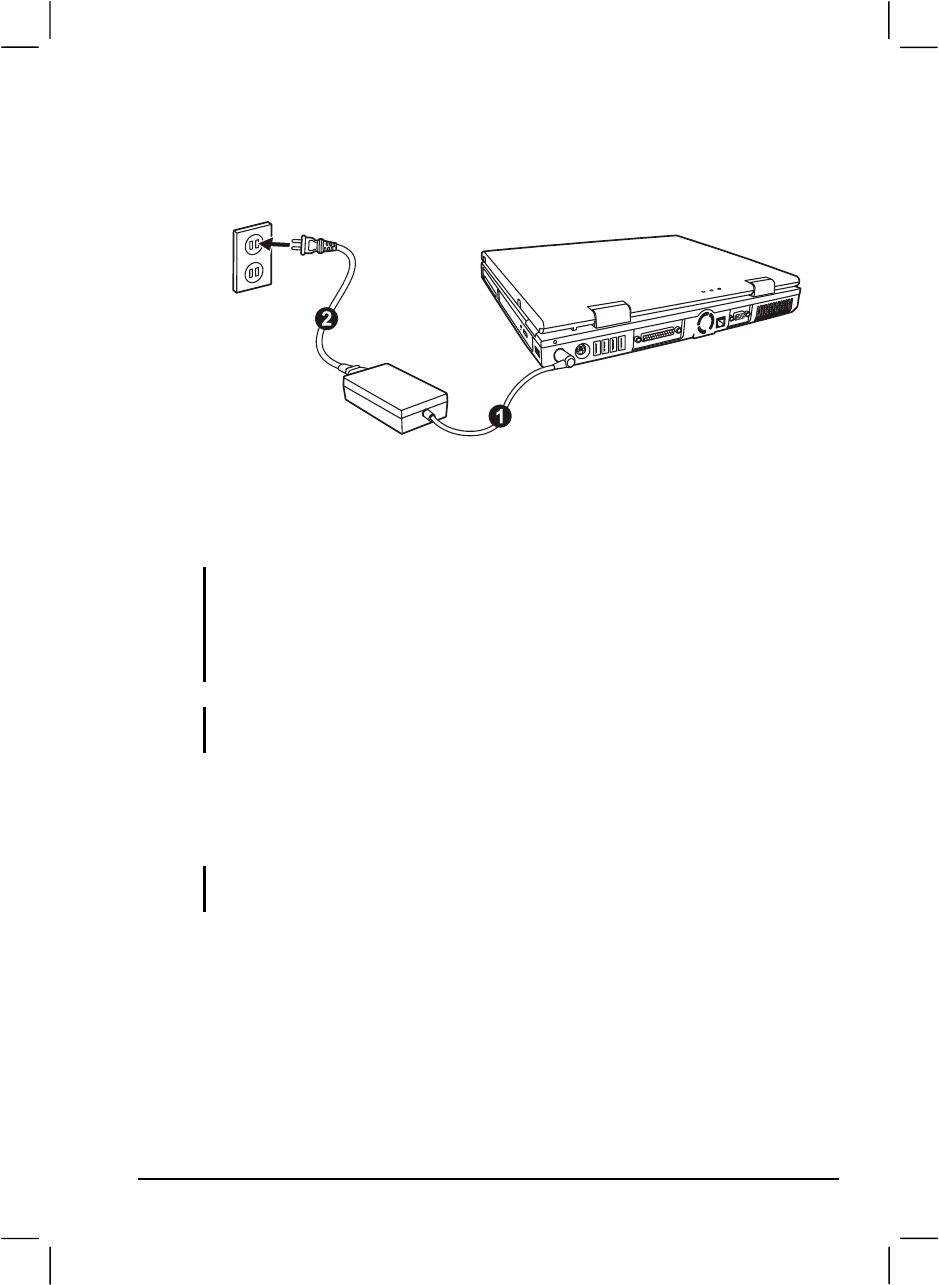
*HWWLQJ6WDUWHG
3. Plug the female end of the AC power cord to the AC adapter and the
male end to an electrical outlet (o).
4. When the AC adapter is connected, power is being supplied from the
electrical outlet to the AC adapter and onto your computer. Now, you
are ready to turn on the computer.
&$87,21
z :KHQ\RXGLVFRQQHFWWKH$&DGDSWHUGLVFRQQHFWIURPWKHHOHFWULFDORXWOHWILUVWDQG
WKHQIURPWKHFRPSXWHU$UHYHUVHSURFHGXUHPD\GDPDJHWKH$&DGDSWHURUWKH
FRPSXWHU
z :KHQXQSOXJJLQJWKHFRQQHFWRUDOZD\VKROGWKHSOXJKHDG1HYHUSXOORQWKHFRUG
127(:KHQWKH$&DGDSWHULVFRQQHFWHGLWDOVRFKDUJHVWKHEDWWHU\SDFN)RU
LQIRUPDWLRQRQXVLQJEDWWHU\SRZHUVHH&KDSWHU
2SHQLQJWKH&RYHU
&$87,21%HJHQWOHZKHQRSHQLQJDQGFORVLQJWKHFRYHU2SHQLQJLWYLJRURXVO\RU
VODPPLQJLWVKXWFRXOGGDPDJHWKHFRPSXWHU
Open the top cover by sliding the cover latch toward the right (n) and
lifting up the cover (o). You can tilt the cover forward or backward for
optimal viewing clarity.
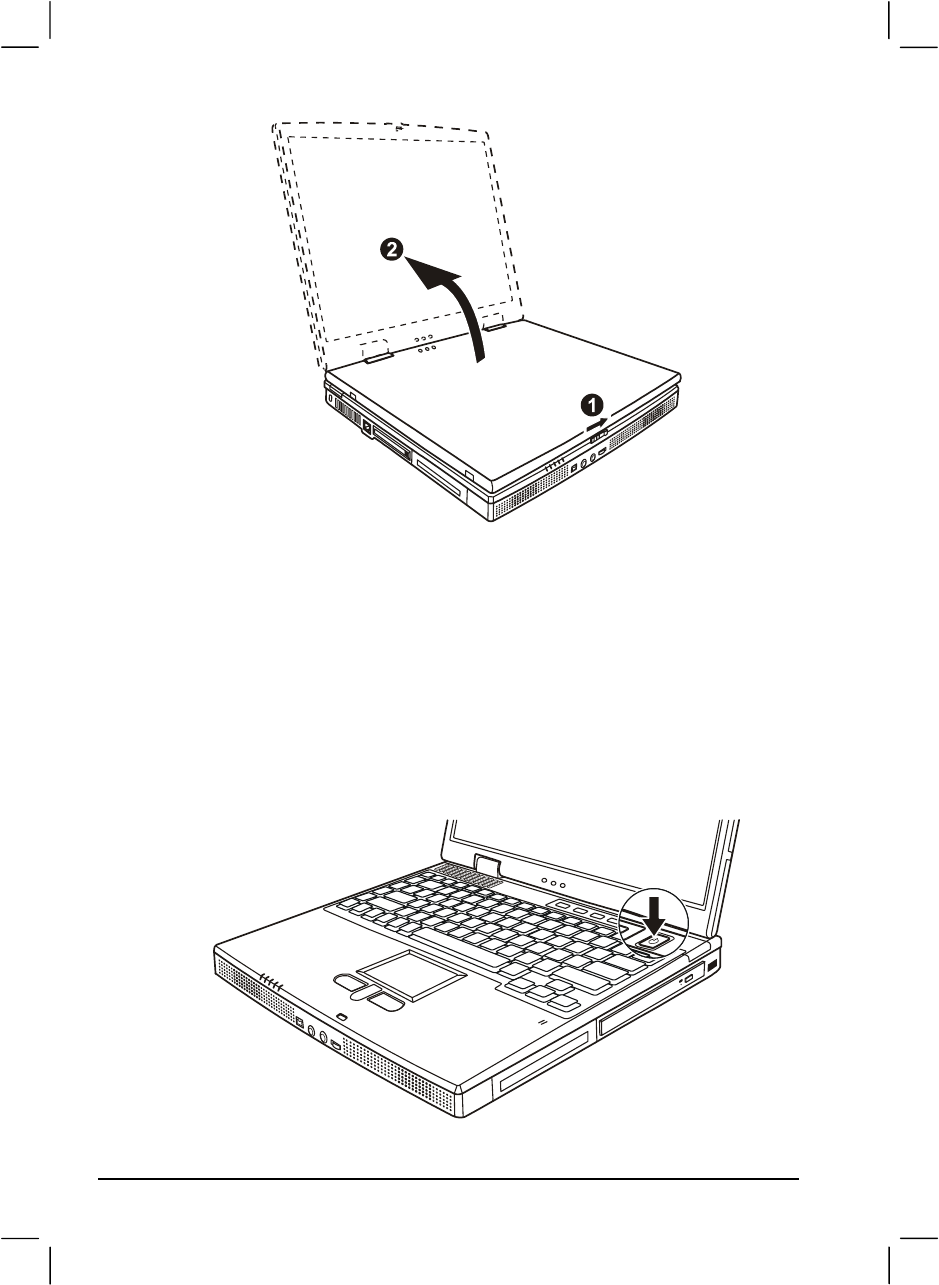
*HWWLQJ6WDUWHG
7XUQLQJ2QDQG2IIWKH&RPSXWHU
7XUQLQJ2Q
1. Make sure the computer is connected to AC power.
2. Press the power button.
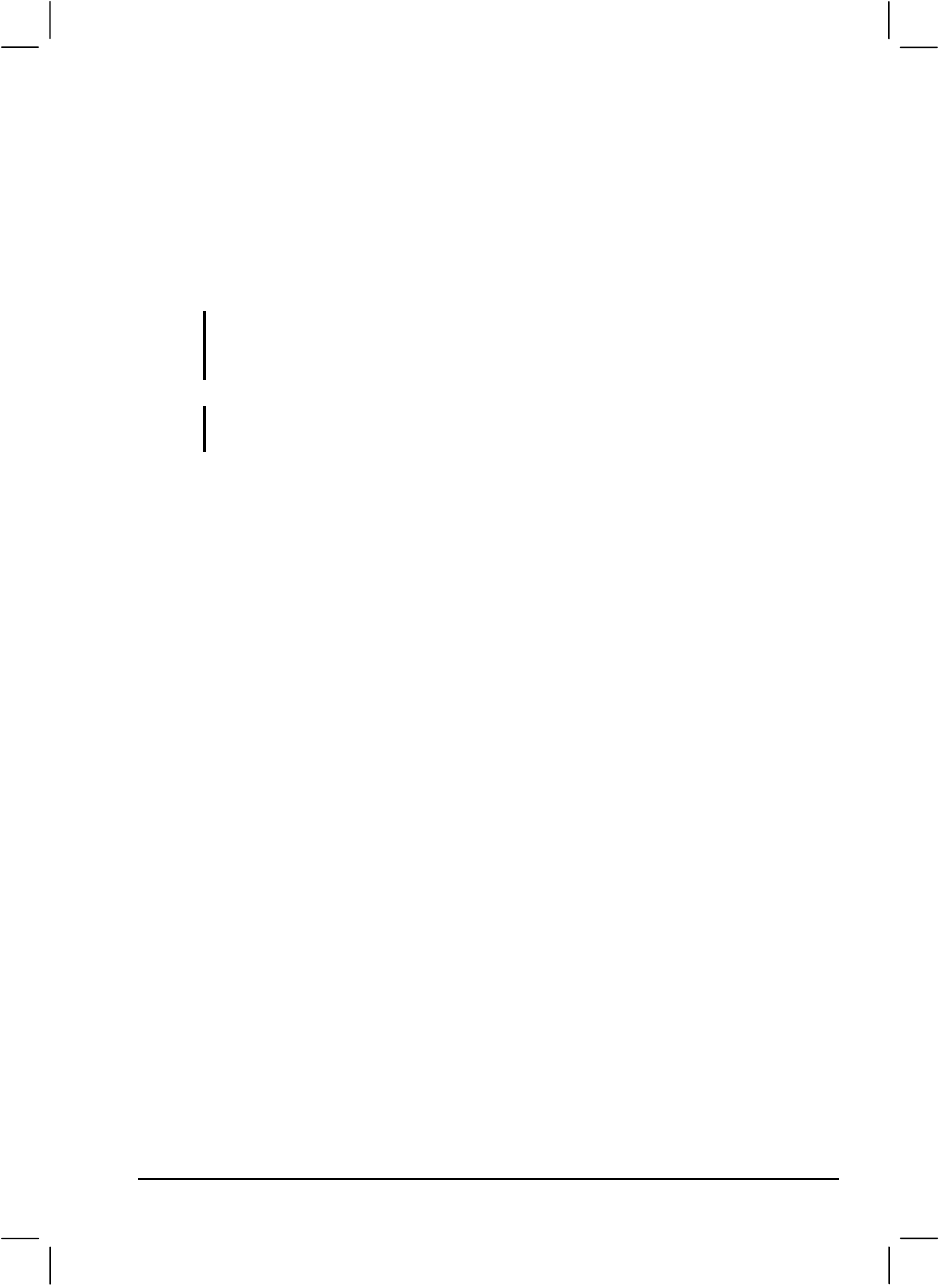
*HWWLQJ6WDUWHG
3. Each time the computer is turned on, it performs a Power-On Self
Test (POST), and the operating system such as Windows should start.
7XUQLQJ2II
To turn off the computer power, use the “Shut Down” command of your
operating system.
127(7KHUHDUHRWKHUZD\V\RXFDQVWRSWKHFRPSXWHUVRWKDW\RXZLOOEHEDFNWR
ZKHUH\RXOHIWRIIZKHQ\RXQH[WWXUQRQWKHFRPSXWHU6HH³6WRSSLQJWKH&RPSXWHU´
LQ&KDSWHUIRULQIRUPDWLRQ
&$87,21,I\RXKDYHWRWXUQWKHFRPSXWHURQDJDLQLPPHGLDWHO\DIWHUWXUQLQJLWRII
ZDLWIRUDWOHDVWILYHVHFRQGV7XUQLQJWKHFRPSXWHURIIDQGRQUDSLGO\FDQGDPDJHLW
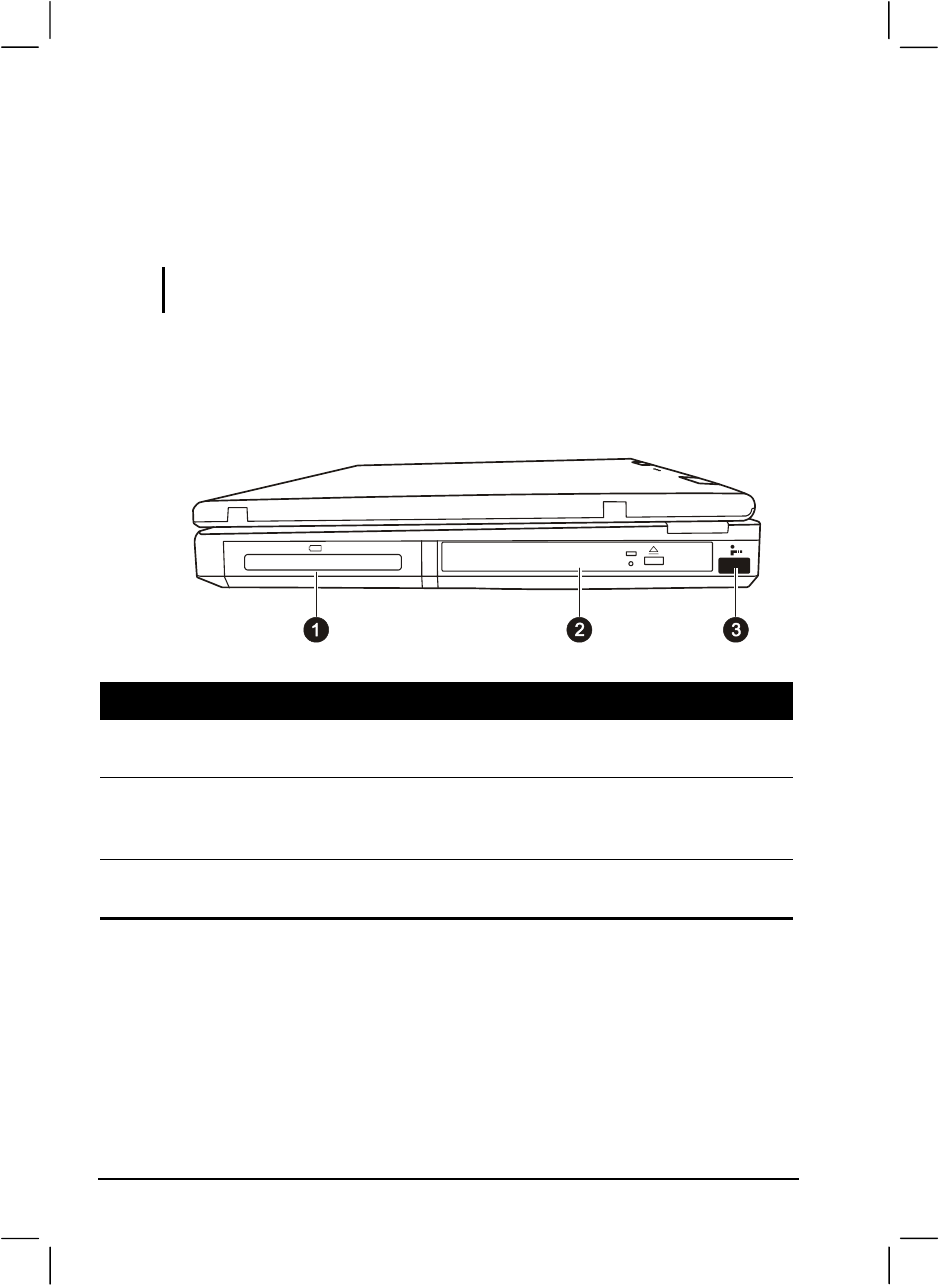
*HWWLQJ6WDUWHG
7DNLQJD/RRNDWWKH&RPSXWHU
This section identifies the external components of the computer and
briefly describes the function of each component.
127('HSHQGLQJRQWKHPRGHO\RXSXUFKDVHGWKHDSSHDUDQFHRI\RXUFRPSXWHUPD\
QRWEHH[DFWO\WKHVDPHDVWKRVHVKRZQLQWKLVPDQXDO
5LJKW6LGH&RPSRQHQWV
Ref Component Description See Also
nBattery Pack Supplies power to your computer when external
power is not connected.
P. 3-3
oCD/DVD/
CD-RW/
Combo Drive
Accepts a compact disc (CD) for installing or
loading software, accessing data, and playing
music/video.
P. 2-17
pIR Port Connects an IrDA-compliant device for
wireless data transfer.
P. 4-7
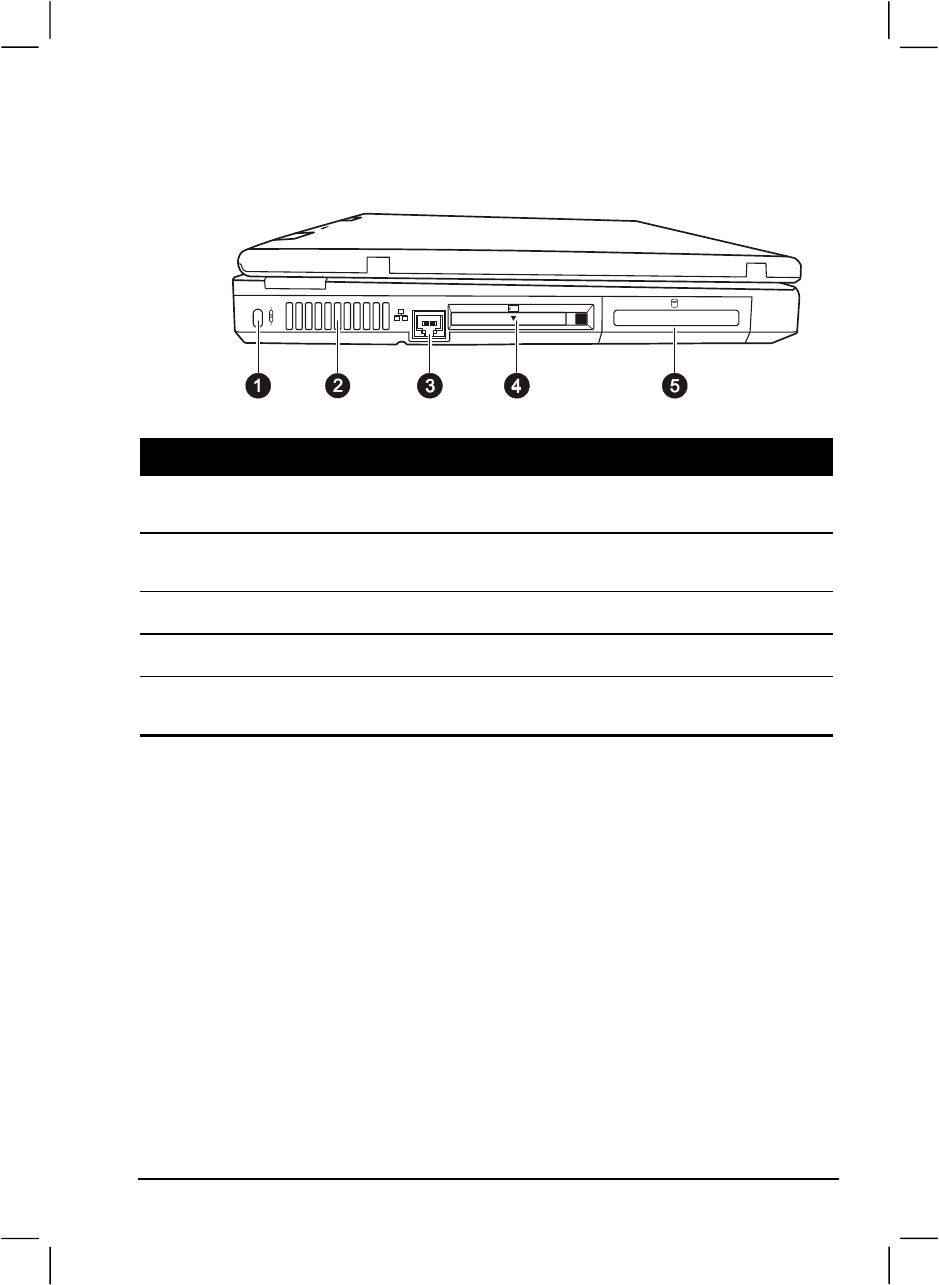
*HWWLQJ6WDUWHG
/HIW6LGH&RPSRQHQWV
Ref Component Description See Also
nKensington Lock Locks the computer to a stationery object for
security.
P. 7-2
oVentilation
Openings
Do not cover or block the ventilation openings
for air circulation thus preventing overheating.
pRJ-45 Connector Connects the LAN cable. P. 2-24
qPC Card Slot Accepts a PC Card for additional functions. P. 4-10
rHard Disk Drive Inside is the hard disk drive of your computer,
often referred to as drive C.
P. 2-16
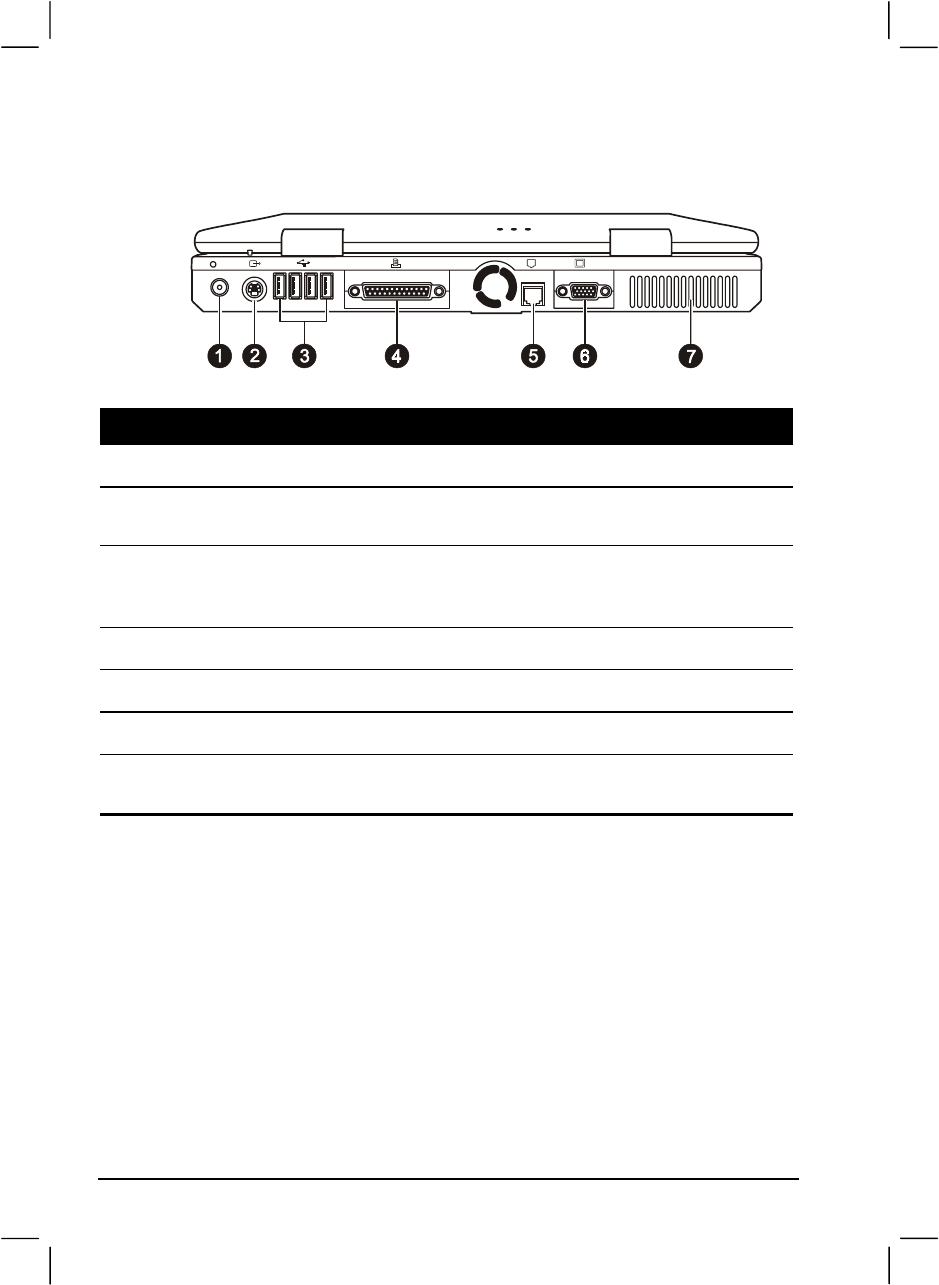
*HWWLQJ6WDUWHG
5HDU&RPSRQHQWV
Ref Component Description See Also
nPower Connector Connects the AC adapter. P. 1-2
oS-Video
Connector
Connects an external video device, such as a
TV, supporting S-video input.
P. 4-3
pUSB Ports Each of the four ports connects a USB device,
such as a floppy disk drive, printer, digital
camera, joystick, and more.
P. 4-6
qParallel Port Connects a parallel device, such as a printer. P. 4-5
rRJ-11 Connector Connects the telephone line. P. 2-23
sVGA Port Connects an external monitor. P. 4-2
tVentilation
Openings
Do not cover or block the ventilation openings
for air circulation thus preventing overheating.
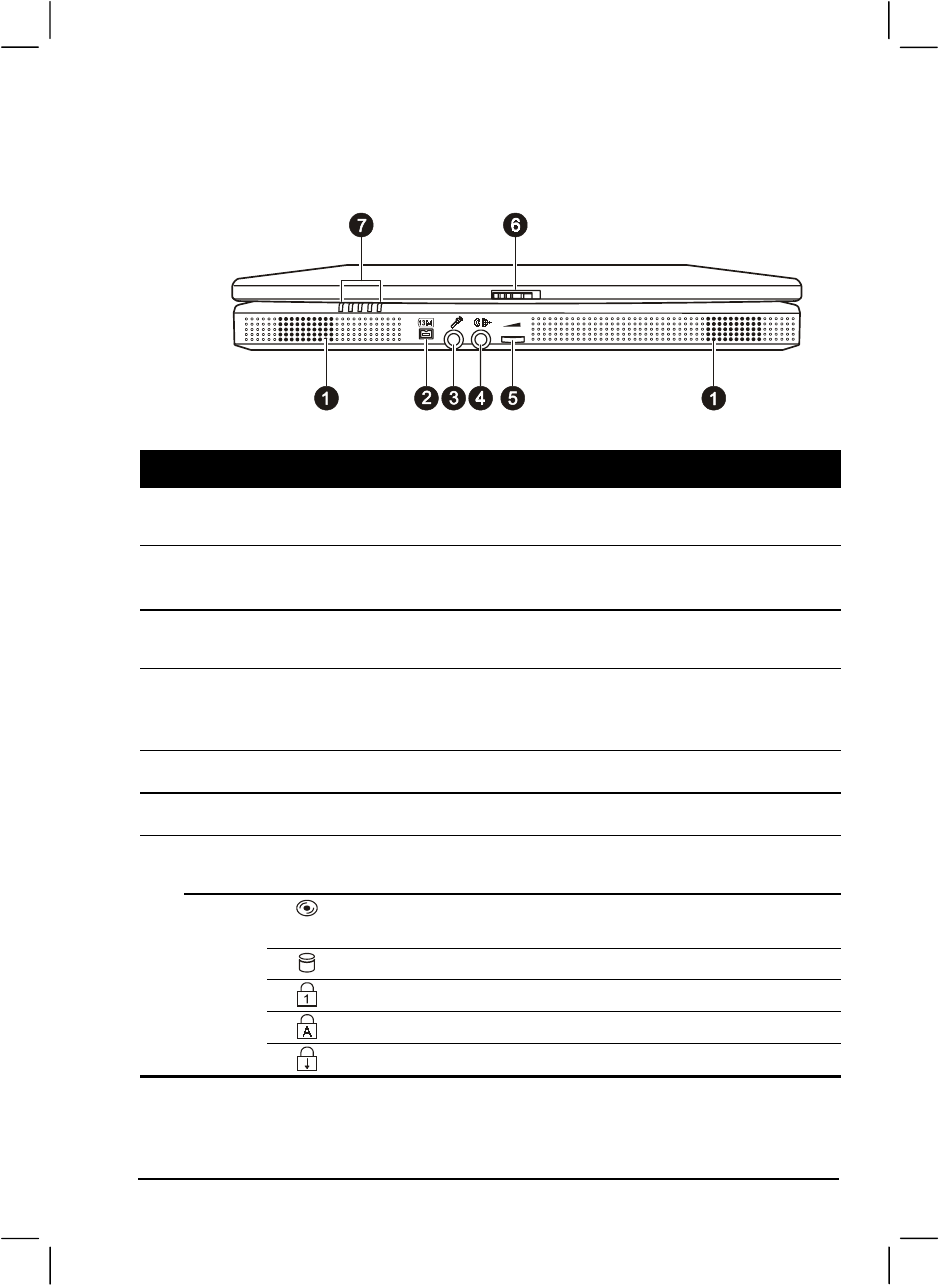
*HWWLQJ6WDUWHG
)URQW&RPSRQHQWV
Ref Component Description See Also
nStereo Speaker
Set
Sends out sound and voice from the computer. P. 2-21
oIEEE 1394 Port Connects a 1394 device such as a scanner,
printer, DVCAM, VCR, and more.
P. 4-9
pMicrophone
Connector
Connects an external microphone. P. 2-21
qAudio Output
Connector
Connects a set of headphones, external
speakers with amplifier, or an audio recording
device.
P. 2-22
rVolume Control Adjusts the sound volume of the computer. P. 2-21
sTop Cover Latch Locks the top cover. P. 1-3
Device
Indicators
Show the current status of the computer’s
devices.
CD/DVD/CD-RW/Combo drive in-use
indicator
P. 2-18
Hard disk drive in-use indicator P. 2-16
Num Lock indicator P. 2-4
Caps Lock indicator P. 2-5
t
Scroll Lock indicator P. 2-5
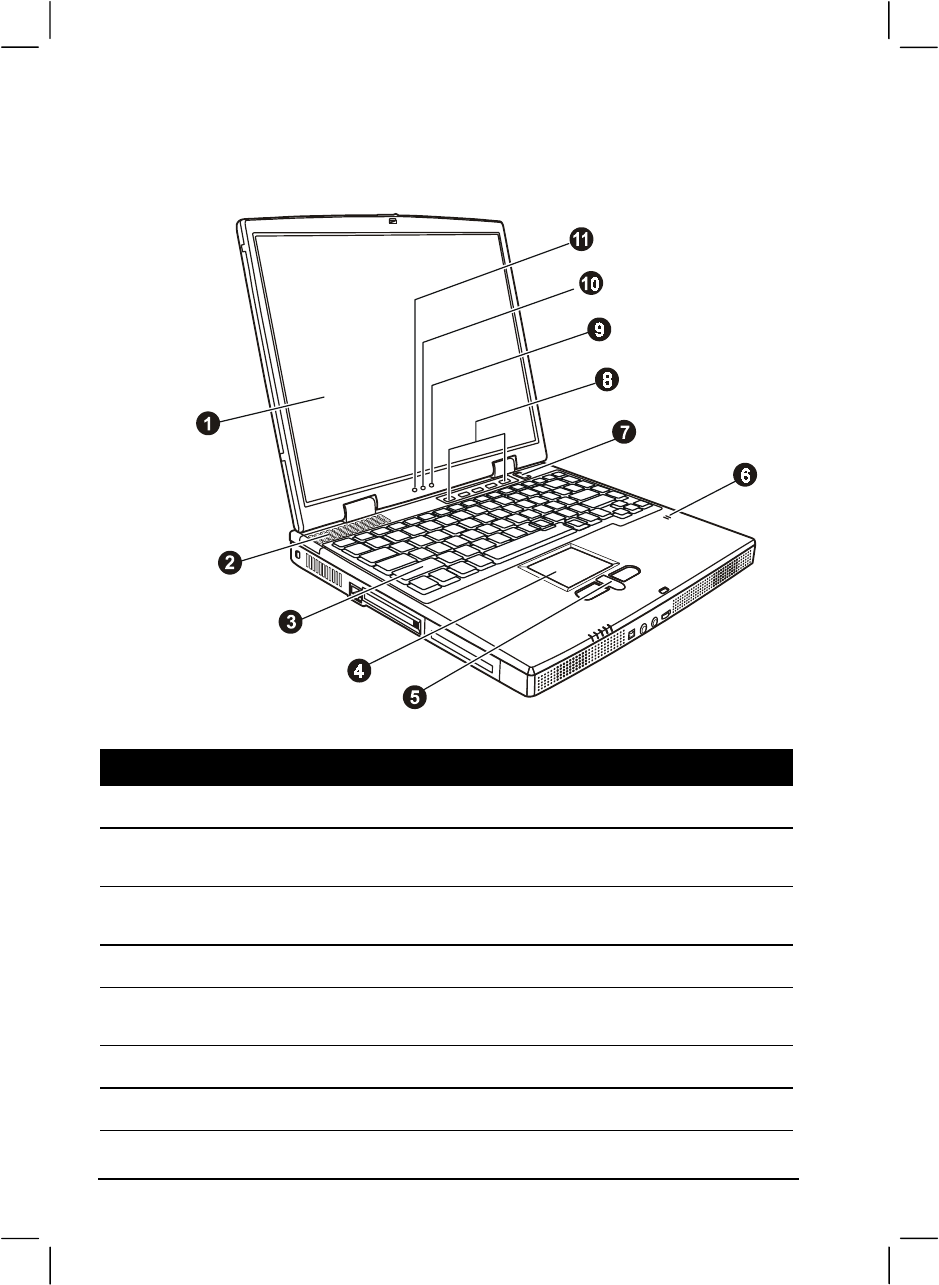
*HWWLQJ6WDUWHG
7RSRSHQ&RPSRQHQWV
Ref Component Description See Also
nLCD Screen Displays the output of the computer. P. 2-19
oVentilation
Openings
Do not cover or block the ventilation openings
for air circulation thus preventing overheating.
pKeyboard Serves as the data input device of the
computer.
P. 2-4
qTouchpad Serves as the pointing device of the computer. P. 2-10
rScroll Button Allows you to move up and down in the
working area on the screen.
P. 2-11
sMicrophone Receives sound and voice for the computer. P. 2-21
tPower Button Turns the computer power ON and OFF. P. 1-4
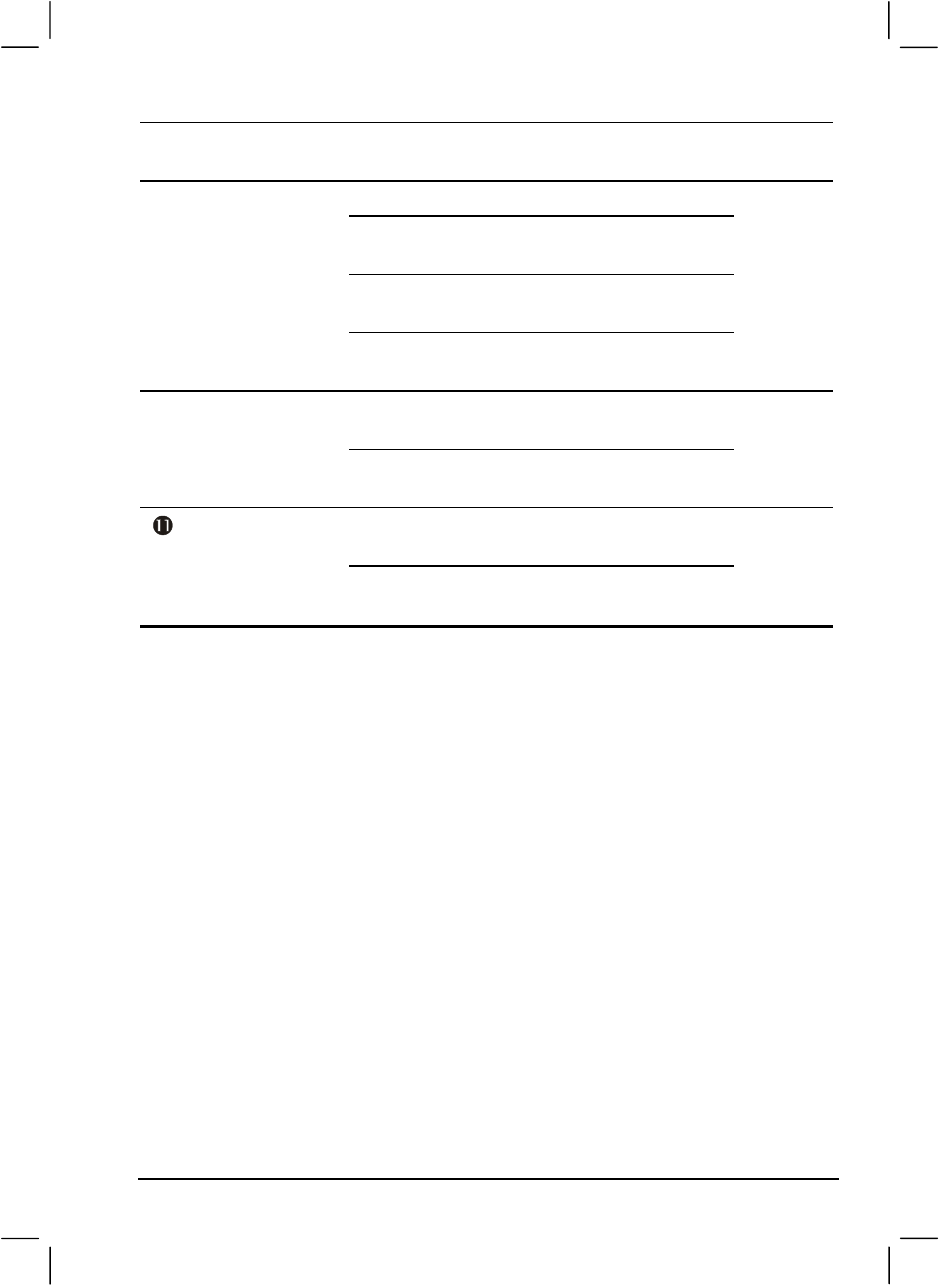
*HWWLQJ6WDUWHG
uEasy Start
Buttons
Each of the five buttons provides a quick way
to launch a specific program.
P. 2-13
Glows green when the battery is fully charged.
Glows orange when the battery is being
charged.
Blinks red when the battery is almost
completely discharged.
vBattery Charge
Indicator
Blinks orange when the battery is in an
abnormal state.
P. 3-3
Glows green when the computer is using
battery power.
wBattery Power
Indicator
Blinks green when the computer, using battery
power, is in Standby mode.
Glows green when the computer is using AC
power.
AC Power
Indicator
Blinks green when the computer, using AC
power, is in Standby mode.
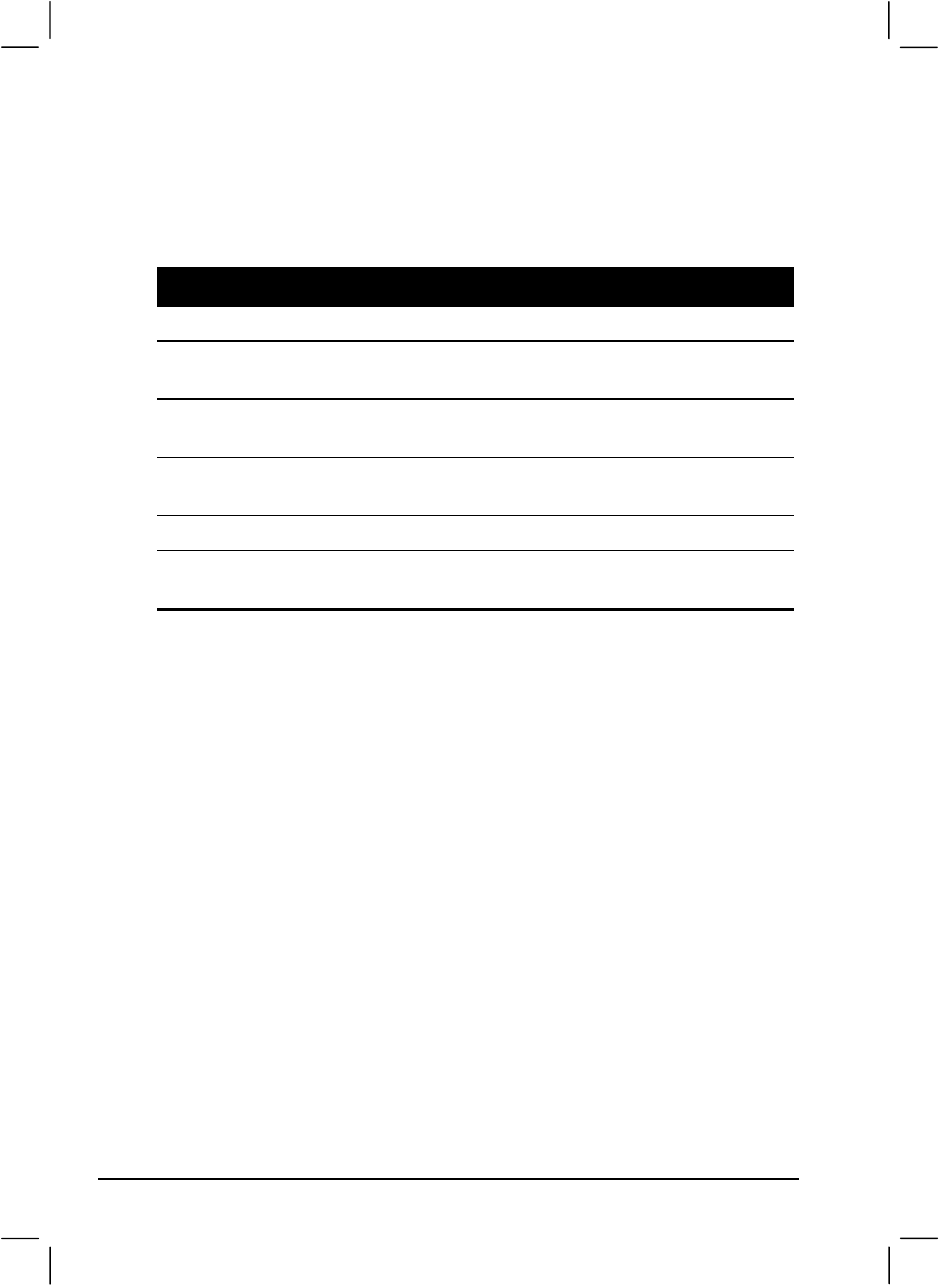
*HWWLQJ6WDUWHG
:KHUHWR*RIURP+HUH
As your computer is ready for operation, you may want to do any of the
following now:
For this purpose…Do this…
To know more about the computer…Go on to the next chapter.
To install the operating system if your
dealer has not already done so…
See the operating system manual.
To know more about the operating
system…
Read the operating system manual.
To install the drivers if your dealer has
not already done so…
See Chapter 6.
To set a power-on password…See “Security Menu” in Chapter 5.
To charge the battery pack for the first
time…
See “Charging the Battery Pack” in
Chapter 3.

CHAPTER 2
Operating Your Computer
This chapter provides information about the use of the computer.
If you are new to computers, reading this chapter will help you learn the
operating basics. If you are already a computer user but are new to
notebook computers, you may choose to read only the parts containing
information unique to your computer.
Described in this chapter are the operating basics of these components:
z Keyboard
z Touchpad
z Floppy disk drive
z Hard disk drive
z CD/DVD drive
And these features:
z Starting and stopping the computer
z Easy Start buttons
z Video features
z Audio features
z Communication features

2SHUDWLQJ<RXU&RPSXWHU
6WDUWLQJDQG6WRSSLQJWKH&RPSXWHU
There are a number of ways to start and stop the computer.
6WDUWLQJWKH&RPSXWHU
You always start the computer using the power button.
A computer starts up with an operating system (OS) existing on the
storage device such as the hard disk and floppy disk. The computer will
automatically load the OS after you turn it on. This process is called
booting.
127($QRSHUDWLQJV\VWHPLVWKHSODWIRUPIRUDOO\RXUVRIWZDUHDSSOLFDWLRQSURJUDPVWR
UXQRQ7KHPRVWZLGHO\XVHGRSHUDWLQJV\VWHPWRGD\LV0LFURVRIW:LQGRZV
6WRSSLQJWKH&RPSXWHU
When you finish a working session, you can stop the computer by turning
off the power or leaving the computer in Standby or Hibernation mode:
To stop in
this mode…
Do this…To start up or
resume again
Off Follow the shutdown procedure of your
operating system. This can prevent loss of
unsaved data or damage to your software
programs.
If the system is locked up because of
hardware or software problems, press the
power button to turn off the computer.
Press the power
button.
Standby Depending on your settings in Windows,
you can put the computer in Standby
mode by:
•Closing the display cover
•Pressing 3+
•Pressing the power button
Press any key.

2SHUDWLQJ<RXU&RPSXWHU
Hibernation Depending on your settings in Windows,
you can put the computer in Hibernation
mode by:
•Closing the display cover
•Pressing 3+
•Pressing the power button
Press the power
button.
If you choose to stop in Standby or Hibernation mode, you can return to
where you left off the next time you start up the computer. (See “Power
Management” in Chapter 3 for more information.)

2SHUDWLQJ<RXU&RPSXWHU
8VLQJWKH.H\ERDUG
Your keyboard has all the standard functions of a full-sized computer
keyboard plus an )Q key added for specific functions.
The standard functions of the keyboard can be further divided into four
major categories:
z Typewriter keys
z Cursor-control keys
z Numeric keys
z Function keys
7\SHZULWHU.H\V
Typewriter keys are similar to the keys on a typewriter. Several keys are
added such as the &WUO, $OW, (VF, and lock keys for special purposes. When
the lock keys are pressed, their corresponding indicators light up.
Key Description
The Control key is normally used in combination with other keys for
program-specific functions.
The Alternate key is normally used in combination with other keys
for program-specific functions.
The Escape key is usually used for stopping a process. Examples are
exiting a program and canceling a command. The function depends
on the program you are using.
The Shift key is used with alphabet letter keys to produce uppercase
letters when typing. It is also used in combination with other keys for
program-specific functions.
The Backspace key moves the cursor left one space and deletes the
character in that space.
Pressing )Q and this key toggles the Num Lock on and off. When on
( light on), the Num Lock activates the numeric keys.
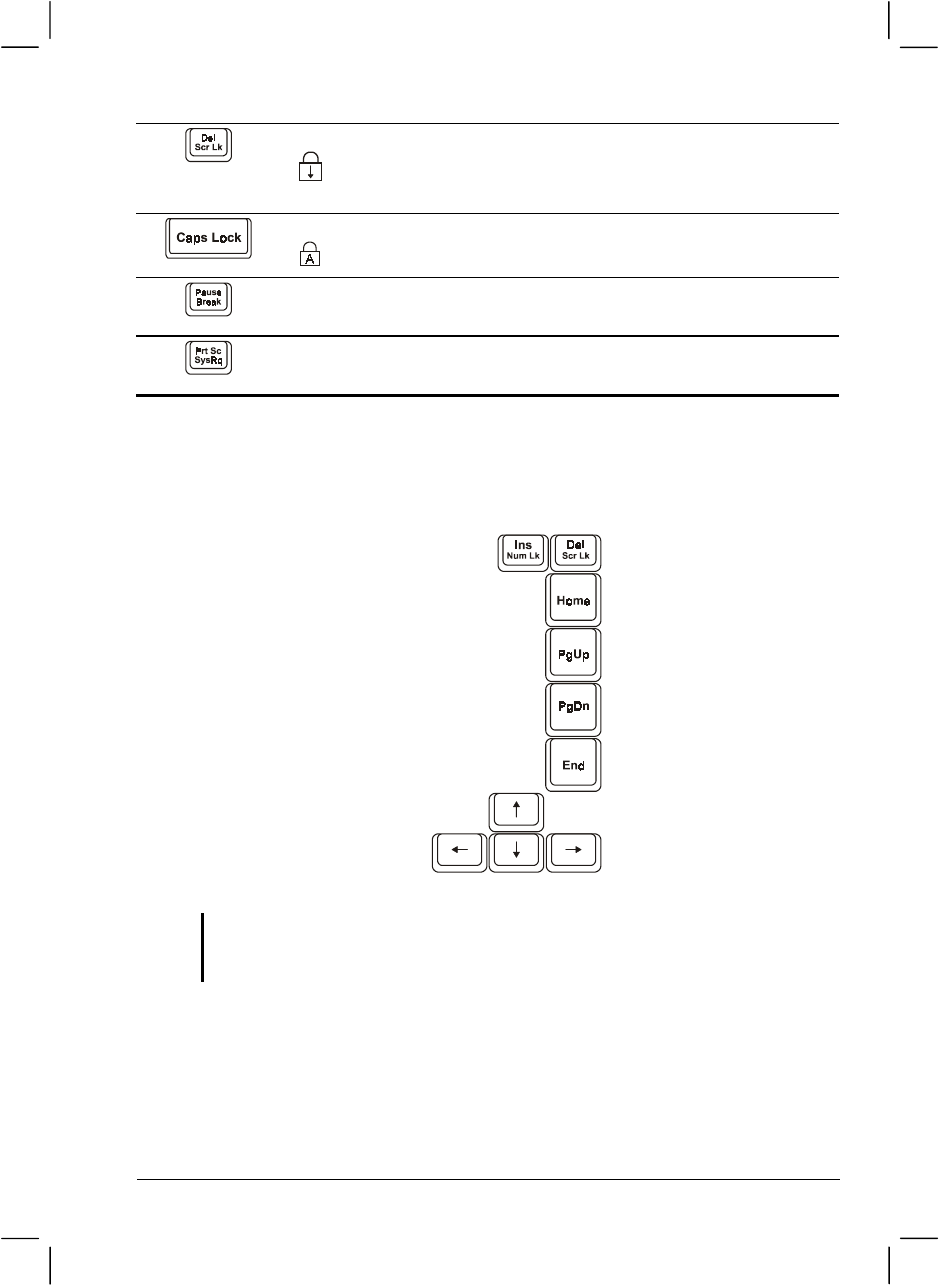
2SHUDWLQJ<RXU&RPSXWHU
Pressing )Q and this key toggles Scroll Lock on and off. When on
( light on), the screen moves one line up or down when you press
↑ or ↓ arrow key. Scroll Lock does not work for all programs.
Pressing this key toggles the Caps Lock on and off. When on
( light on), the Caps Lock keeps the letter keys in uppercase.
The Pause key temporarily stops screen scrolling. Scroll Lock does
not work for all programs.
The Print Screen key prints the displayed screen. Print screen does
not work for all programs.
&XUVRU&RQWURO.H\V
127(7KHZRUG³FXUVRU´UHIHUVWRWKHLQGLFDWRURQWKHVFUHHQWKDWOHWV\RXNQRZ
H[DFWO\ZKHUHRQ\RXUVFUHHQDQ\WKLQJ\RXW\SHZLOODSSHDU,WFDQWDNHWKHIRUPRID
YHUWLFDORUKRUL]RQWDOOLQHDEORFNRURQHRIPDQ\RWKHUVKDSHV
Cursor-control keys are generally used for editing purposes. They are:

2SHUDWLQJ<RXU&RPSXWHU
Key Description
Moves the cursor left one space.
Moves the cursor right one space.
Moves the cursor up one line.
Moves the cursor down one line.
Moves the page up.
Moves the page down.
Moves the cursor to the beginning of the line or document.
Moves the cursor to the end of the line or document.
Switches typing between insert and overtype modes. Insert mode
means any character typed will be inserted to the current cursor
position; overtype mode means any character typed will overwrite the
text in the current cursor position.
Deletes the character to the right of the cursor and moves the
following text left one space.
1XPHULF.H\SDG
A 15-key numeric keypad is embedded in the typewriter keys as shown
below:

2SHUDWLQJ<RXU&RPSXWHU
Numeric keys facilitate entering of numbers and calculations. When Num
Lock is on, the numeric keys are activated; meaning you can use these keys
to enter numerals.
127(
z :KHQWKHQXPHULFNH\SDGLVDFWLYDWHGDQG\RXQHHGWRW\SHWKH(QJOLVKOHWWHULQWKH
NH\SDGDUHD\RXFDQHLWKHUWXUQ1XP/RFNRIIRU\RXFDQSUHVV3DQGWKHQWKH
OHWWHUZLWKRXWWXUQLQJ1XP/RFNRII
z 6RPHVRIWZDUHPD\QRWEHDEOHWRXVHWKHQXPHULFNH\SDGRQWKHFRPSXWHU,IVR
XVHWKHQXPHULFNH\SDGRQDQH[WHUQDONH\ERDUGLQVWHDG
(XUR6\PERO
If your Windows supports the Euro dollar sign , you can press the sign
on the US and UK keyboards.
z To press the Euro sign on a United States-International keyboard,
hold down either of the $OWkeys and press 5 (which has an Euro sign
on it).
z To press the Euro sign on a United States 101 keyboard, hold down
either of the $OW keys and type 0128 on the numeric keypad of your
keyboard.
z To press the Euro sign on an UK keyboard, hold down the $OW*U key
and press 4 (which has an Euro sign on it).
:LQGRZV.H\V
The keyboard has two keys that perform Windows-specific functions:
á Windows Logo key and Application key.
The á Windows Logo key opens the Start menu and performs
software-specific functions when used in combination with other keys.
The Application key usually has the same effect as a right mouse click.
(See your Windows manual for more information.)

2SHUDWLQJ<RXU&RPSXWHU
)XQFWLRQ.H\V
On the top row of the keys are the function keys: ) to ). Function keys
are multi-purpose keys that perform functions defined by individual
programs.
Hot key functions are assigned to ), ), ), ), ), and ) by your
computer. (See “Hot Keys” later in this chapter for information.)
)Q.H\
The )Q key, at the lower left corner of the keyboard, is used with another
key to perform the alternative function of a key. The letter “Fn” and the
alternative functions are identified by the color of blue on the keytop. To
perform a desired function, first press and hold )Q, then press the other
key.
+RW.H\V
Hot keys refer to a combination of keys that can be pressed any time to
activate special functions of the computer. Most hot keys operate in a
cyclic way. Each time a hot key combination is pressed, it shifts the
corresponding function to the other or next choice.
You can easily identify the hot keys with the icons imprinted on the
keytop. The hot keys are described below.
Key Description
Switches the display output to one of the following five when an
external CRT monitor or a TV set is connected.
LCD & CRT TV TV & CRT
CRT LCD
NOTE: If the display mode is set to 256 colors or lower, or in
DOS mode, there will be only two modes for selecting: CRT
only and LCD & CRT.
Decreases the LCD brightness.

2SHUDWLQJ<RXU&RPSXWHU
Increases the LCD brightness.
Switches Battery Low beep on and off.
Switches LCD on and off.
Serves as the sleep button that you can define with Windows’
Power Management. (See the “Power Management” in
Chapter 3.)
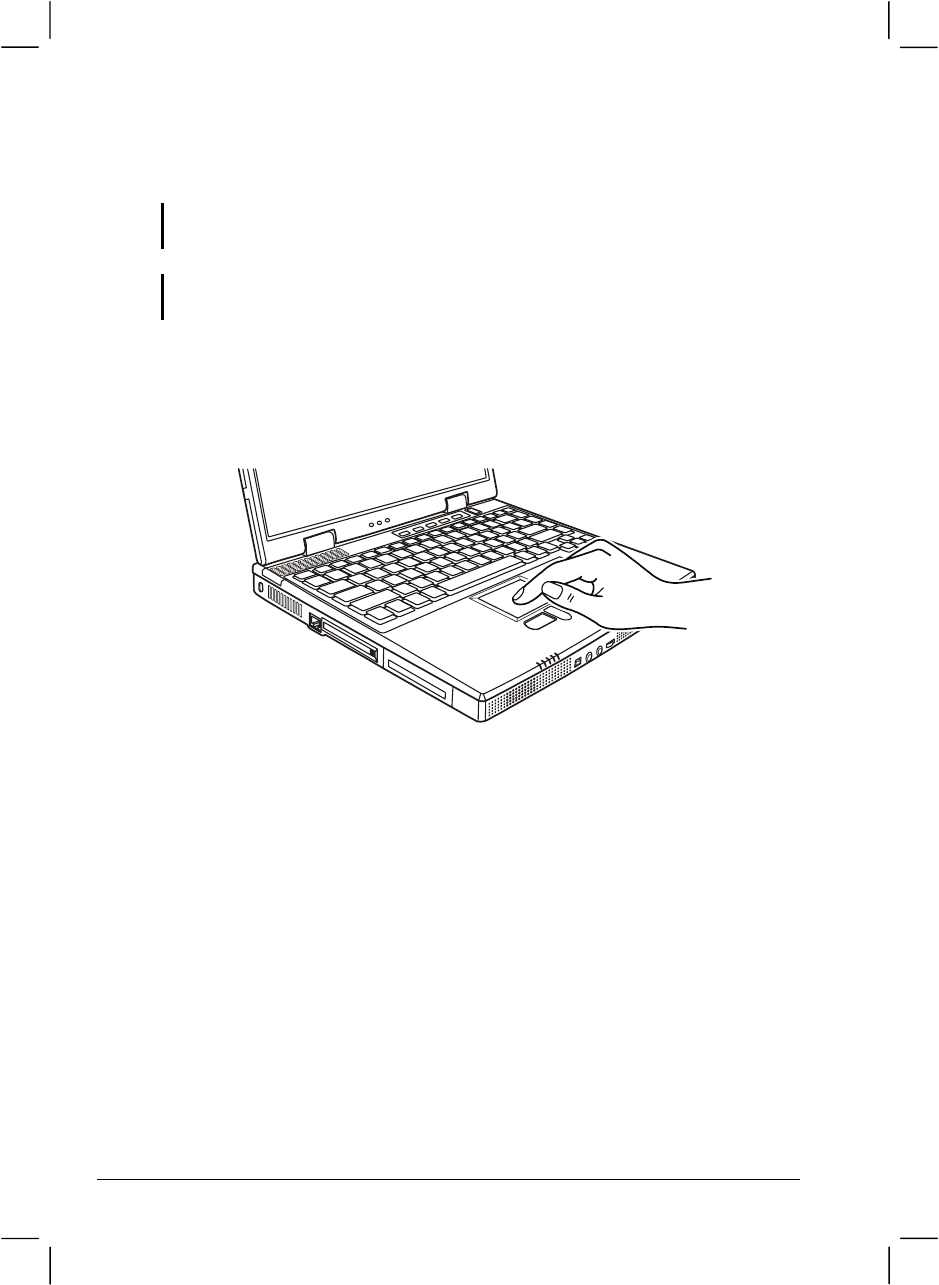
2SHUDWLQJ<RXU&RPSXWHU
8VLQJWKH7RXFKSDG
&$87,21'RQRWXVHDVKDUSREMHFWVXFKDVDSHQRQWKHWRXFKSDG'RLQJVRPD\
GDPDJHWKHWRXFKSDGVXUIDFH
127()RURSWLPDOSHUIRUPDQFHRIWKHWRXFKSDGNHHS\RXUILQJHUVDQGWKHSDGVFOHDQ
DQGGU\:KHQWDSSLQJRQWKHSDGWDSOLJKWO\'RQRWXVHH[FHVVLYHIRUFH
The touchpad is a pointing device that allows you to communicate with
the computer by controlling the location of the pointer on the screen and
making selection with the buttons.
The touchpad consists of a rectangular pad and two buttons. To use the
touchpad, place your forefinger or thumb on the pad. The rectangular pad
acts like a miniature duplicate of your display. As you slide your fingertip
across the pad, the pointer (also called cursor) on the screen moves
accordingly. When your finger reaches the edge of the pad, simply
relocate yourself by lifting the finger and placing it on the other side of
the pad.
Here are some common terms that you should know when using the
touchpad:

2SHUDWLQJ<RXU&RPSXWHU
Term Action
Point Move your finger on the pad until the cursor points to the
selection on the screen.
Click Press and release the left button.
-or-
Tap gently anywhere on the pad.
Double-click Press and release the left button twice in quick succession.
-or-
Tap twice on the pad rapidly.
Drag and
drop
Press and hold the left button, then move your finger until
you reach your destination (drag). Finally, release the
button (drop) when you finish dragging your selection to
the destination. The object will drop into the new location.
-or-
Gently tap twice on the pad and on the second tap, keep
your finger in contact with the pad. Then, move your
finger across the pad to drag the selected object to your
destination. When you lift your finger from the pad, the
selected object will drop into place.
Scroll To scroll is to move up and down or left and right in the
working area on the screen.
The scroll button located between the two buttons under
the touchpad can be used to move vertically in a
convenient way. Press the upper part of the scroll button to
move up and the lower part of the scroll button to move
down.
-or-
To move vertically, place your finger on the right edge of
the pad and slide your finger up and down along the edge
To move horizontally, place your finger on the bottom
edge of the pad and slide your finger left and right.
This function works only after you install the touchpad
driver supplied with the computer and it may not work for
all applications.
TABLE NOTE: If you swap the left and right buttons, “tapping” on the
touchpad as an alternative method of pressing the left button will no longer be
valid.

2SHUDWLQJ<RXU&RPSXWHU
&RQILJXULQJWKH7RXFKSDG
You may want to configure the touchpad to suit your needs. For example,
if you are a left-handed user, you can swap the two buttons so that you can
use the right button as the left button and vise versa. You can also change
the size of the on-screen pointer, the speed of the pointer, and so on.
To configure the touchpad, you can use the standard Microsoft or IBM
PS/2 driver if you are using Windows. However, you can install the
touchpad driver supplied with your computer to take advantage of more
powerful features. (For information on installing the driver, see “How to
Use the CD” in Chapter 6.)
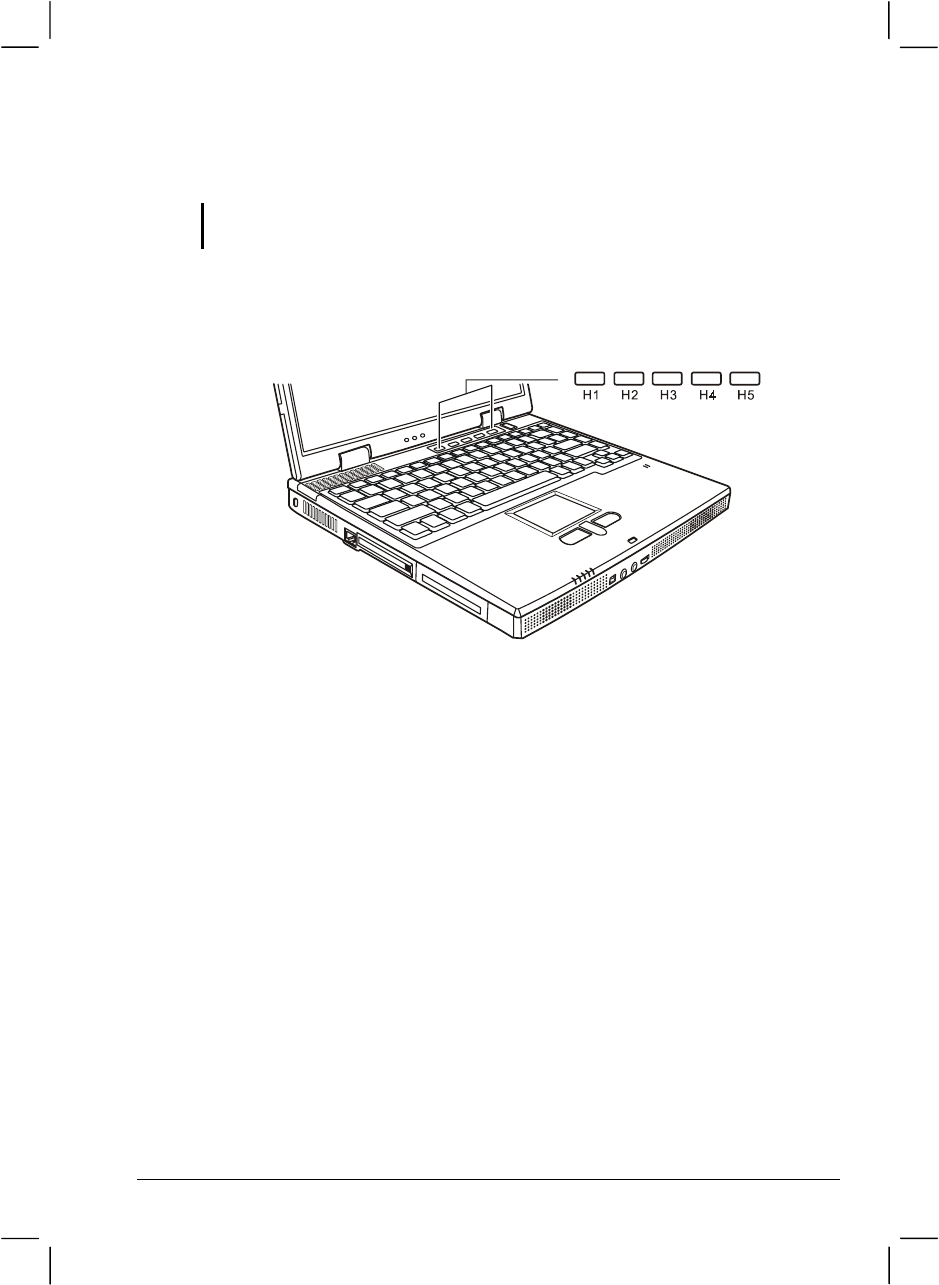
2SHUDWLQJ<RXU&RPSXWHU
8VLQJ(DV\6WDUW%XWWRQV
127(7KH(DV\6WDUWEXWWRQVZRUNRQO\IRU:LQGRZV0H:LQGRZVDQG
:LQGRZV;3
The Easy Start buttons are five user-definable buttons located above the
keyboard.
The five buttons allow you to launch your frequently used software
programs with one single press of a button.
For information on defining the five buttons, see “Easy Start Button
Utility” in Chapter 6.
Easy Start Buttons
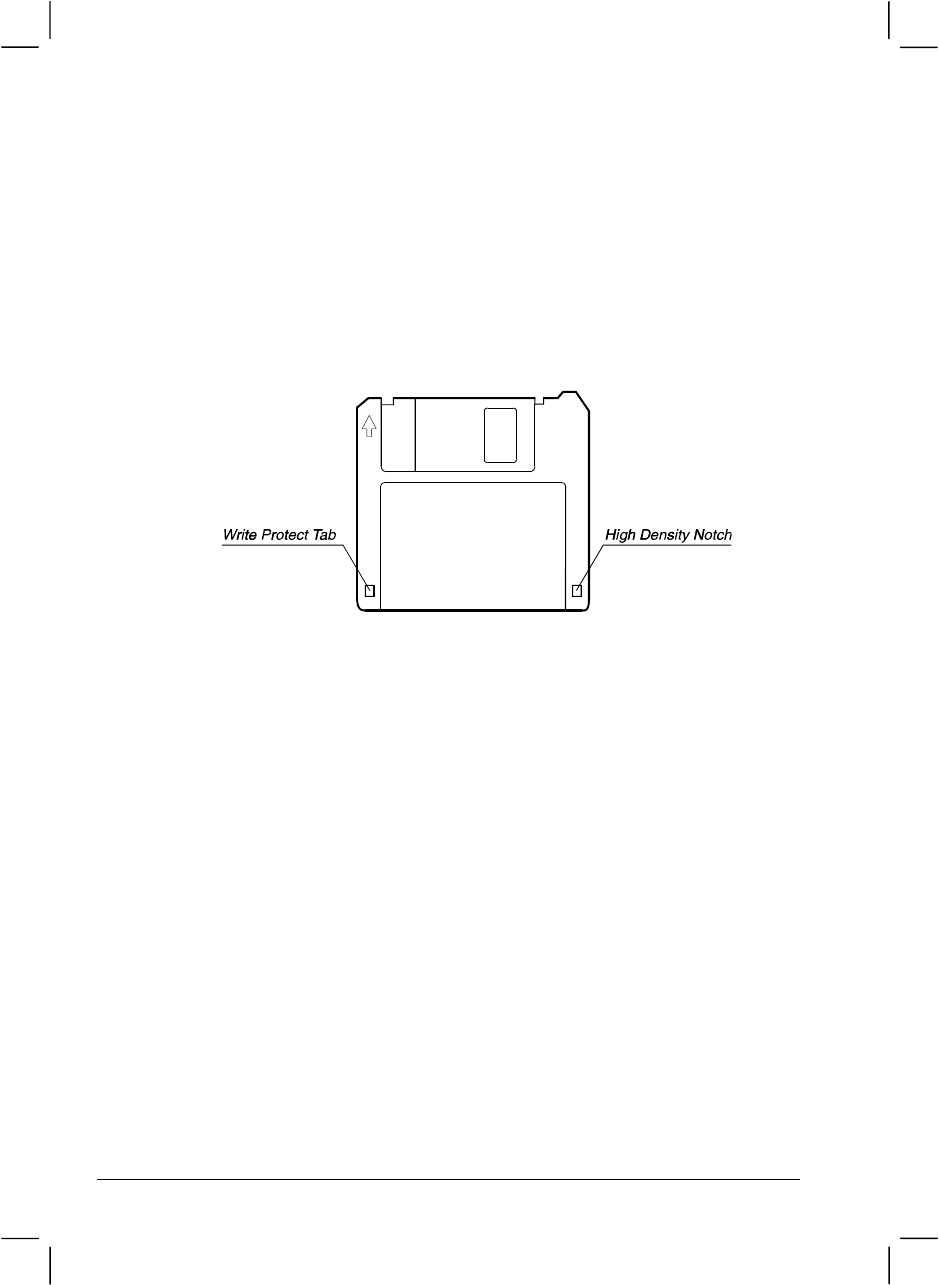
2SHUDWLQJ<RXU&RPSXWHU
8VLQJWKH)ORSS\'LVN'ULYH
Depending on your model, an external floppy disk drive may be supplied
with your computer. The floppy disk drive is referred to as drive A.
A floppy disk drive allows you to install new programs into your
computer, or to store information on a removable floppy disk so you can
transfer information from one computer to another.
The floppy disk drive is a high-density 3.5-inch one, which can read and
write to either double-density (2DD) 720-KB floppy disks or high-
density (2HD) 1.44-MB floppy disks. Notice that both types of floppy
disk have an arrow imprinted on the front upper left corner, and a sliding
write-protect tab on the bottom left corner, as illustrated above. When
opened, the write-protect tab prevents data from being written to, or
erased from the floppy disk.
&RQQHFWLQJWKH)ORSS\'LVN'ULYH
To connect the floppy disk drive to the computer, connect the floppy disk
drive cable into any of the USB ports of the computer. Make sure to let
the USB mark face left when connecting the cable to the computer.
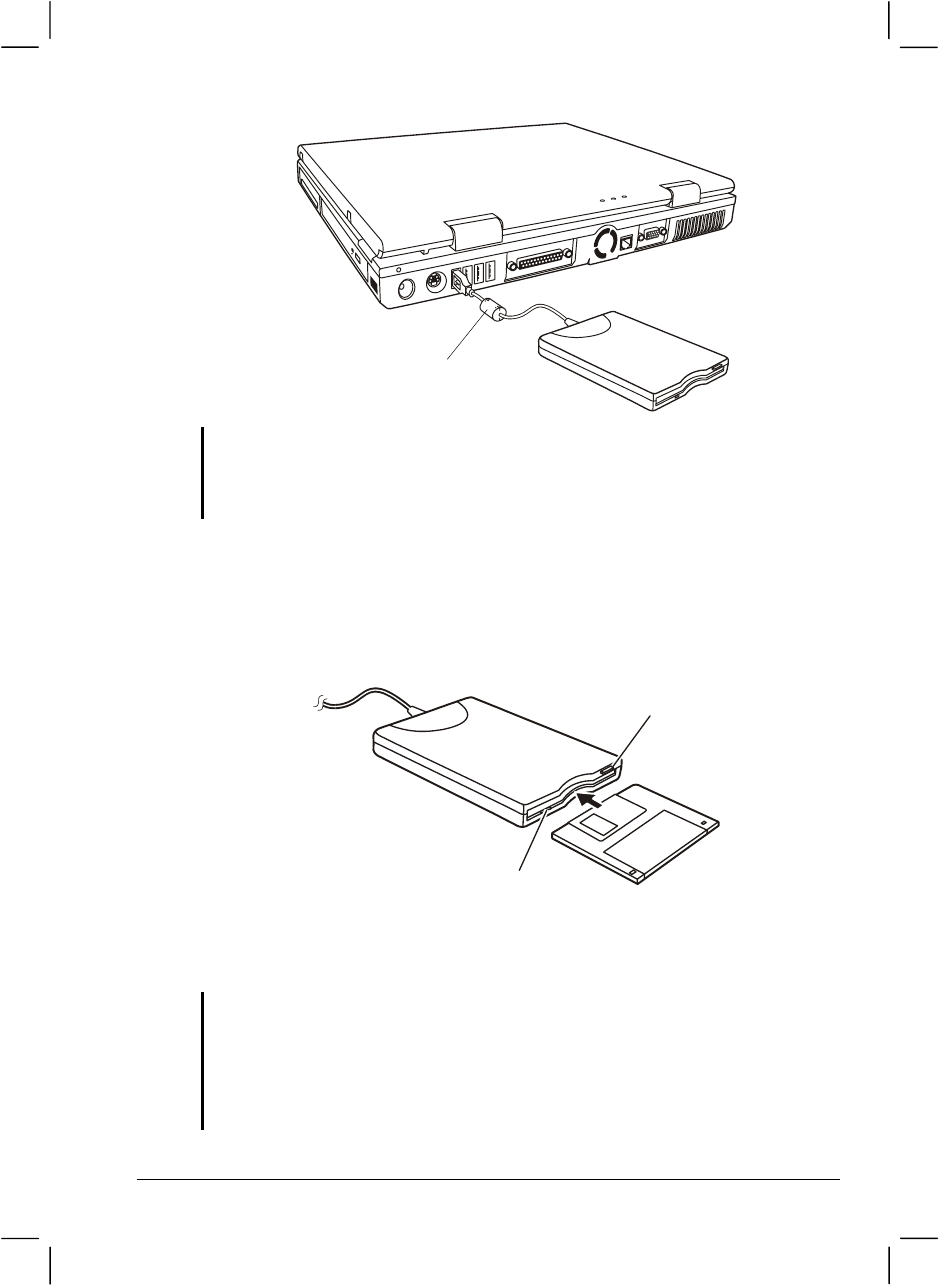
2SHUDWLQJ<RXU&RPSXWHU
127(
z 'HSHQGLQJRQ\RXUPRGHOWKHUHPD\EHDFRUHRQWKHIORSS\GLVNGULYHFDEOH
z 'RQRWSXWWKHIORSS\GLVNGULYHXSVLGHGRZQ
z 'RQRWSXWWKH$&DGDSWHURQWKHIORSS\GLVNGULYH
,QVHUWLQJDQG(MHFWLQJ)ORSS\'LVNV
To insert a floppy disk, hold it with the arrow facing up and towards the
drive. Slide the disk into the drive until it clicks into place.
To eject a floppy disk, first ensure that the floppy disk drive is not
working, and then press the eject button on the drive. When the floppy
disk pops out of the drive, remove the floppy disk and store it properly.
&$87,21
z 1HYHUWXUQRIIRUUHVHWWKHFRPSXWHUZKLOHWKHIORSS\GLVNGULYHLVZRUNLQJ
z $OZD\VVWRUH\RXUIORSS\GLVNVLQDVDIHFOHDQFRQWDLQHUWRSURWHFWWKHPIURPWKH
HQYLURQPHQWDQGPDJQHWLFILHOGV
z $IORSS\GLVNPXVWEHIRUPDWWHGEHIRUH\RXFDQXVHLW7RNQRZKRZWRIRUPDWD
IORSS\GLVNVHH\RXURSHUDWLQJV\VWHPPDQXDO
Eject Button
In-use Indicator
Core

2SHUDWLQJ<RXU&RPSXWHU
8VLQJWKH+DUG'LVN'ULYH
Your computer comes with a hard disk drive as drive C.
A hard disk drive is a storage device with non-removable, rotating,
magnetic storage platters inside it. It is where your operating system and
application software programs are stored.
Your hard disk drive is a 2.5-inch IDE (Integrated Drive Electronics) hard
disk drive. This type of drive embodies the latest in fast, reliable mass
storage by integrating all the control circuitry necessary for operation
directly onto the drive itself. This allows the drive manufacturer to
carefully optimize drive performance.
&$87,21
z 0DNHUHJXODUEDFNXSVRI\RXUGDWDILOHVIURP\RXUKDUGGLVNGULYHWRIORSS\GLVNVRU
RWKHUVWRUDJHPHGLD
z 1HYHUWU\WRUHPRYHRULQVWDOOWKHKDUGGLVNGULYHZKLOHWKHFRPSXWHULVSRZHUHGRQ
'RLQJVRFDQUHVXOWLQORVVRIGDWDDQGFDQGDPDJHWKHFRPSXWHUDQGWKHKDUGGLVN
GULYH¶VVHQVLWLYHFLUFXLWU\
z 1HYHUWXUQRIIRUUHVHWWKHFRPSXWHUZKLOHWKHKDUGGLVNGULYHLQXVHLQGLFDWRULVRQ

2SHUDWLQJ<RXU&RPSXWHU
8VLQJWKH&''9''ULYH
Your computer comes with a CD/DVD drive, usually configured as drive
D.
The drive uses removable 5.25-inch silver discs, which look like standard
music CDs. It is an ideal medium to use for distributing multimedia
because of the huge amount of data that a disc can store.
Depending on the model, your drive is one of the following:
z CD-ROM drive can read CD-ROMs, audio CDs, CD-R, and CD-
RW discs.
z CD-RW drive can not only read the above discs but also write to
CD-R and CD-RW discs.
z DVD-ROM drive can read DVD (Digital Versatile Disc) discs in
addition to the above discs.
z Combo drive can work both as a DVD-ROM drive and CD-RW
drive.
&$87,21
z :KHQLQVHUWLQJD&'GRQRWXVHIRUFH
z 0DNHVXUHWKH&'LVFRUUHFWO\LQVHUWHGLQWRWKHWUD\DQGWKHQFORVHWKHWUD\
z 'RQRWOHDYHWKH&'WUD\RSHQ$OVRDYRLGWRXFKLQJWKHOHQVLQWKHWUD\ZLWK\RXU
KDQG,IWKHOHQVEHFRPHVGLUW\WKH&'520PD\PDOIXQFWLRQ
z 'RQRWZLSHWKHOHQVXVLQJPDWHULDOVZLWKURXJKVXUIDFHVXFKDVSDSHUWRZHO
,QVWHDGXVHDFRWWRQVZDEWRJHQWO\ZLSHWKHOHQV
)'$UHJXODWLRQVUHTXLUHWKHIROORZLQJVWDWHPHQWIRUDOOODVHUEDVHGGHYLFHV
³&DXWLRQ8VHRIFRQWUROVRUDGMXVWPHQWVRUSHUIRUPDQFHRISURFHGXUHVRWKHUWKDQ
WKRVHVSHFLILHGKHUHLQPD\UHVXOWLQKD]DUGRXVUDGLDWLRQH[SRVXUH´
127()RU'9'520GULYHRQO\
7KLVSURGXFWLQFRUSRUDWHVFRS\ULJKWSURWHFWLRQWHFKQRORJ\WKDWLVSURWHFWHGE\PHWKRG
FODLPVRIFHUWDLQ86SDWHQWVDQGRWKHULQWHOOHFWXDOSURSHUW\ULJKWVRZQHGE\
0DFURYLVLRQ&RUSRUDWLRQDQGRWKHUULJKWVRZQHUV8VHRIWKLVFRS\ULJKWSURWHFWLRQ
WHFKQRORJ\PXVWEHDXWKRUL]HGE\0DFURYLVLRQ&RUSRUDWLRQDQGLVLQWHQGHGIRUKRPH
DQGRWKHUOLPLWHGYLHZLQJXVHVRQO\XQOHVVRWKHUZLVHDXWKRUL]HGE\0DFURYLVLRQ
&RUSRUDWLRQ5HYHUVHHQJLQHHULQJRUGLVDVVHPEO\LVSURKLELWHG
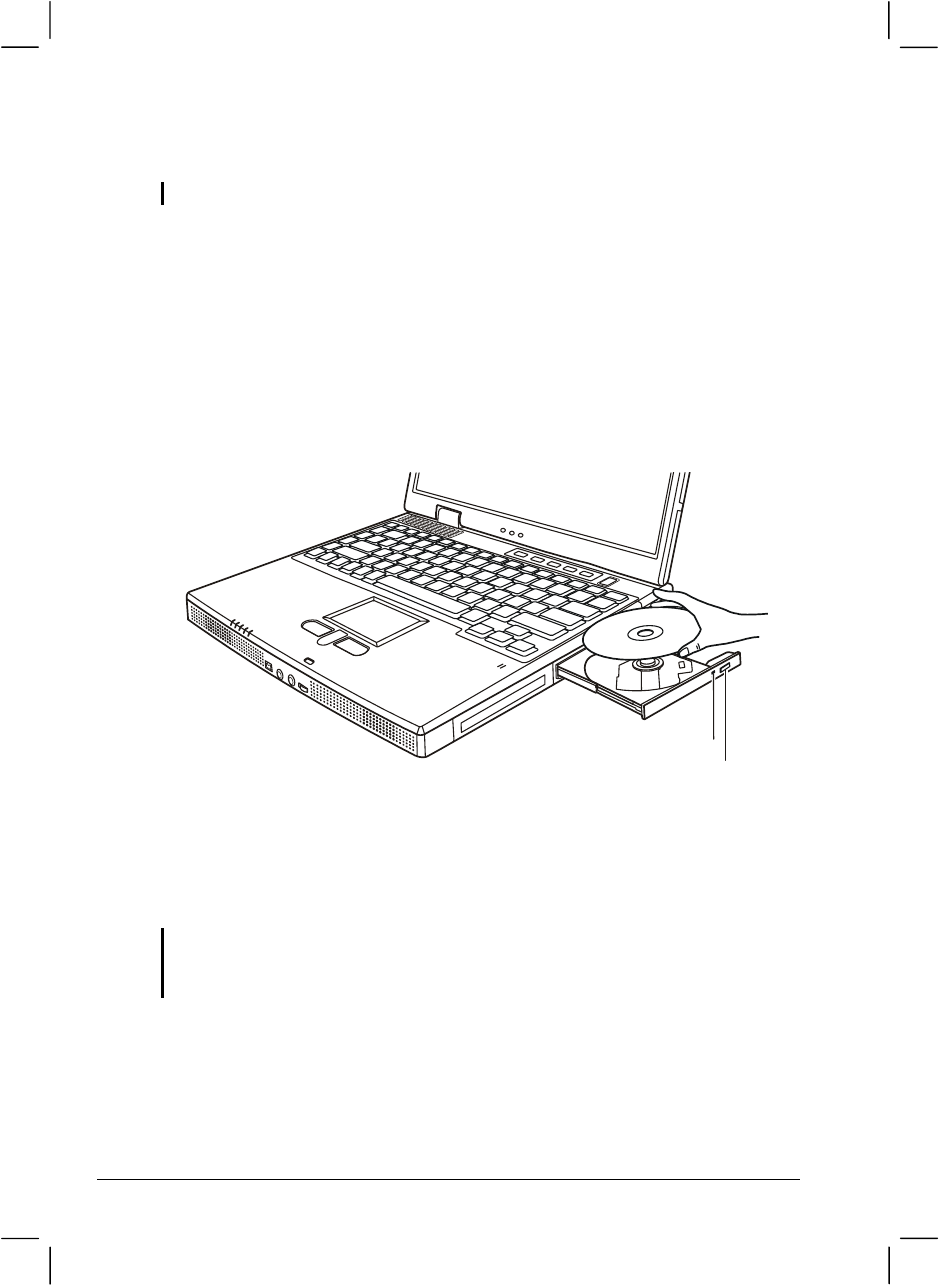
2SHUDWLQJ<RXU&RPSXWHU
,QVHUWLQJDQG5HPRYLQJD&'
127(7KHIROORZLQJSURFHGXUHDSSOLHVWRLQVHUWLQJRUUHPRYLQJD'9'DVZHOO
Follow this procedure to insert or remove a CD.
1. Turn on the computer.
2. Press the eject button and the CD tray will slide out partially. Gently
pull on it until it is fully extended.
3. To insert a CD, place down the CD in the tray with its label facing up.
Slightly press the center of the CD until it clicks into place.
To remove a CD, hold the CD by its outer edge and lift it up from the
tray.
4. Gently push the tray back into the drive.
127(,QWKHXQOLNHO\HYHQWWKDW\RXDUHXQDEOHWRUHOHDVHWKH&'WUD\E\SUHVVLQJWKH
HMHFWEXWWRQ\RXFDQPDQXDOO\UHOHDVHWKH&'6HH³&''ULYH3UREOHPV´LQ&KDSWHU
Eject Button
In-use Indicator

2SHUDWLQJ<RXU&RPSXWHU
8VLQJWKH9LGHR)HDWXUHV
The video subsystem of your computer features:
z 14.1/15-inch TFT (Thin-Film Transistor) color LCD display with
1024x768 XGA (Extended Graphics Array) resolution.
z Simultaneous display on LCD and external monitor, which is useful
when you have a presentation as you can control the screen from your
computer and face the audience at the same time.
z S-video support allows the connection of a TV set, and simultaneous
display on TV and external monitor.
z Power Management.
127(7KHFRPSXWHUHQWHUV6WDQGE\RU+LEHUQDWLRQPRGHZKHQWKH/&'LVFORVHG,I
\RXZDQWWRXVHWKHFRPSXWHUZLWKWKH/&'FORVHGVHW1RQHWRWKH³:KHQ,FORVHWKHOLG
RIP\SRUWDEOHFRPSXWHU´RSWLRQLQWKH3RZHU0DQDJHPHQW3URSHUWLHV7KXVWKH
FRPSXWHUGRHVQRWHQWHU6WDQGE\RU+LEHUQDWLRQPRGHZKHQWKH/&'LVFORVHG
&RQILJXULQJWKH'LVSOD\0RGHV
127(7RWDNHDGYDQWDJHRIWKHHQKDQFHGYLGHRFDSDELOLWLHVWKHYLGHRGULYHUVXSSOLHG
ZLWK\RXUFRPSXWHUPXVWEHLQVWDOOHG
Your computer has been set to a default resolution and number of colors
before shipment. You can view and change display settings through your
operating system. See your operating system documentation or online
help for specific information.
For displaying in higher resolutions, you can connect an external CRT
monitor that supports higher resolutions. (See “Connecting an External
Monitor” in Chapter 4 for more information.)
The following table lists the display modes supported by your computer.

2SHUDWLQJ<RXU&RPSXWHU
Display Mode
LCD
&
CRT
TV
Only
TV
&
CRT
LCD
Only
CRT
Only
Resolution Colors
8-bit √√ √ √
16-bit √√ √ √
640x480
32-bit √√ √ √
8-bit √√ √√√
16-bit √√ √√√
800x600
32-bit √√ √√√
8-bit √√ √√√
16-bit √√ √√√
1024x768
32-bit √√ √√√
8-bit √√√
16-bit √√√
1280x1024
32-bit √√√
8-bit √
16-bit √
1600x1200
32-bit √
TABLE NOTE: 8-bits = 256 colors; 16-bits = High Color or 65,536 (64 K)
colors; 24 and 32-bit = True Color 16,770,000 (16 M) colors.
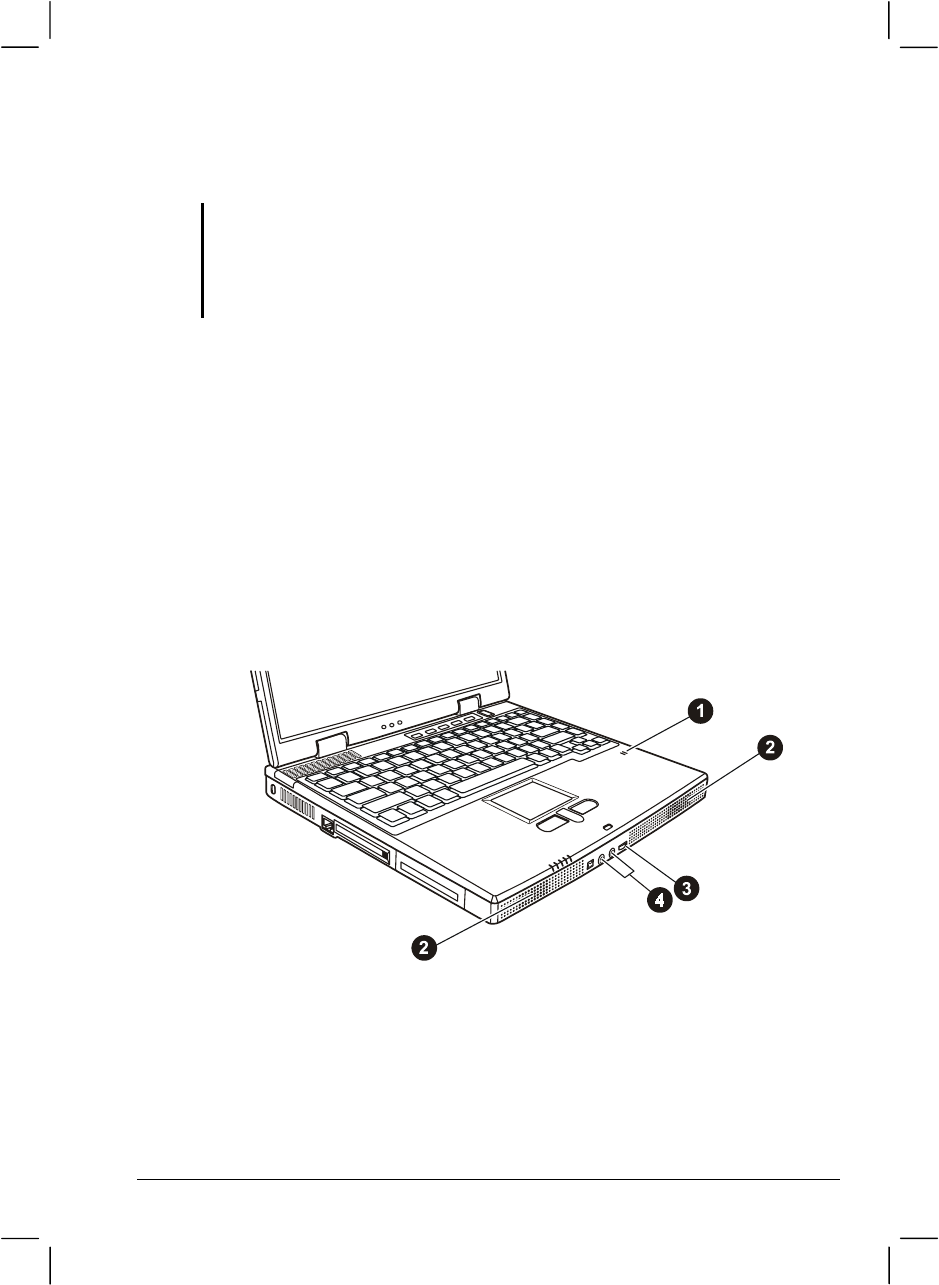
2SHUDWLQJ<RXU&RPSXWHU
8VLQJWKH$XGLR)HDWXUHV
127(
z 7RWDNHDGYDQWDJHRIWKHHQKDQFHGDXGLRFDSDELOLWLHVWKHDXGLRGULYHUVXSSOLHG
ZLWK\RXUFRPSXWHUPXVWEHLQVWDOOHG
z ,I\RXH[SHULHQFHLQWHUIHUHQFHZKLOHUHFRUGLQJWU\ORZHULQJWKHPLFURSKRQH
UHFRUGLQJYROXPH
The audio subsystem of your computer features:
z Digital audio and analog mixing functions required for recording and
playing sound on your computer
z Sound Blaster Pro, Adlib, and Microsoft Windows Sound System
support
z Built-in microphone (n) and a set of speakers (o)
z Volume control (p)
z External audio connectors (q)
Ways of playing and recording sound vary with the operating system used.
See your operating system documentation or online help for specific
information.
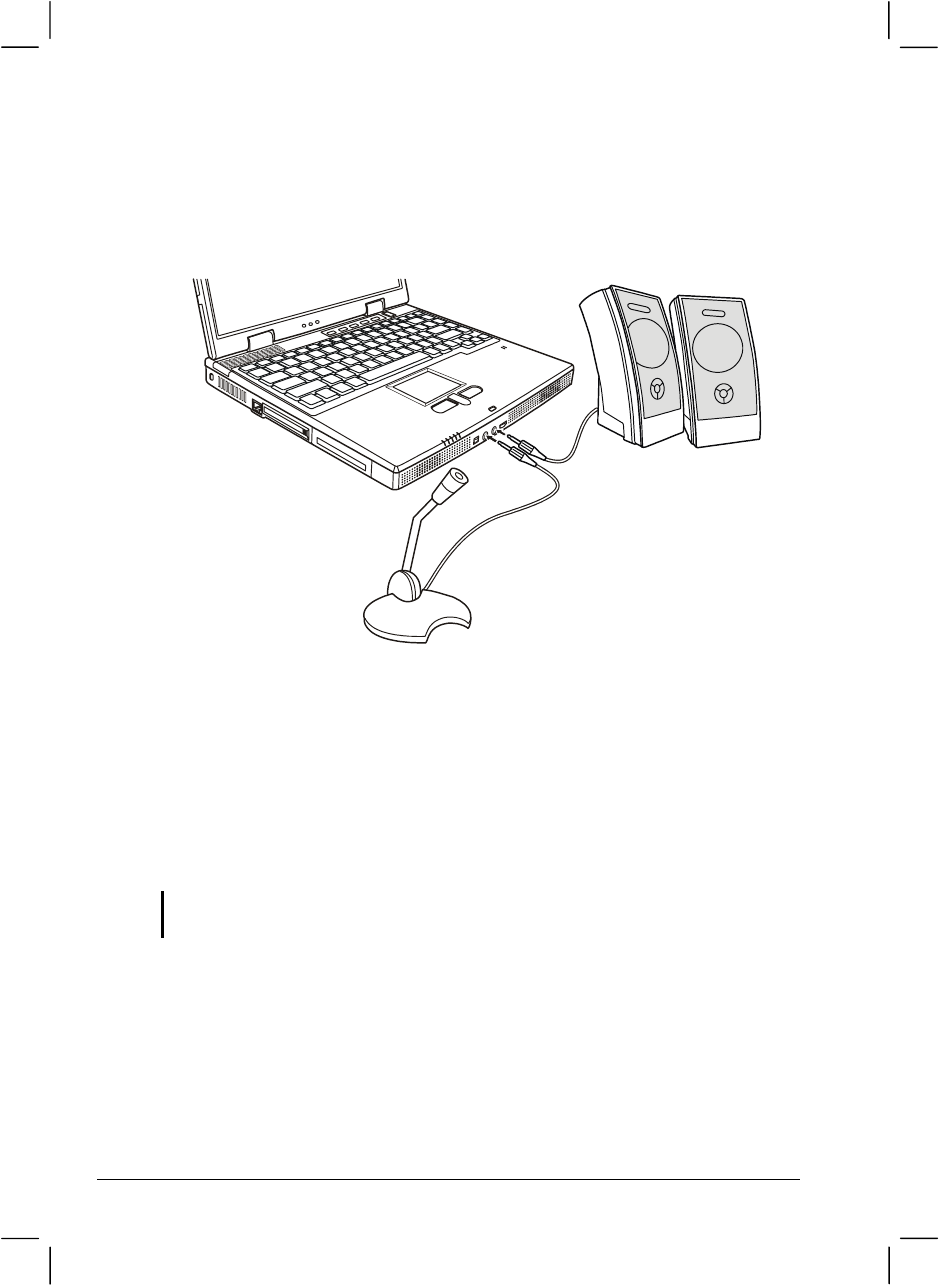
2SHUDWLQJ<RXU&RPSXWHU
&RQQHFWLQJ$XGLR'HYLFHV
For higher audio quality, you can send or receive sound through external
audio devices.
z Microphone Connector can be connected to an external
microphone for recording voice or sound.
z Audio Output Connector can be connected to the line-in connector
of powered speakers with built-in amplifiers, headphones, or
earphone set. This connector is compliant to S/PDIF (Sony/Philips
Digital Interface). You can connect audio equipment with S/PDIF to
the computer.
127(:KHQXVLQJH[WHUQDOVSHDNHUVKHDGSKRQHVRUPLFURSKRQH\RXFDQQRWXVHWKH
LQWHUQDORQH
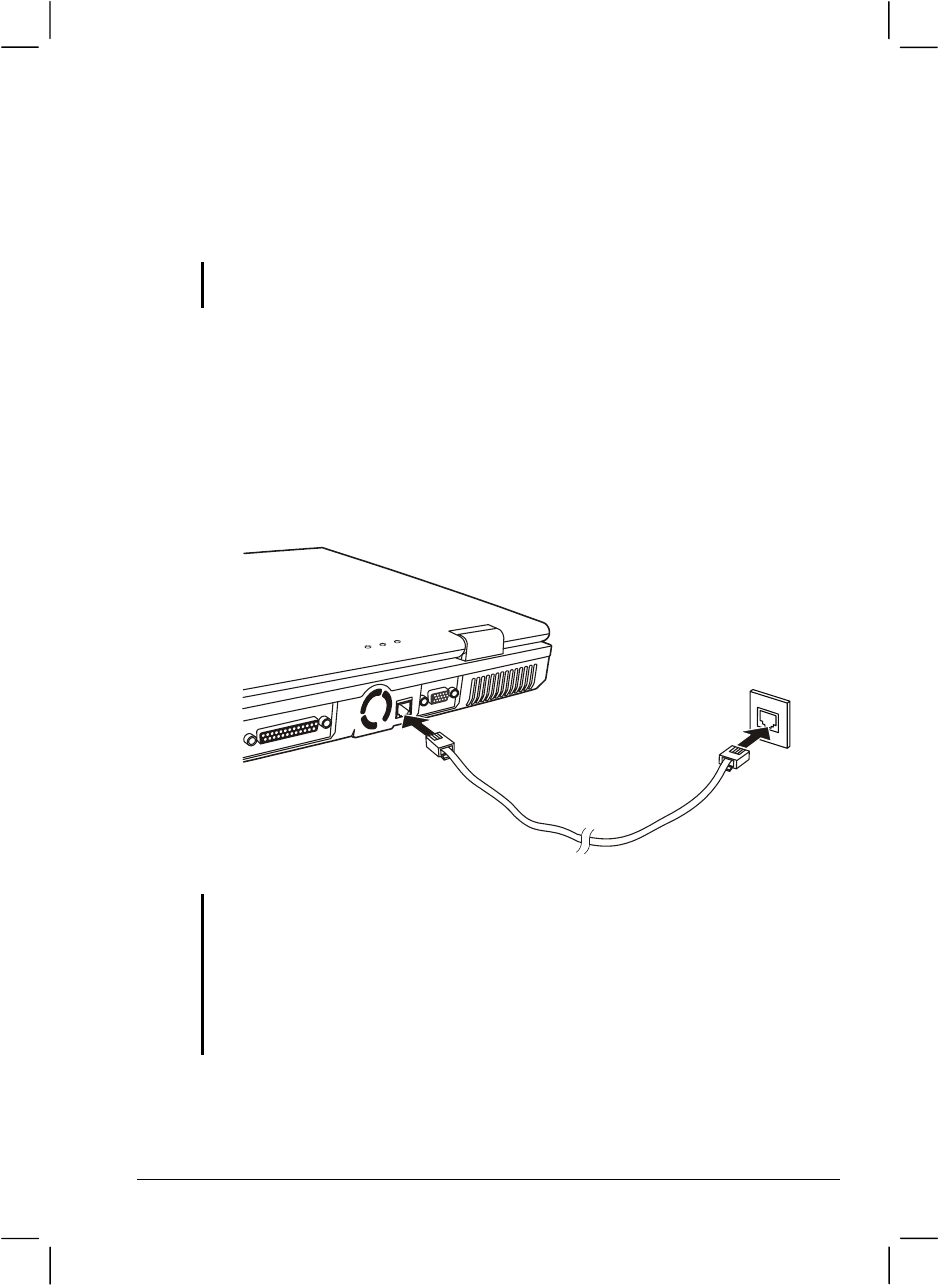
2SHUDWLQJ<RXU&RPSXWHU
8VLQJWKH&RPPXQLFDWLRQ)HDWXUHV
8VLQJWKH0RGHP
127(7RWDNHDGYDQWDJHRIWKHPRGHPIHDWXUHWKHPRGHPGULYHUVXSSOLHGZLWK\RXU
FRPSXWHUPXVWEHLQVWDOOHG
The internal 56 K fax/data modem allows you to use the telephone line to
communicate with others by fax, email, or connect to an online service or
bulletin board.
To connect the telephone line to the modem, connect one end of the
modem cable to RJ-11 connector on the computer and the other end to the
phone line.
127(
z :KHQXVLQJFRPPXQLFDWLRQVRIWZDUH\RXPD\KDYHWRGLVDEOHSRZHU
PDQDJHPHQW
z 6HWWKH&20SRUWRIWKHPRGHPWR&20
z 6HWSDUDPHWHUVVXFKDVPRGHPVSHHGEDXGUDWHDQGOLQHW\SHSXOVHGLDOLQJRU
WRQHGLDOLQJ
z 'RQRWHQWHU6WDQGE\ZKHQXVLQJFRPPXQLFDWLRQVRIWZDUH
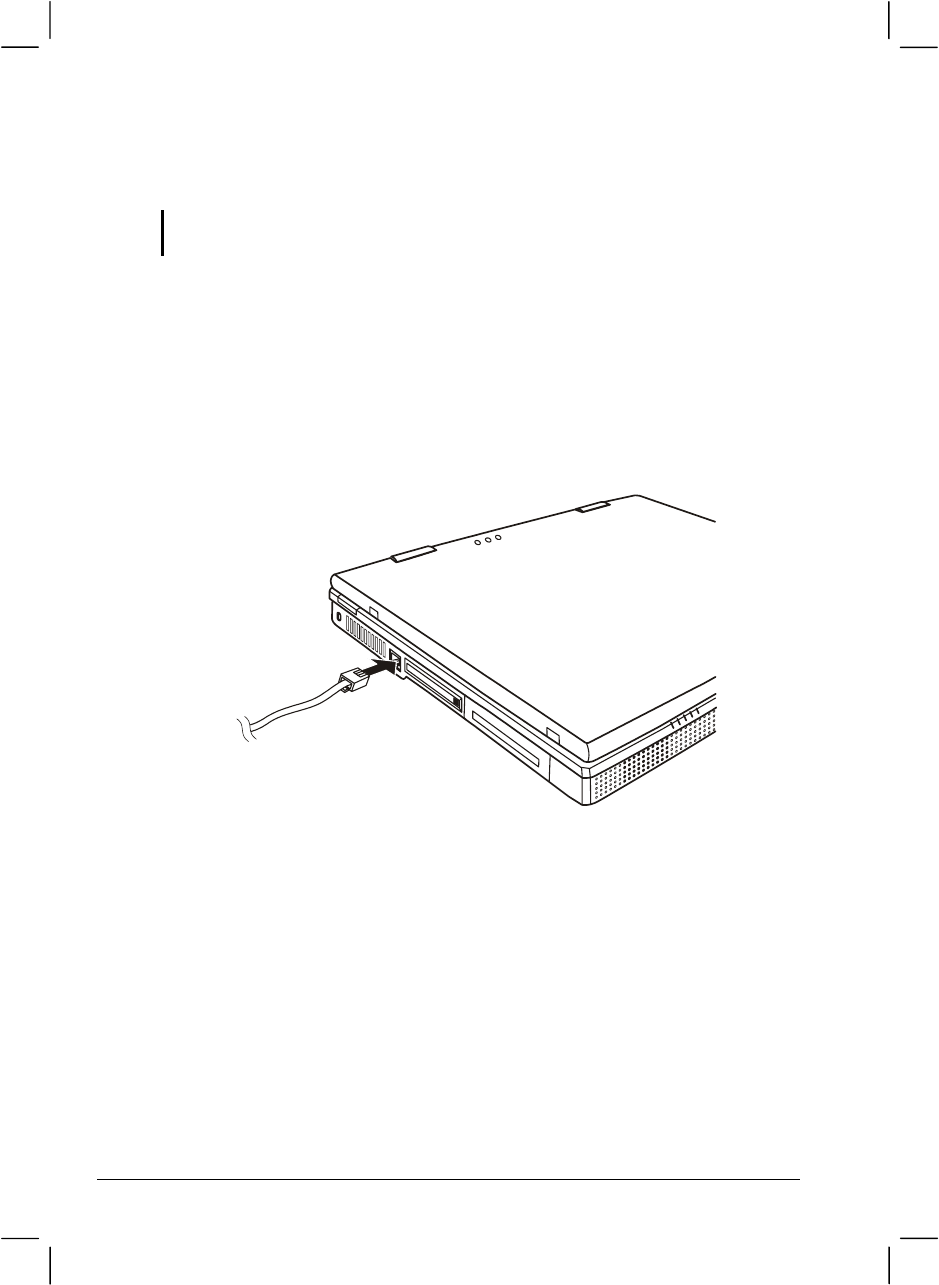
2SHUDWLQJ<RXU&RPSXWHU
8VLQJWKH/$1
127(7RWDNHDGYDQWDJHRIWKH/$1IHDWXUHWKH/$1GULYHUVXSSOLHGZLWK\RXU
FRPSXWHUPXVWEHLQVWDOOHG
The internal 10/100Base-T LAN (Local Area Network) module allows
you to connect your computer to a network. It supports data transfer rate
up to 100 Mbps.
To connect the network cable to the LAN module, connect one end of the
LAN cable to the RJ-45 connector on the computer and the other end to
the network hub.

CHAPTER 3
Managing Power
Your computer operates either on external AC power or internal battery
power.
This chapter tells you how you can effectively manage power. To
maintain optimal battery performance, it is important that you use the
battery in the proper way.
The topics in this chapter include:
z What is an AC adapter
z How to charge the battery pack
z When and how to initialize the battery pack
z How to check the battery level
z How to replace the battery pack
z What happens when the battery is low and what actions to take
z What is Power Management
z How to save power
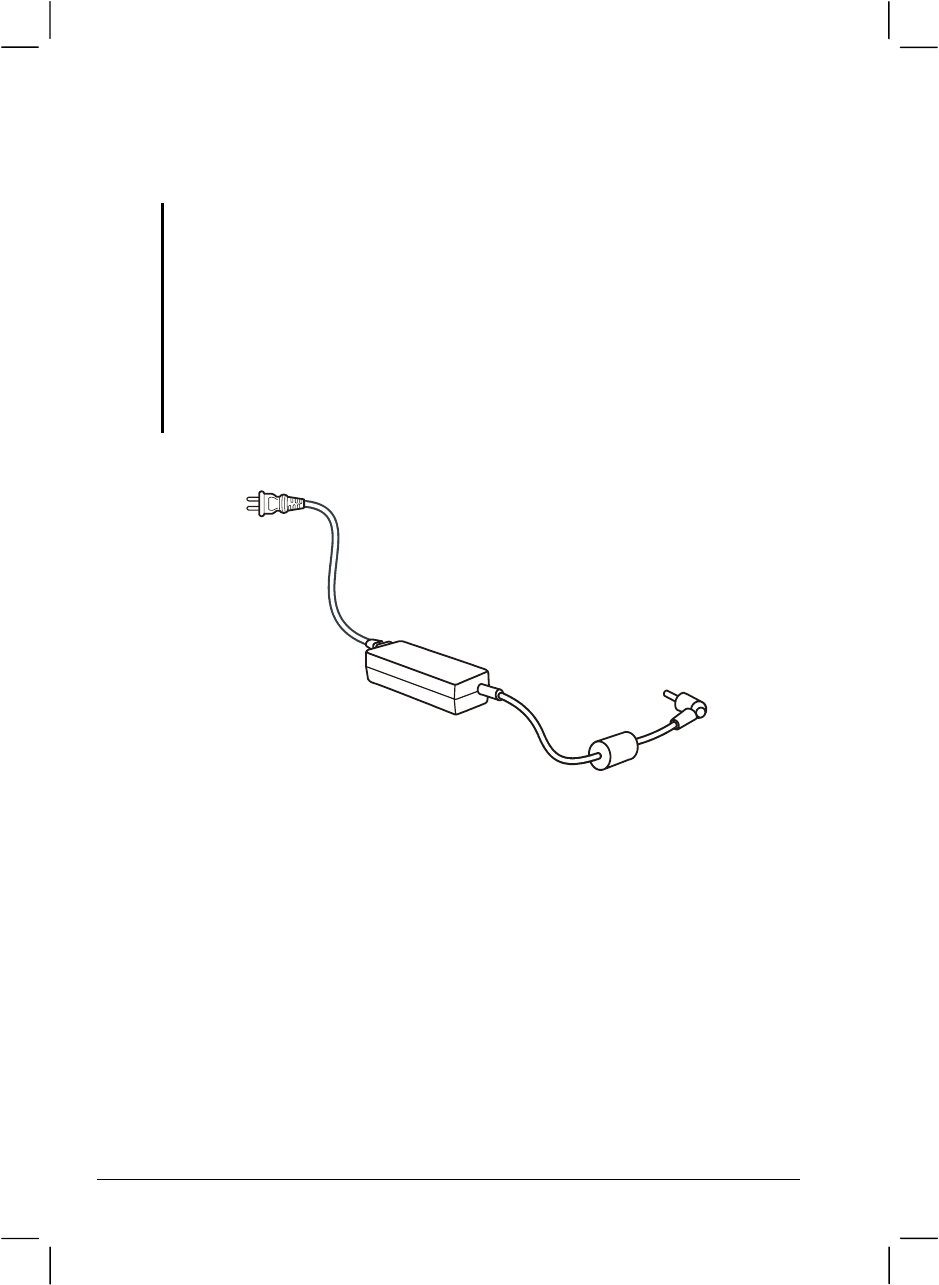
0DQDJLQJ3RZHU
$&$GDSWHU
&$87,21
z 7KH$&DGDSWHULVGHVLJQHGIRUXVHZLWK\RXUFRPSXWHURQO\&RQQHFWLQJWKH$&
DGDSWHUWRDQRWKHUGHYLFHFDQGDPDJHWKHDGDSWHU
z 7KH$&SRZHUFRUGVXSSOLHGZLWK\RXUFRPSXWHULVIRUXVHLQWKHFRXQWU\ZKHUH\RX
SXUFKDVHG\RXUFRPSXWHU,I\RXSODQWRJRRYHUVHDVZLWKWKHFRPSXWHUFRQVXOW
\RXUGHDOHUIRUWKHDSSURSULDWHSRZHUFRUG
z :KHQ\RXGLVFRQQHFWWKH$&DGDSWHUGLVFRQQHFWIURPWKHHOHFWULFDORXWOHWILUVWDQG
WKHQIURPWKHFRPSXWHU$UHYHUVHSURFHGXUHPD\GDPDJHWKH$&DGDSWHURU
FRPSXWHU
z :KHQXQSOXJJLQJWKHFRQQHFWRUDOZD\VKROGWKHSOXJKHDG1HYHUSXOORQWKHFRUG
The AC adapter serves as a converter from AC (Alternating Current) to
DC (Direct Current) power because your computer runs on DC power,
but an electrical outlet usually provides AC power. It also charges the
battery pack when connected to AC power.
The adapter operates on any voltage in the range of 100~240V AC.
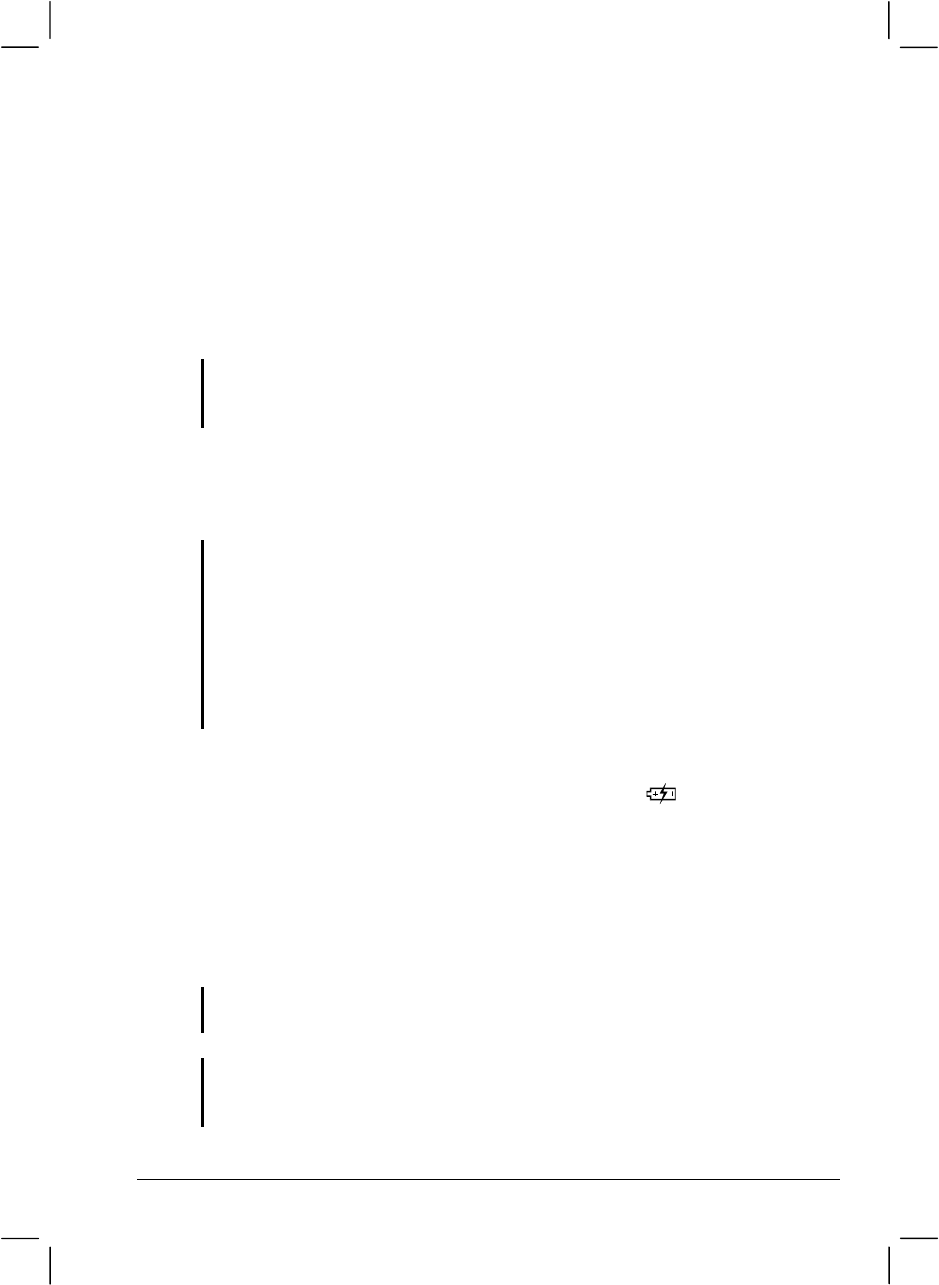
0DQDJLQJ3RZHU
%DWWHU\3DFN
The battery pack is the internal power source for the computer. It is
rechargeable using the AC adapter.
The operating time of a fully charged battery pack depends on how you
are using the computer. When your applications often access peripherals,
you will experience a shorter operating time.
127(&DUHDQGPDLQWHQDQFHLQIRUPDWLRQIRUWKHEDWWHU\LVSURYLGHGLQ&KDSWHU,Q
DGGLWLRQWRWKLVFKDSWHUEHVXUHWRUHDGWKH³%DWWHU\3DFN*XLGHOLQHV´VHFWLRQLQ
&KDSWHUDVZHOO
&KDUJLQJWKH%DWWHU\3DFN
127(
z &KDUJLQJZLOOQRWVWDUWLIWKHEDWWHU\¶VWHPSHUDWXUHLVEHORZ°&°)RUDERYH
°&°)
z 7KHFKDUJLQJSURFHVVZLOOVWRSDQGWKH%DWWHU\&KDUJH,QGLFDWRUIODVKHVRUDQJH
ZKHQWKHEDWWHU\¶VWHPSHUDWXUHJHWVDERYH°&°),IWKLVKDSSHQVWKH
EDWWHU\SDFNPD\EHGDPDJHG3OHDVHFRQWDFW\RXUGHDOHU
z 'XULQJFKDUJLQJGRQRWGLVFRQQHFWWKH$&DGDSWHUEHIRUHWKHEDWWHU\KDVEHHQIXOO\
FKDUJHGRWKHUZLVH\RXZLOOJHWDSUHPDWXUHO\FKDUJHGEDWWHU\
To charge the battery pack, connect the AC adapter to the computer and
an electrical outlet. The Battery Charge Indicator ( ) on the computer
glows orange to indicate that charging is in progress. You are advised to
keep the computer power off while the battery is being charged. When the
battery is fully charged, the Battery Charge Indicator glows green.
It takes approximately 3 hours to fully charge the Li-Ion battery pack
when the computer is off, and 4~5.5 hours to fully charge the Li-Ion
battery pack when the computer is on.
&$87,21$IWHUWKHFRPSXWHUKDVEHHQIXOO\UHFKDUJHGGRQRWLPPHGLDWHO\GLVFRQQHFW
DQGUHFRQQHFWWKH$&DGDSWHUWRFKDUJHLWDJDLQ'RLQJVRPD\GDPDJHWKHEDWWHU\
127(7KHEDWWHU\OHYHOPD\DXWRPDWLFDOO\OHVVHQGXHWRWKHVHOIGLVFKDUJHSURFHVV
SHUGD\HYHQZKHQWKHEDWWHU\SDFNLVIXOO\FKDUJHG7KLVKDSSHQVQR
PDWWHULIWKHEDWWHU\SDFNLVLQVWDOOHGLQWKHFRPSXWHU
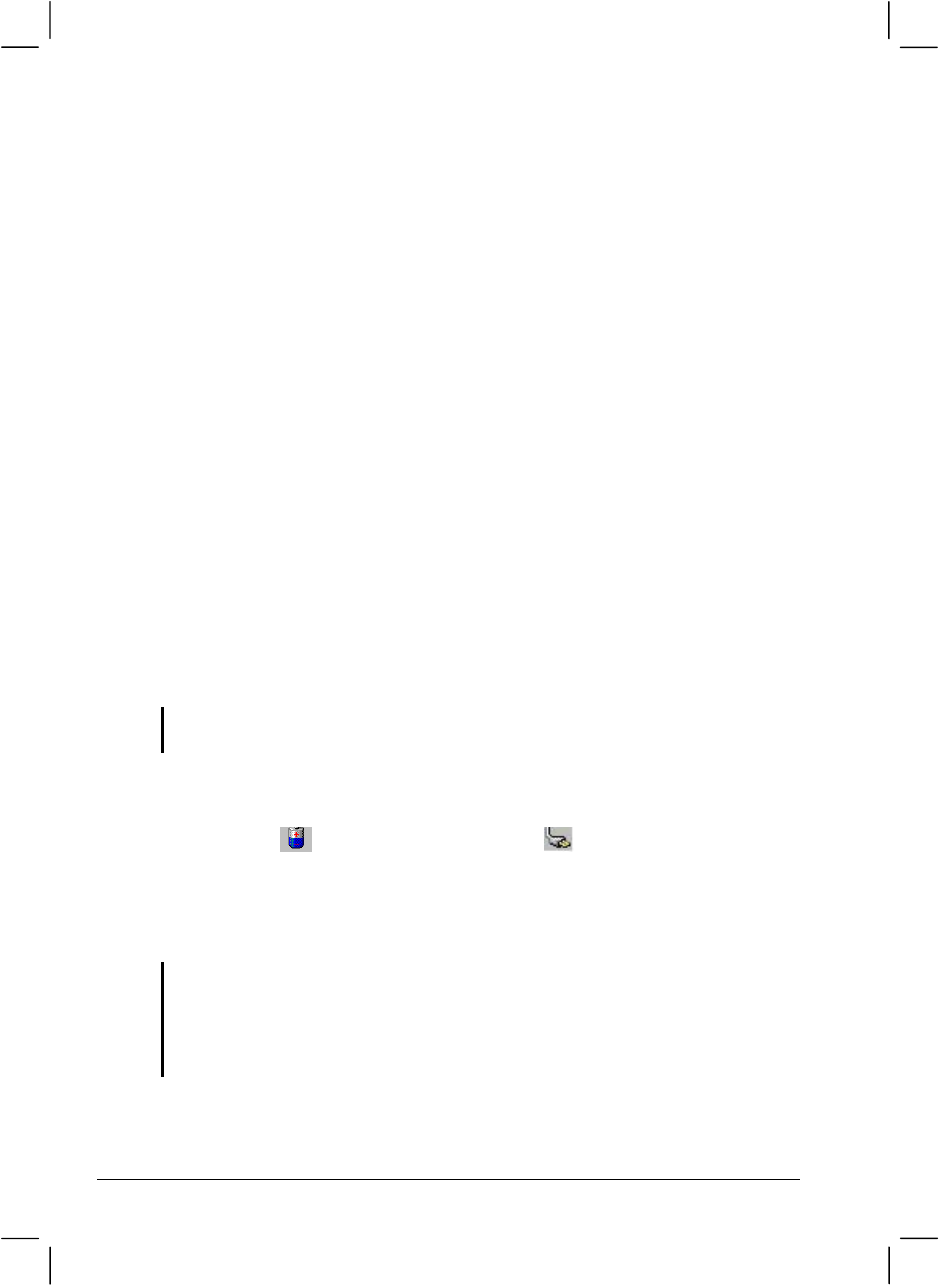
0DQDJLQJ3RZHU
,QLWLDOL]LQJWKH%DWWHU\3DFN
You need to initialize a new battery pack before using it for the first time
or when the actual operating time of a battery pack is much less than
expected.
Initializing is the process of fully charging, discharging, and then
charging. It can take several hours.
1. Make sure the computer power is turned off. Connect the AC adapter
to fully charge the battery pack.
2. After the battery pack is fully charged, turn on the computer. When
the message “Press <F2> to enter System Configuration Utility”
appears, press)to invoke the program.
3. Disconnect the AC adapter and leave the computer on until the
battery is fully discharged. The computer will shut down
automatically.
4. Connect the AC adapter to fully charge the battery pack.
&KHFNLQJWKH%DWWHU\/HYHO
127($Q\EDWWHU\OHYHOLQGLFDWLRQLVDQHVWLPDWHGUHVXOW7KHDFWXDORSHUDWLQJWLPHFDQ
EHGLIIHUHQWIURPWKHHVWLPDWHGWLPHGHSHQGLQJRQKRZ\RXDUHXVLQJWKHFRPSXWHU
You can check the approximate battery level using the battery meter
function of the operating system. To read the battery level in Windows,
click the icon on the taskbar. (Click the icon if the computer is
using AC power.)
5HSODFLQJWKH%DWWHU\3DFN
&$87,21
z 7KHUHLVGDQJHURIH[SORVLRQLIWKHEDWWHU\LVLQFRUUHFWO\UHSODFHG5HSODFHWKH
EDWWHU\RQO\ZLWKWKHFRPSXWHUPDQXIDFWXUHU¶VRSWLRQDOEDWWHU\SDFNV'LVFDUGXVHG
EDWWHULHVDFFRUGLQJWRWKHGHDOHU¶VLQVWUXFWLRQV
z 'RQRWDWWHPSWWRGLVDVVHPEOHWKHEDWWHU\SDFN
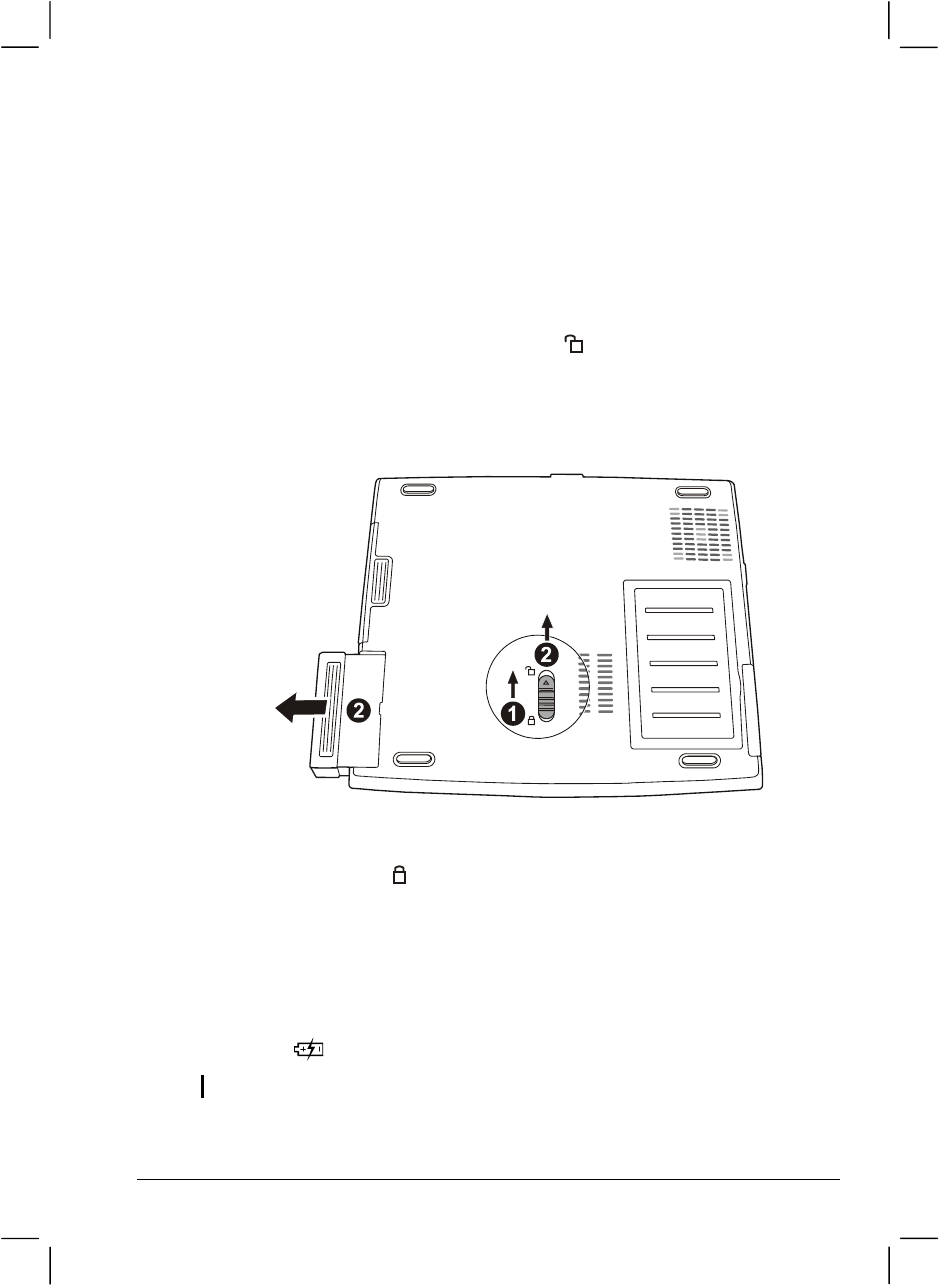
0DQDJLQJ3RZHU
If you often rely on battery power for a long period of time while
traveling, you may consider the purchase of an additional battery pack
from your dealer and keep it with you in a fully charged state as a backup.
To replace the battery pack, follow these steps:
1. Make sure the computer is not turned on or connected to AC power.
2. Carefully place the computer upside down.
3. Slide the release lever to the unlock ( ) position (n).
4. Slide and hold the release lever outward, and pull the battery pack out
of its compartment (o).
5. Insert the new battery pack into the compartment and slide the release
lever to the lock ( ) position.
%DWWHU\/RZ6LJQDOVDQG$FWLRQV
Battery Low occurs when the battery has approximately 10% of its charge
remaining. The computer gives warning beeps and the Battery Charge
Indicator ( ) blinks red to alert you to take actions.
127(<RXFDQVHWXS\RXUWKUHVKROGDQGVLJQDOVRI%DWWHU\/RZXQGHU:LQGRZV

0DQDJLQJ3RZHU
Immediately save your data upon Battery Low. The remaining operating
time depends on how you are using the computer. If you are using the
audio subsystem, PC card, hard or floppy disk drives, the battery might
run out of charge very quickly.
Always respond to Battery Low by placing your computer on Standby or
Hibernation mode, turning off the computer, or connecting the AC
adapter.
If you do not take any action and after two minutes’ of warning beeps, the
computer will automatically hibernate and turn off.
&$87,21
z ,I\RXDUHXVLQJDIODVK3&&DUGGRQRWDFFHVVWKHFDUGGXULQJEDWWHU\ORZSHULRGV
7KLVLVEHFDXVHWKHDFFHVVPD\WDNHORQJHUWKDQWKHWLPHLWWDNHVWKHEDWWHU\WRUXQ
RXWRIFKDUJHWKXVPDNLQJ\RXUDFFHVVWRWKHFDUGXQVXFFHVVIXO
z ,I\RXIDLOWRVDYH\RXUGDWDZKHQWKHEDWWHU\FRPSOHWHO\UXQVRXWRIFKDUJHWKHQ
\RXORVH\RXUGDWD

0DQDJLQJ3RZHU
3RZHU0DQDJHPHQW
Your computer supports APM (Advanced Power Management) and
ACPI (Advanced Configuration and Power Interface) for power
management. The power management feature allows you to reduce the
power consumption for energy saving.
With an ACPI-compliant operating system such as Windows Me,
Windows 2000 and Windows XP, power supply to different computer
components is controlled on an as-needed basis. This allows maximum
power conservation and performance at the same time.
In general, Windows’ power management works in this way:
What…When…
Power to the hard disk is turned off When the hard disk has been idle for a
set period.
Power to the display is turned off When the display has been idle for a
set period.
When the entire system has been idle
for a set period.
When you press 3+ *
When you close the cover. *
The computer enters Standby mode.
The hard disk and display are turned
off and the entire system consumes
less power.
When you press the power button. *
When you press 3+ *
When you close the cover. *
The computer enters Hibernation
mode. (See the next subsection for
more information.)
When you press the power button. *
* Depends on your settings in Windows.
For detailed information on power management, see Windows’ Help.

0DQDJLQJ3RZHU
+LEHUQDWLRQ
Hibernation is a very useful feature. People frequently open many
applications when they use computers. It takes some time to get all these
applications open and running, and normally they all have to be closed
before the system can be turned off.
When you use the hibernation feature, you do not have to close the
applications. The computer stores the state of your computer to a file on
the hard disk and then shut down. The next time you turn on your
computer, you return to exactly where you left off.

0DQDJLQJ3RZHU
3RZHU6DYLQJ7LSV
In addition to your computer’s automatic power management, you can do
your part to maximize the battery’s operating time by following these
suggestions.
z Do not disable Power Management.
z Decrease the LCD brightness to the lowest comfortable level.
z Disable the parallel port if no devices are connected to these ports.
(See “Advanced Menu” in Chapter 5.)
z If you work with an application that uses a PC Card, exit the
application when you finish using it.
z If you have a PC Card installed, remove it when not in use. Some PC
Cards drain power even while they are inactive.
z Turn off the computer when you are not using it.

CHAPTER 4
Expanding Your Computer
You can expand the capabilities of your computer by connecting other
peripheral devices. When using a device, be sure to read the instructions
accompanying the device together with the relevant section in this
chapter.
This chapter gives guidelines on installing and using these devices:
z External monitor
z TV
z Parallel device
z USB device
z IR device
z IEEE 1394 device
z PC Card
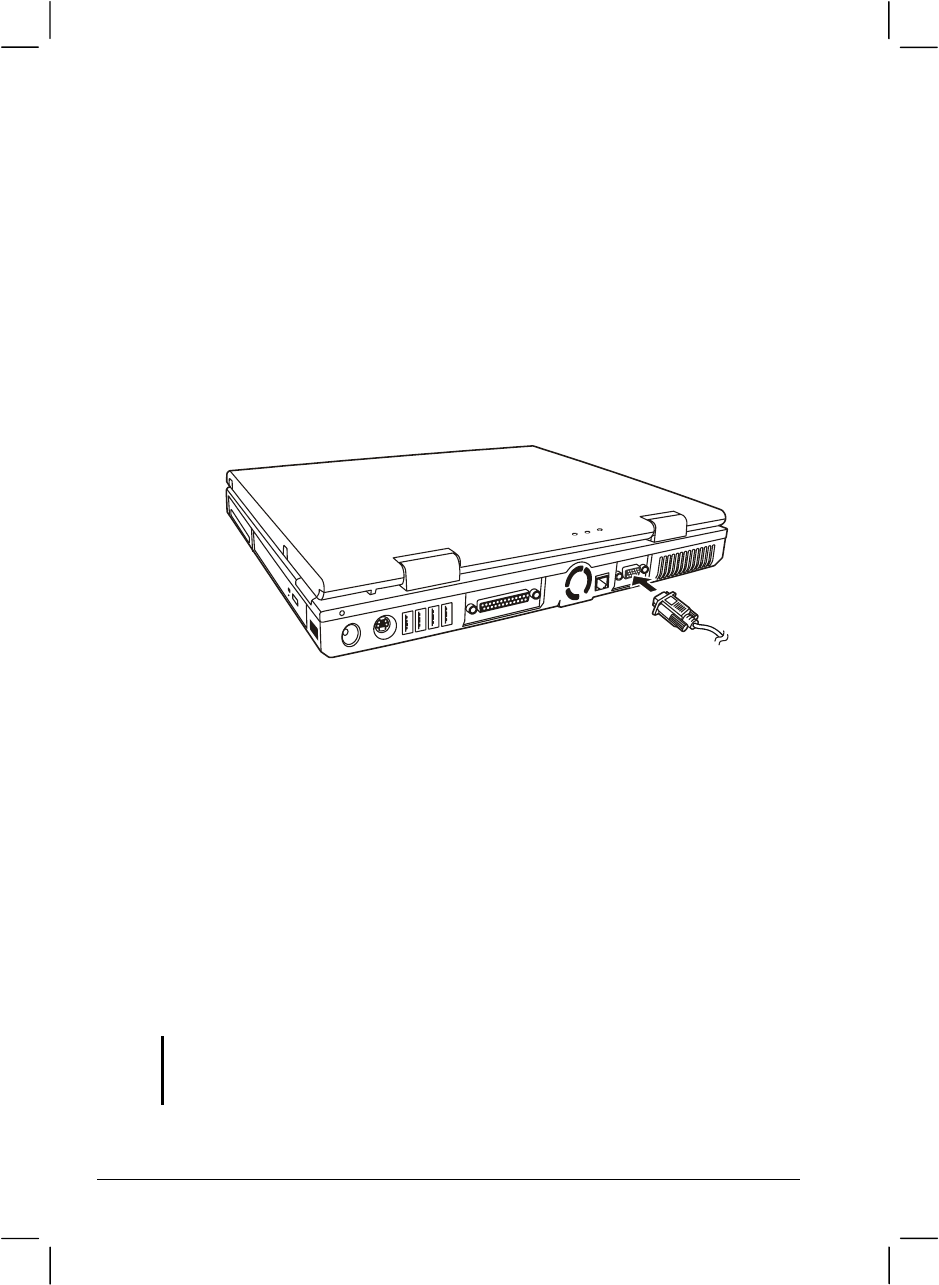
([SDQGLQJ<RXU&RPSXWHU
&RQQHFWLQJDQ([WHUQDO0RQLWRU
If you want the benefits of a larger display screen with higher resolution,
you can connect an external CRT monitor to your computer.
Follow this procedure to connect an external monitor:
1. Make sure the computer is not turned on.
2. Plug the monitor’s D-type signal connector to the computer’s VGA
port.
3. Plug one end of the monitor’s power cord into the power socket on
the monitor and the other end to an electrical outlet.
4. To use the monitor, turn on the monitor before turning on the
computer.
5. The monitor should respond by default. If not, you can switch the
display to the monitor or to both (simultaneous display) by pressing
)Q). In Windows, you can also change the display through the
settings in Display Properties.
6. You can change display settings through your operating system. See
your operating system documentation or online help for specific
information.
&$87,21'RQRWGLVFRQQHFWWKHH[WHUQDOPRQLWRUZKLOHWKHFRPSXWHULVLQ6WDQGE\
PRGHRU+LEHUQDWLRQPRGH,IQRH[WHUQDOPRQLWRULVFRQQHFWHGZKHQWKHFRPSXWHU
UHVXPHVWKH/&'UHPDLQVEODQNDQGWKHRXWSXWLVQRWGLVSOD\HG
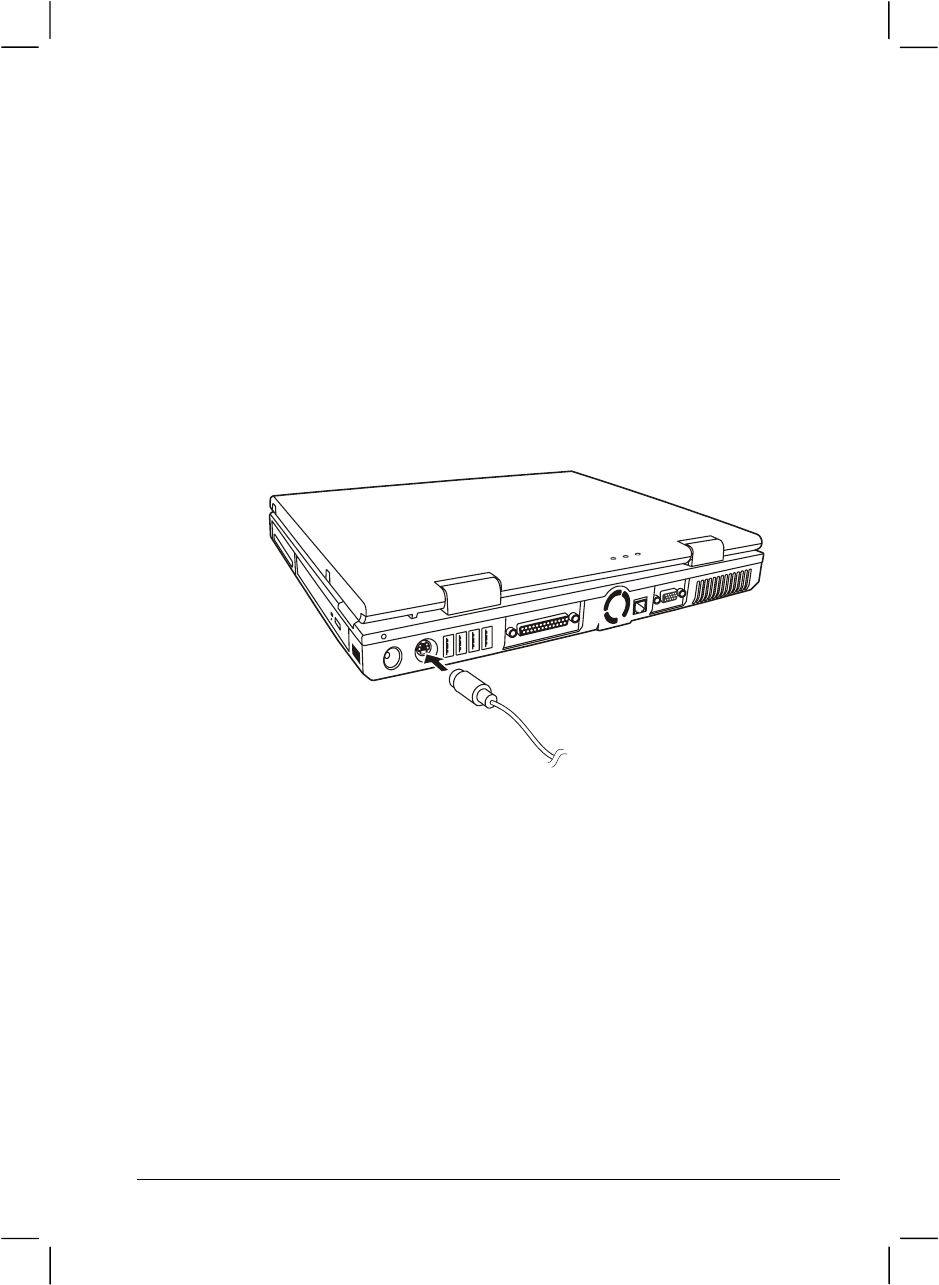
([SDQGLQJ<RXU&RPSXWHU
&RQQHFWLQJD79
For entertainment, conferences, or presentations, you can connect a TV to
your computer.
Follow this procedure to connect a TV:
1. Make sure the computer is not turned on.
2. You need a video cable for connection. Plug the connector of the
video cable to the computer’s S-video connector. Plug the other end
of the cable into the video input connector of the TV.
3. Turn on the computer and run the BIOS SCU program. Set the TV
System item to PAL or NTSC according to the specifications of your
location. Save and exit the SCU program. The computer will be
restarted.
4. Turn on the power of the TV and switch to the video mode.
5. Switch the display to TV by pressing )Q+). In Windows, you can
also change the display through the settings in Display Properties.

([SDQGLQJ<RXU&RPSXWHU
&$87,21
z 'RQRWVHWWKHGLVSOD\WRERWK/&'DQG797KLVPD\FDXVHXQVWDEOHGLVSOD\RQWKH
/&'
z 'RQRWGLVFRQQHFWWKH79ZKLOHWKHFRPSXWHULVLQ6WDQGE\PRGHRU+LEHUQDWLRQ
PRGH,IWKH79LVFRQQHFWHGZKHQWKHFRPSXWHUUHVXPHVWKH/&'UHPDLQVEODQN
DQGWKHRXWSXWLVQRWGLVSOD\HG
127(0DNHVXUHWKDWWKH9*$GULYHULVLQVWDOOHGFRUUHFWO\
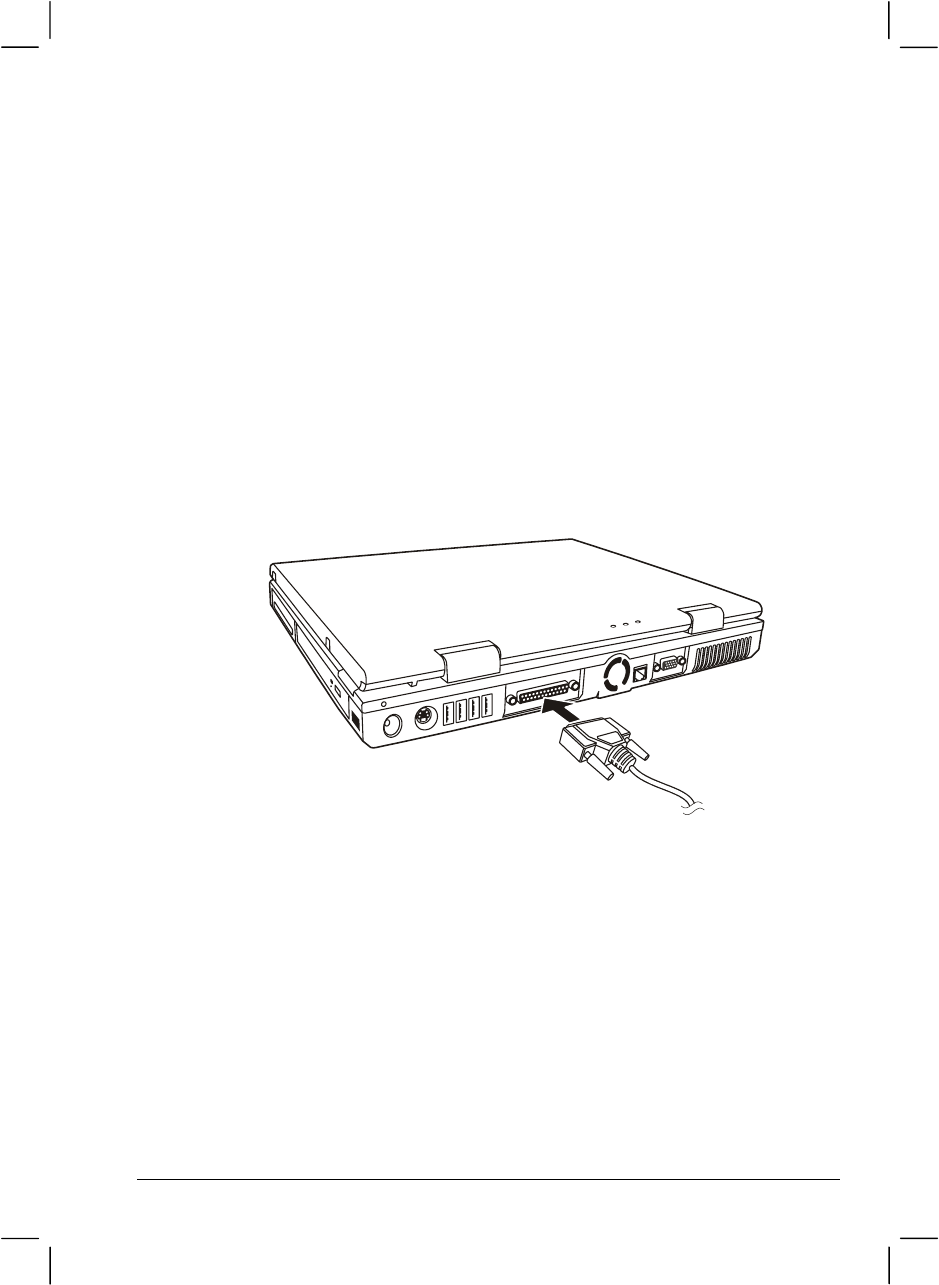
([SDQGLQJ<RXU&RPSXWHU
&RQQHFWLQJD3DUDOOHO'HYLFH
Your computer has a Parallel port for connecting a parallel device such as
printer. The port supports ECP (Extended Capabilities Port) and EPP
(Enhanced Parallel Port) modes that turn the standard parallel port into a
high-speed bi-directional peripheral port.
Follow this procedure to connect a parallel device:
1. Make sure that the LPT Port item is set properly in the SCU
program. (See “Advanced Menu” in Chapter 5 for information.)
2. Make sure the computer is not turned on.
3. Plug the parallel device’s cable to the computer’s parallel port.
4. If the parallel device has independent power, plug its power cord into
an electrical outlet.
5. If the parallel device has its own power switch, turn on the printer
before turning on the computer.
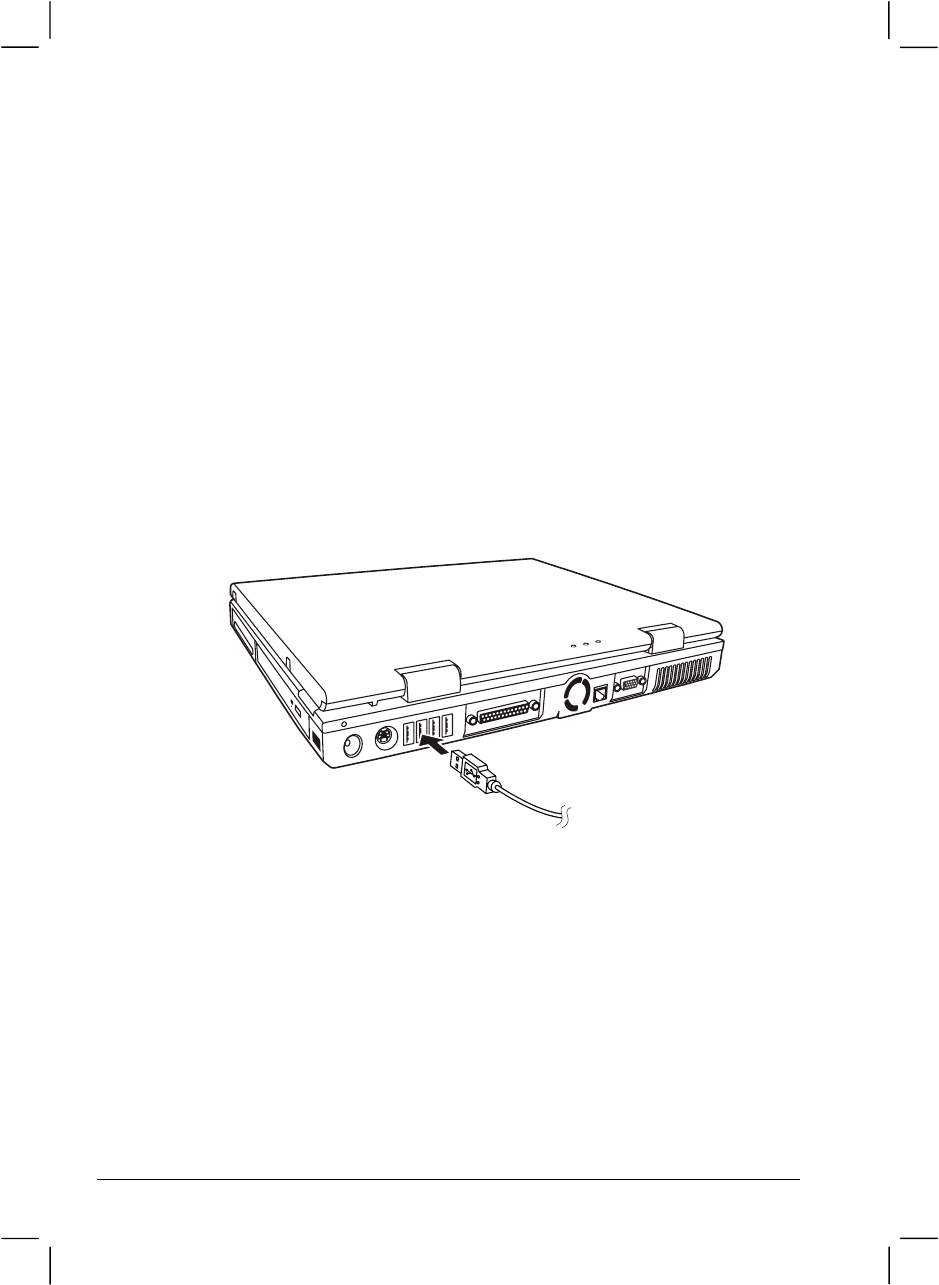
([SDQGLQJ<RXU&RPSXWHU
&RQQHFWLQJD86%'HYLFH
Your computer has four USB ports for connecting USB devices such as
digital camera, scanner, printer, modem, and mouse.
USB is specified to be an industry standard extension to the PC
architecture. It supports “Plug and Play” technology so you can install
and remove USB devices without turning off the computer. With its
multiple connection capability, up to 127 devices can be connected in a
daisy-chain configuration. In addition, you can use a USB hub that
converts a single USB connector into multiple ports where USB devices
can be connected.
To connect a USB device, simply plug the device cable to one of the USB
ports.
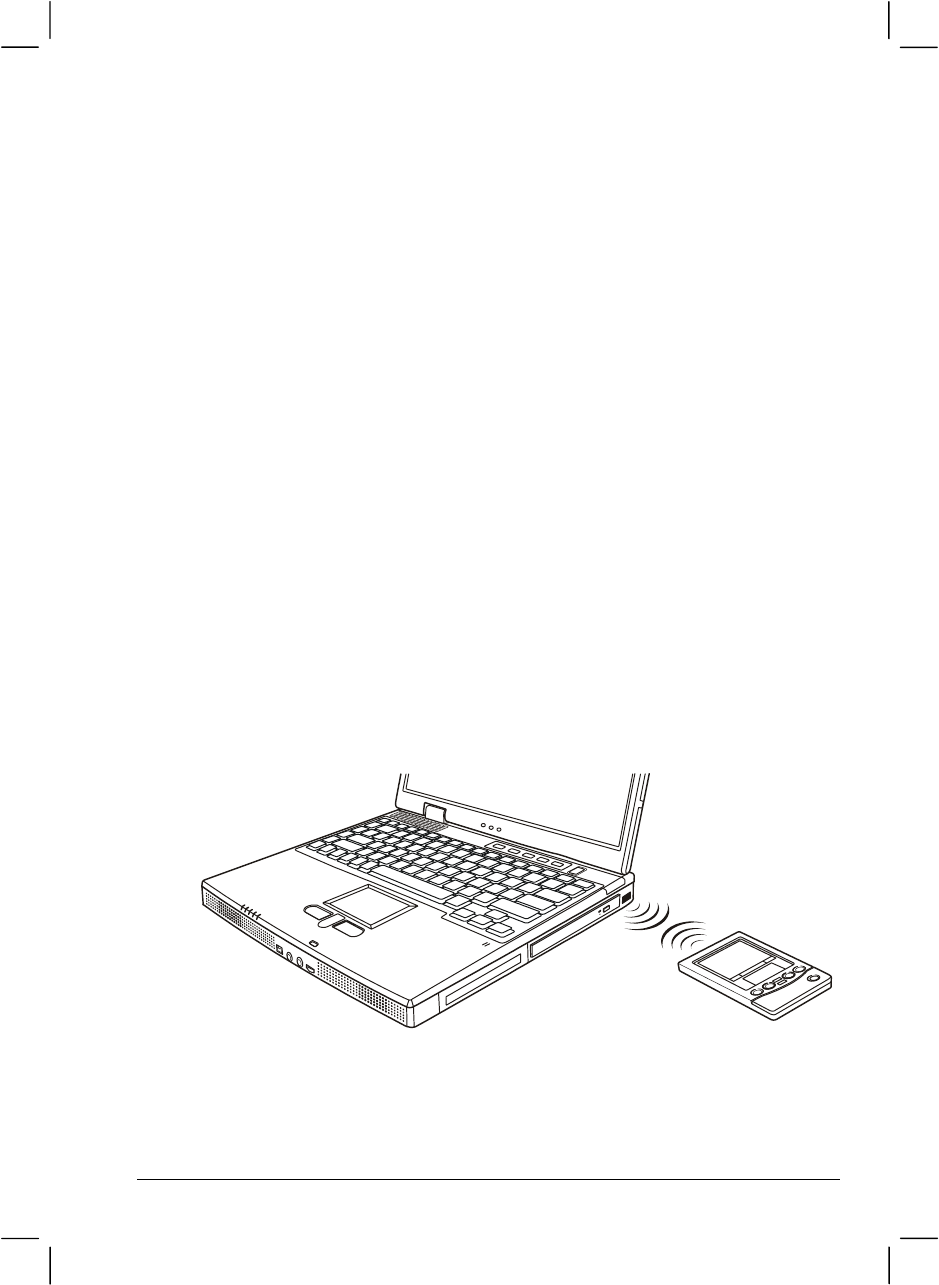
([SDQGLQJ<RXU&RPSXWHU
&RQQHFWLQJDQ,5'HYLFH
Your computer has an IR (infrared) port for connecting an infrared-
equipped device wirelessly such as another computer, printer, or PDA
(Personal Digital Assistant).
The infrared feature supports these standards:
z IrDA 1.1 (FIR – Fast Infrared) with 4.0 Mbps transfer rate
z IrDA 1.0 with 1.152 Mbps transfer rate
z ASK (SIR – Serial Infrared) with 2.4 Kbs transfer rate
Follow this procedure to connect an IR device:
1. Under Windows, make sure that the IrDA Fast Infrared Port is set to
HP HSDL-2300/3600. (See “How to Use the CD” in Chapter 6 for
information.)
2. Make sure that the COM Ports item is set properly in the SCU
program. (See “Advanced Menu” in Chapter 5 for information.)
3. Place the target device where its IR port faces the IR port of your
computer within the effective range − within ±15-degrees angle and 1
meter (3 feet) distance.
4. To take advantage of the IR communications, you need a third party
software.

([SDQGLQJ<RXU&RPSXWHU
127('XULQJLQIUDUHGFRPPXQLFDWLRQWDNHQRWHRIWKHIROORZLQJ
z 'RQRWPRYHWKHFRPSXWHUDQG,5GHYLFH
z 'RQRWHQWHU6WDQGE\PRGH
z 'RQRWXVHDFHOOSKRQHRUDQRWKHU,5GHYLFHQHDUWKHFRPSXWHU
z $YRLGVWURQJOLJKWVXFKDVVXQOLJKWRUIOXRUHVFHQWOLJKW
z 'LVDEOHWKHVFUHHQVDYHU
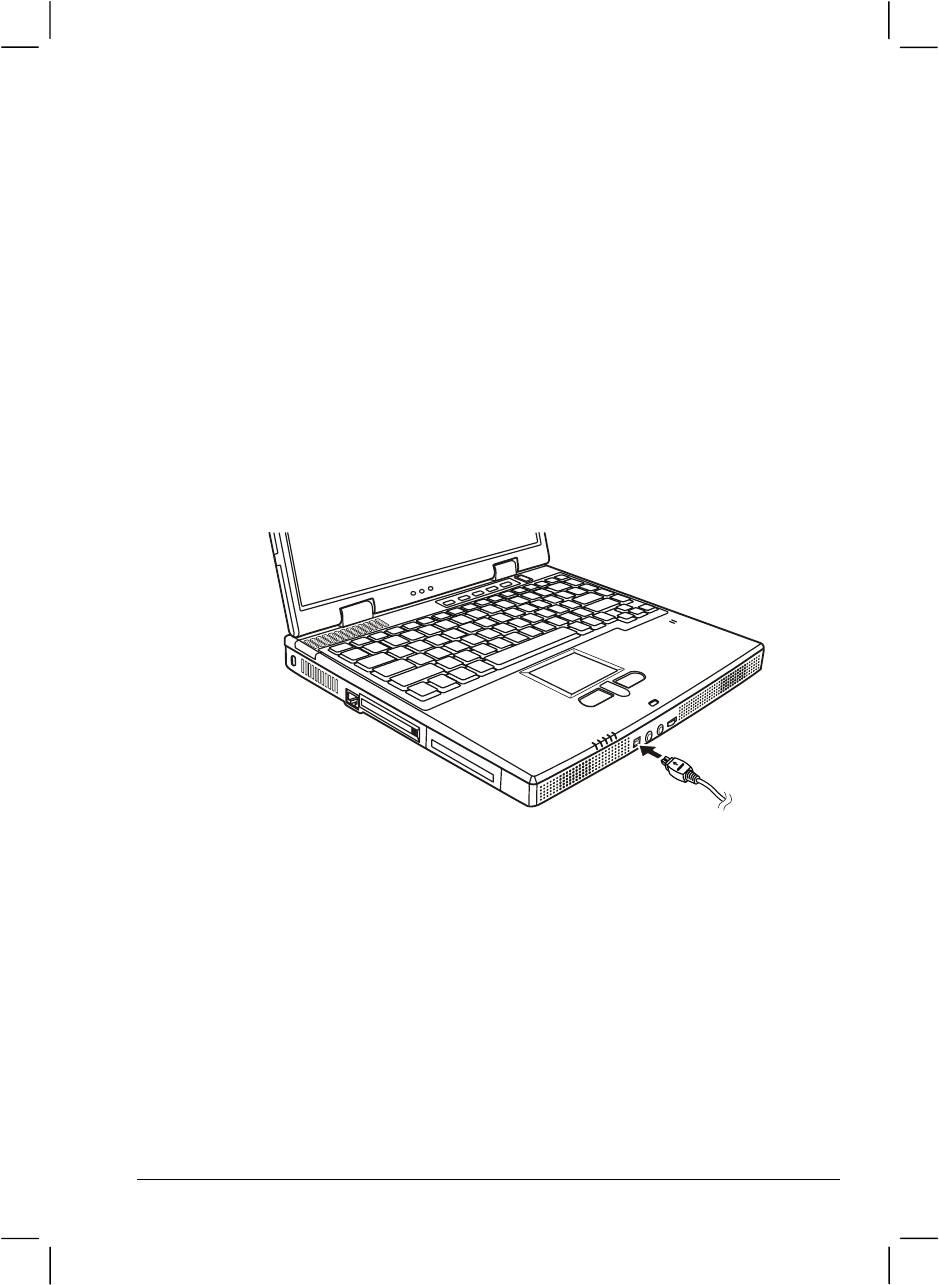
([SDQGLQJ<RXU&RPSXWHU
&RQQHFWLQJDQ,((('HYLFH
Your computer has an IEEE 1394 port on the front of the computer for
connecting 1394 devices.
IEEE 1394 is the next-generation serial bus standard, featuring high-
speed data transfer, multi-channel communication link, and “Hot Plug”
connectivity. It allows connection of up to 63 devices. The applications
include not only computer peripheral devices such as scanner, printer and
high-quality CCD, but also consumer electronic equipments such as
DVCAM and VCR.
To connect a 1394 device, simply plug the device cable to the IEEE 1394
port of the computer.

([SDQGLQJ<RXU&RPSXWHU
8VLQJ3&&DUGV
Your computer has a PC Card slot.
PC Cards are credit card-sized peripheral products based on the standards
developed by PCMCIA (Personal Computer Memory card International
Association). PCMCIA is a non-profit association for promoting the
interchangeability among mobile computers where ruggedness, low
power, and small size are critical. Ever since its foundation, the
association has been continuing their efforts to add new specifications to
the PC Card standard as new needs always arise in the market.
3&&DUG7\SH
Your computer’s PC Card slot can accommodate a typeǨcard. Typical
typeǨcards are flash memory, SRAM, modem, LAN, and SCSI cards.
&DUG%XV6XSSRUW
Your computer’s PC Card slot supports CardBus specifications. CardBus
is the 32-bit version of PC Card technology. It allows speeds of up to 133
Mbps at 33 MHz. Typical applications are SCSI host bus and high-speed
network cards.
,QVHUWLQJDQG5HPRYLQJD3&&DUG
127(
z 6RPH3&&DUGVUHTXLUHDGGLWLRQDOV\VWHPUHVRXUFHV%HIRUHXVLQJVXFK3&FDUG
\RXPD\KDYHWRIUHHRWKHUV\VWHPUHVRXUFHVIRUWKH3&&DUG
z $OWKRXJKVRPH3&&DUGVFDQEHLQVHUWHGDQGUHPRYHGZLWKRXWWXUQLQJRIIWKH
FRPSXWHU\RXFDQQRWUHPRYHRULQVWDOO3&&DUGVGXULQJ6WDQGE\PRGH
To insert a PC Card:
1. Locate the PC card slot on the left side of the computer.
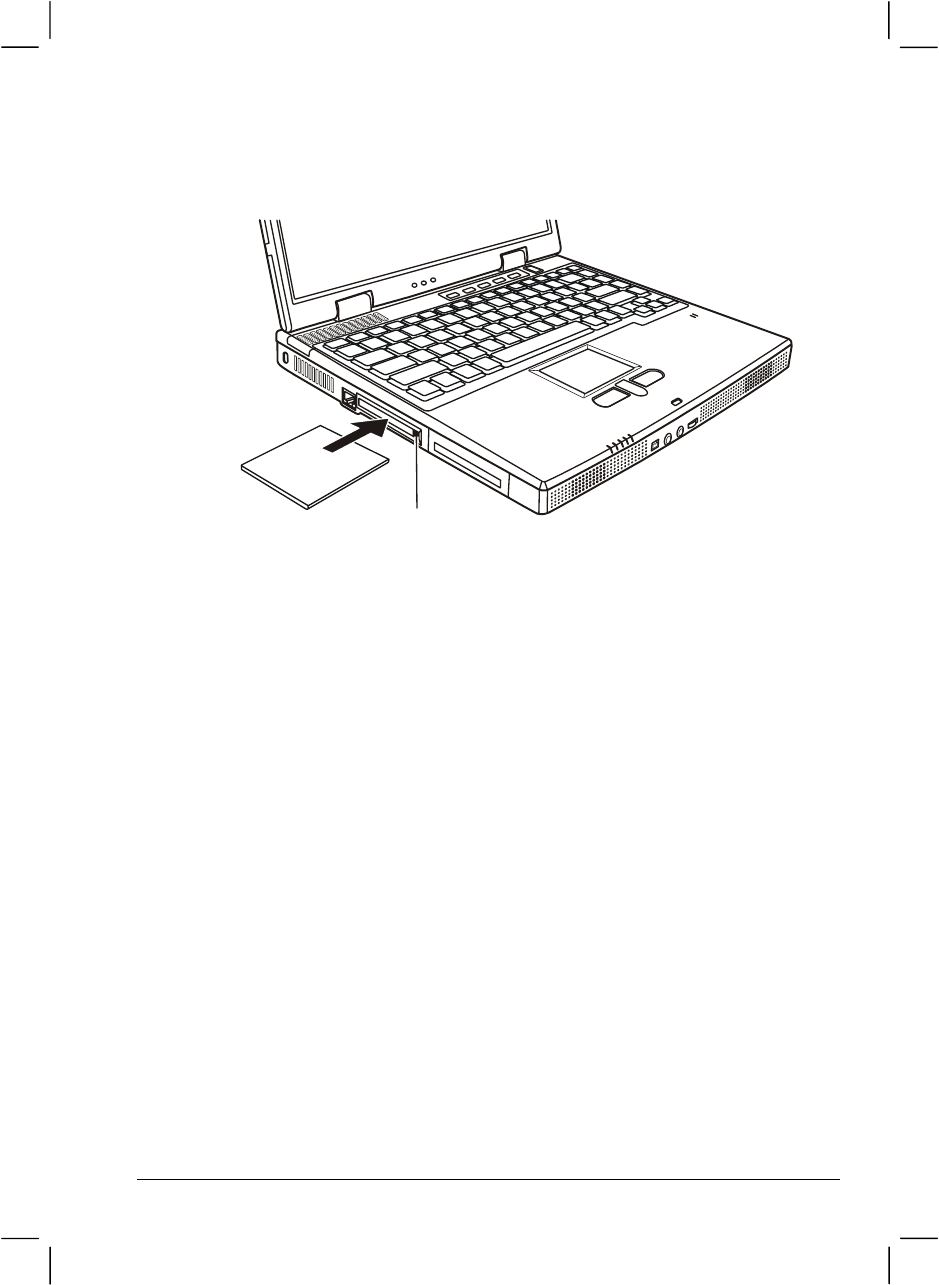
([SDQGLQJ<RXU&RPSXWHU
2. Slide the PC Card, with its label facing up, into the slot until the eject
button pops out.
3. When a new card is seated, the computer will detect it and try to
install the appropriate driver. Follow the on-screen instruction to
complete the process.
To remove a PC Card:
1. Your operating system may require you to stop the PC card before
you actually remove it. (In Windows, double-click the PC Card icon
in Control Panel to stop the card.)
2. Push the eject button and the card will slide out slightly.
3. Pull the card out of the slot.
Eject Button

([SDQGLQJ<RXU&RPSXWHU
,QWHUQDO&RPSRQHQWV8SJUDGH
You can upgrade your computer by changing the CPU or adding memory.
However, to avoid damage during the installation procedure, please ask
your dealer for help. Do not install an internal component by yourself.

CHAPTER 5
Using BIOS Setup
System Configuration Utility (SCU) is a program for configuring the
BIOS (Base Input/Output System) settings of the computer.
BIOS is a layer of software, called firmware, that translates instructions
from other layers of software into instructions that the computer hardware
can understand. The BIOS settings are needed by your computer to
identify the types of installed devices and establish special features.
This chapter tells you how to use the BIOS SCU.

8VLQJ%,266HWXS
:KHQDQG+RZWR8VH%,266HWXS
:KHQWR8VH
You need to run SCU when:
z You see an error message on the screen requesting you to run SCU.
z You want to restore the factory default settings.
z You want to modify some specific settings according to the hardware.
z You want to modify some specific settings to optimize system
performance.
6WDUWLQJ%,266HWXS
127(
z 7KH6&8VFUHHQVVKRZQLQWKLVFKDSWHUDUHIRU\RXUUHIHUHQFHRQO\7KHDFWXDO
LWHPVRUVHWWLQJVRQ\RXUFRPSXWHUPD\GLIIHU
z 7KH6&8SURJUDPPD\KDYHEHHQXSGDWHGDIWHUWKHSXEOLFDWLRQRIWKLVPDQXDO
z 7KHVHWWLQJV\RXVHOHFWLQ\RXURSHUDWLQJV\VWHPPLJKWRYHUULGHVLPLODUVHWWLQJVLQ
6&8
To run SCU, press ) when the prompt appears on the screen during
system startup. The prompt shows up on the screen for only a few
seconds. You must press ) quickly. The SCU main menu appears as
shown next.
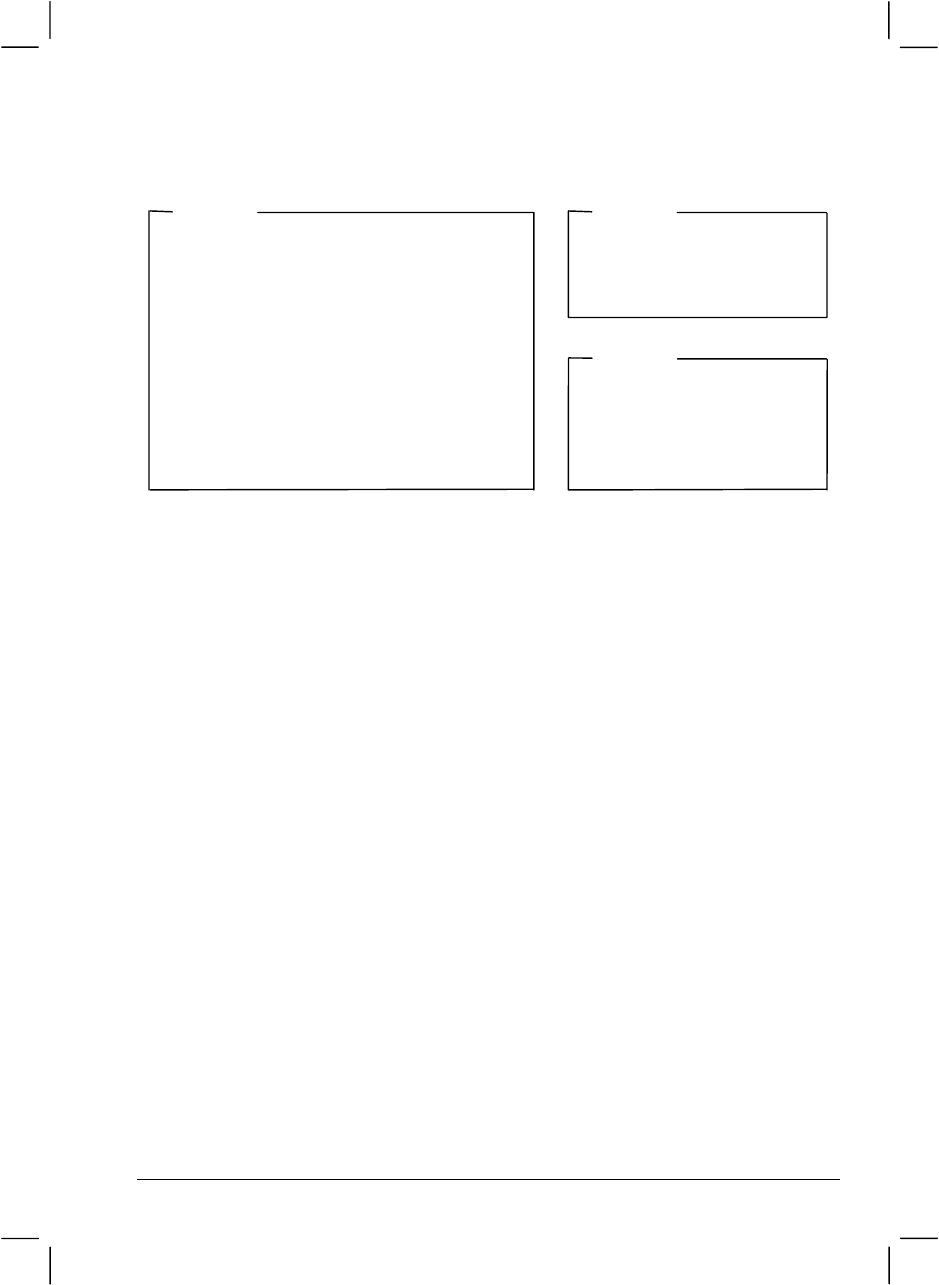
8VLQJ%,266HWXS
Main Advanced Security Boot Exit
System
CPU = Pentium 4
CPU Speed = 1700 MHz
SYSTEM BIOS = 0.90a
EC BIOS = 2.03
Devices
Primary Master = 1672 GB
CD-ROM = NONE
Serial Port = IR2, 2200, IRQ 3
Parallel Port = LPT1, 378, IRQ 7
Memory
Base = 640 KB
Extended = 125952 KB
Video = 32768 KB
Total RAM = 159744 KB
Cache (Ext) = 0 KB
Configure main conditions (date and time, hard disk type...etc)
0RYLQJ$URXQGDQG0DNLQJ6HOHFWLRQV
You must go through two or three levels to complete the setting for an
item. In most cases, there are three levels: menu title, pull-down menu,
and submenu.
To move around and make selections, you can use the keyboard.
8VLQJWKHNH\ERDUG
Keyboard information can be found at the bottom of the screen. A brief
description of keyboard usage is listed below:

8VLQJ%,266HWXS
Key Function
←, →Selects a menu title.
↑, ↓1) Selects an item or option.
2) Brings up/down the value.
(QWHU 1) Brings up the sub-menu when an item with the arrowsign is
selected.
2) Opens or closes the option window when an item is selected.
7DE Jumps from one item to another.
(VF 1) Exits SCU.
2) Returns to the previous menu if in a sub-menu.
3) Closes the options window if one is open.
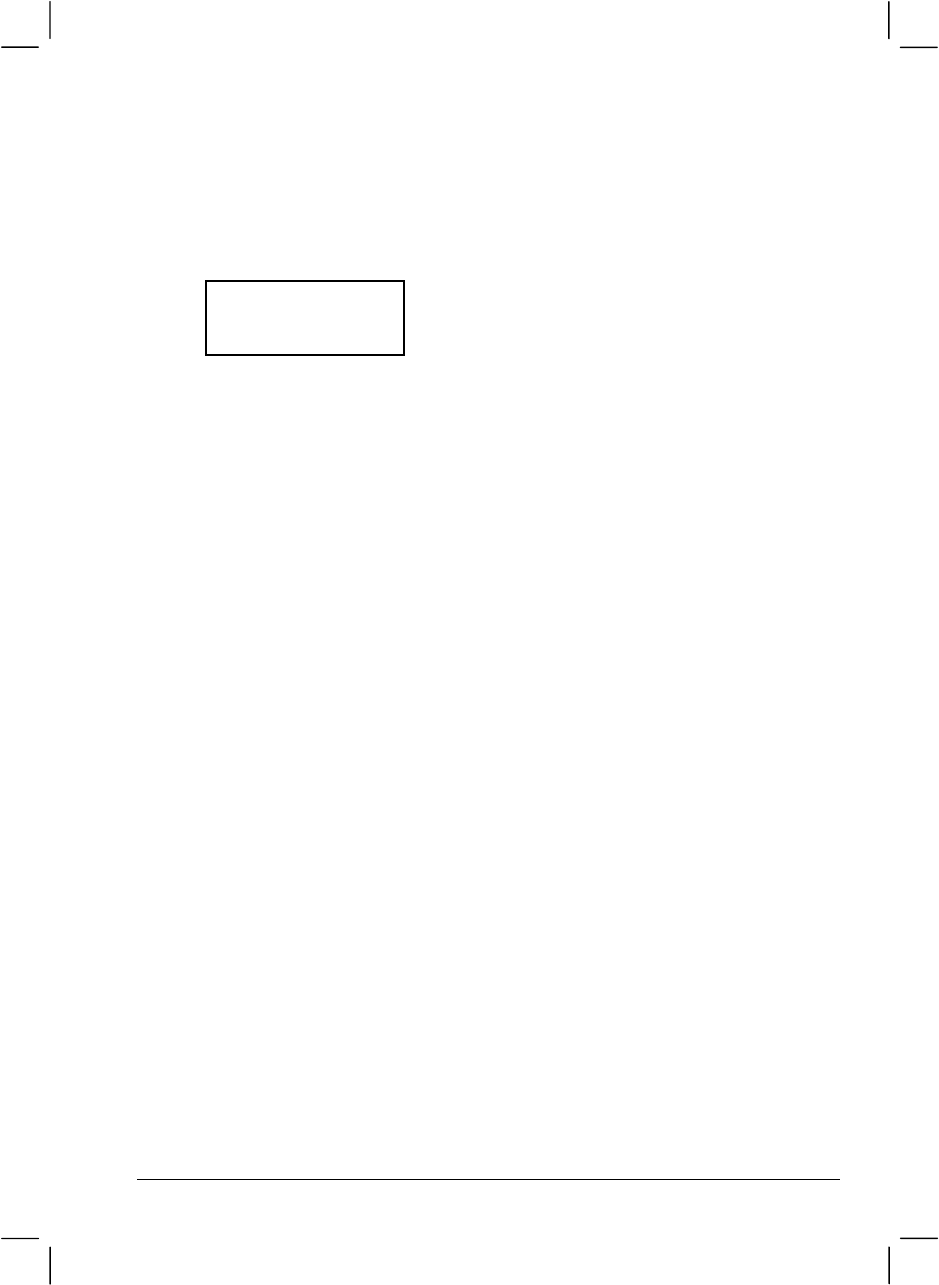
8VLQJ%,266HWXS
0DLQ0HQX
The Main pull-down menu contains the basic configuration settings of the
system.
Date and Time
√
√√
√Internal Numlock
Date and Time sets the system date and time.
Internal Numlock sets if you can enter a number when Num Lock is
turned off. When this item is enabled, you can press and hold )Q and then
press a letter key to enter a number even if Num Lock is turned off. When
this item is disabled, you cannot enter a number with the above method. A
check mark (9) indicates Enabled; an underline (_) indicates Disabled.
The default setting is Enabled.
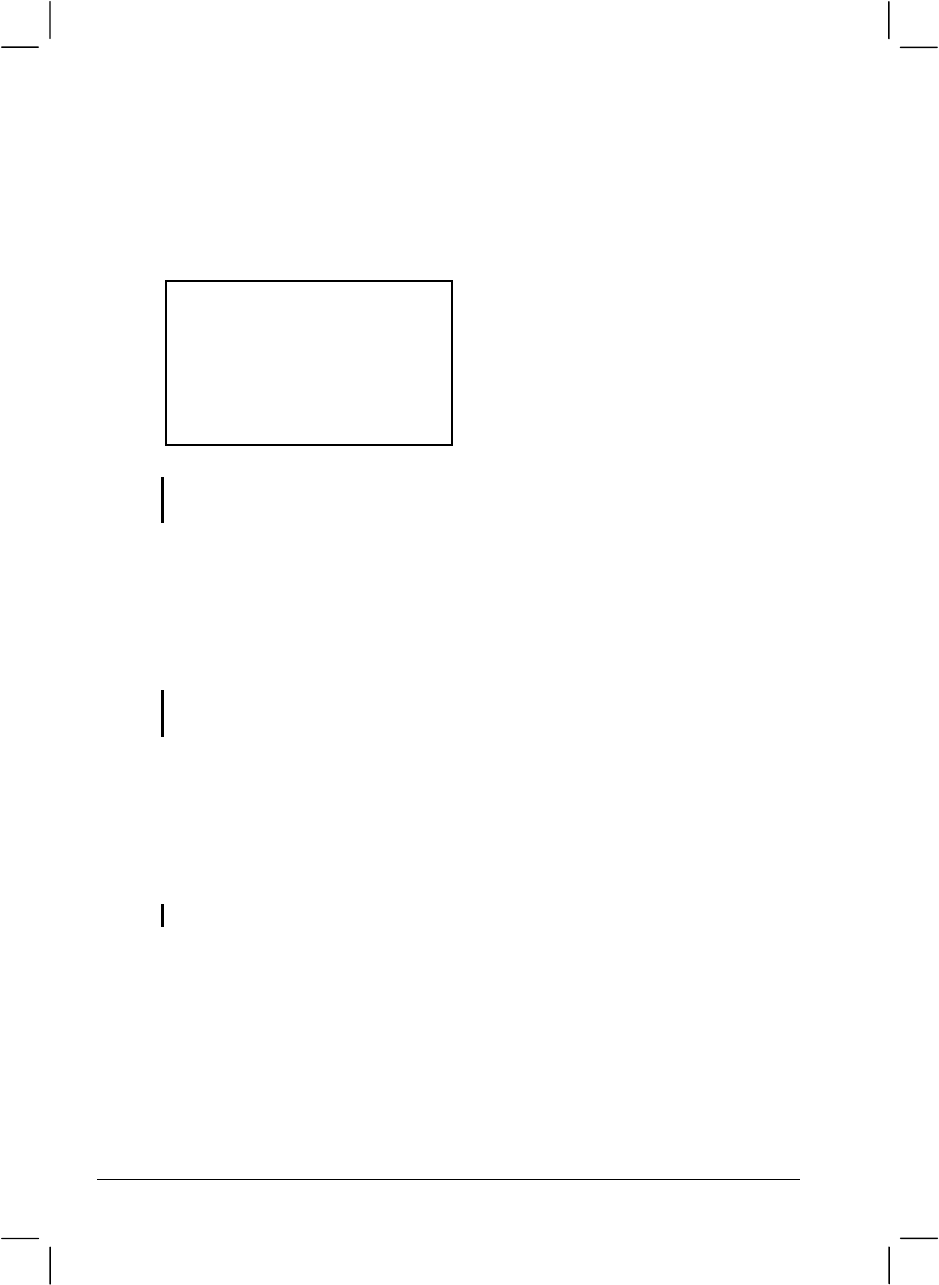
8VLQJ%,266HWXS
$GYDQFHG0HQX
The Advanced pull-down menu contains the I/O configuration settings of
the system.
_ Processor Serial Number
Geyserville Support
TV SYSTEM
COM Ports
LPT Port
Shared Video Memory
USB Emulation
127(,QFRUUHFWVHWWLQJVLQWKLVPHQXPD\FDXVH\RXUV\VWHPWRPDOIXQFWLRQ<RXDUH
DGYLVHGWRNHHSWKHGHIDXOWVHWWLQJV
Processor Serial Number allows you to enable or disable the display of
the Processor Serial Number during POST. The Processor Serial Number
is an electronic number incorporated into the new Pentium III and
Pentium 4 processors. A check mark (9) indicates Enabled; an underline
(_) indicates Disabled. The default setting is Disabled.
127(7KLVLWHPLVDYDLODEOHRQO\LIWKH&38RI\RXUFRPSXWHUVXSSRUWVWKH3URFHVVRU
6HULDO1XPEHUIHDWXUH
Geyserville Support configures the Geyserville feature of the CPU.
Geyserville lets you customize high performance computing on your
computer. When computer is using AC power, CPU will run in full speed.
When computer is using battery power, CPU will lower down to conserve
battery life while maintaining a high level of performance.
127(7KLVLWHPLVDYDLODEOHRQO\ZKHQWKH&38VXSSRUWVWKH*H\VHUYLOOHIHDWXUH
TV System sets the TV mode when a TV is used for display output.
Select PAL for use in UK and Europe, NTSC for use in other areas. The
default setting is PAL.
COM Ports configures the COM ports of the computer.
COM B I/O Settings sets the I/O address and the interrupt request
line (IRQ) settings of the COM port. The options are Disabled,

8VLQJ%,266HWXS
IR1/3F8/IRQ 4, IR2/2F8/IRQ 3, IR3/3E8/IRQ 4 and IR4/2E8/IRQ 3.
The default setting is IR2/2F8/IRQ 3.
Mode Setting For COM B sets the communication compatibility
mode according to the type of the IR device to be connected. The
options are ASK IR and FAST IR, The default setting is FAST IR. This
item is not valid for setting if the COM B I/O Settings item is set to
Disabled.
LPT Port configures of the parallel port of the computer.
Port sets the I/O address and the interrupt request line (IRQ) settings
of the parallel port. The options are Disabled, LPT1/378/IRQ 7,
LPT2/278/IRQ 5, LPT3/3BC/IRQ 7.
Mode sets the operating mode for the parallel port according to the
type of the parallel device to be connected. You system supports EPP
(Enhanced Parallel Port) and ECP (Extended Capabilities Port)
standards, which turn the standard parallel port into a high speed bi-
directional peripheral port. The options are Standard AT,
Bidirectional, Enhanced Parallel and Extended Capabilities. This
item is not valid for setting if the Port item is set to Disabled.
DMA Setting For ECP Mode sets the DMA (Direct Memory
Access) channel of the ECP mode. The options are DMA 0, DMA 1
and DMA 3. This item is not valid for setting if the Port item is set to
Disabled and the Mode item is not set to Extended Capabilities.
Shared Video Memory sets size of the video memory shared from the
system memory. The options are 8M, 16M, 32M and 64M, and the default
setting is 32M.
USB Emulation enables or disables the system’s support for the USB
port in DOS mode.
Enable USB Port enables or disables the USB port in DOS mode.
The default setting is Enabled.
USB Keyboard enables or disables the USB keyboard in DOS
mode. The default setting is Enabled. This item is not valid for setting
if the Enable USB Port item is disabled.

8VLQJ%,266HWXS
USB FDD enables or disables the USB floppy disk drive in DOS
mode. The default setting is Enabled. This item is not valid for setting
if the Enable USB Port item is disabled.
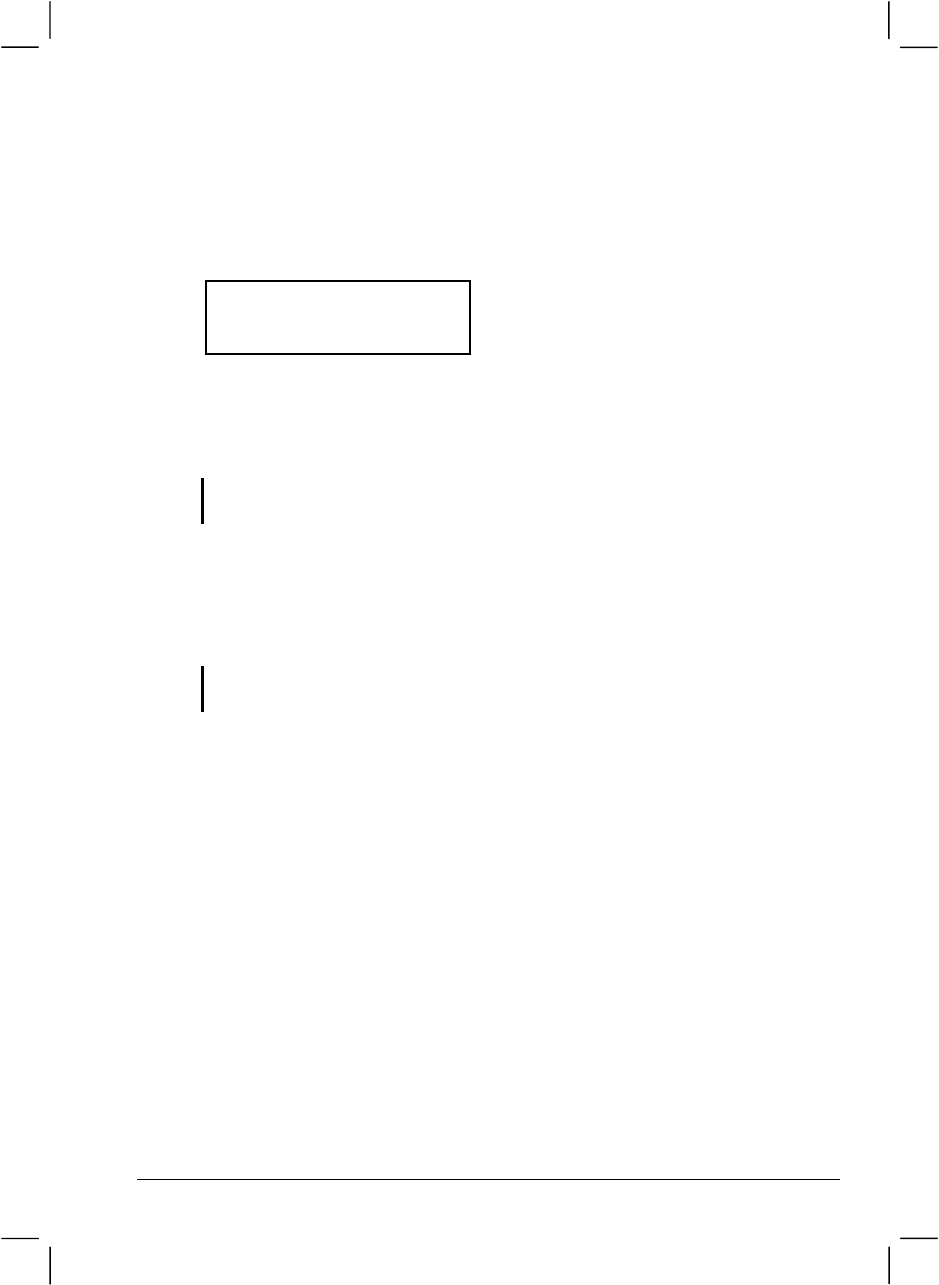
8VLQJ%,266HWXS
6HFXULW\0HQX
The Security pull-down menu contains the security settings, which
safeguard your system against unauthorized use.
Set Password
_ Hard Disk Boot Sector
Set Password sets the password. When typing the password, first make
sure that Num Lock is off, then type the password in the entry fields and
press (QWHU. Confirm your password by typing it again and pressing (QWHU.
127(,IWKH(QDEOH3DVVZRUGWR3RZHU2QLWHPLVHQDEOHGWKHVHWSDVVZRUGLV
DOZD\VUHTXLUHGWRERRWWKHFRPSXWHU
Hard Disk Boot Sector helps prevent computer viruses by protecting
the hard disk boot sector (partition table) from any change if enabled. A
check mark (9) indicates Enabled; an underline (_) indicates Disabled.
The default setting is Disabled.
&$87,21'LVDEOHWKLVLWHPEHIRUHLQVWDOOLQJDQRSHUDWLQJV\VWHPUXQQLQJ)GLVNRU
)RUPDWSURJUDP2WKHUZLVHWKHLQWHQGHGDFWLRQZLOOIDLO
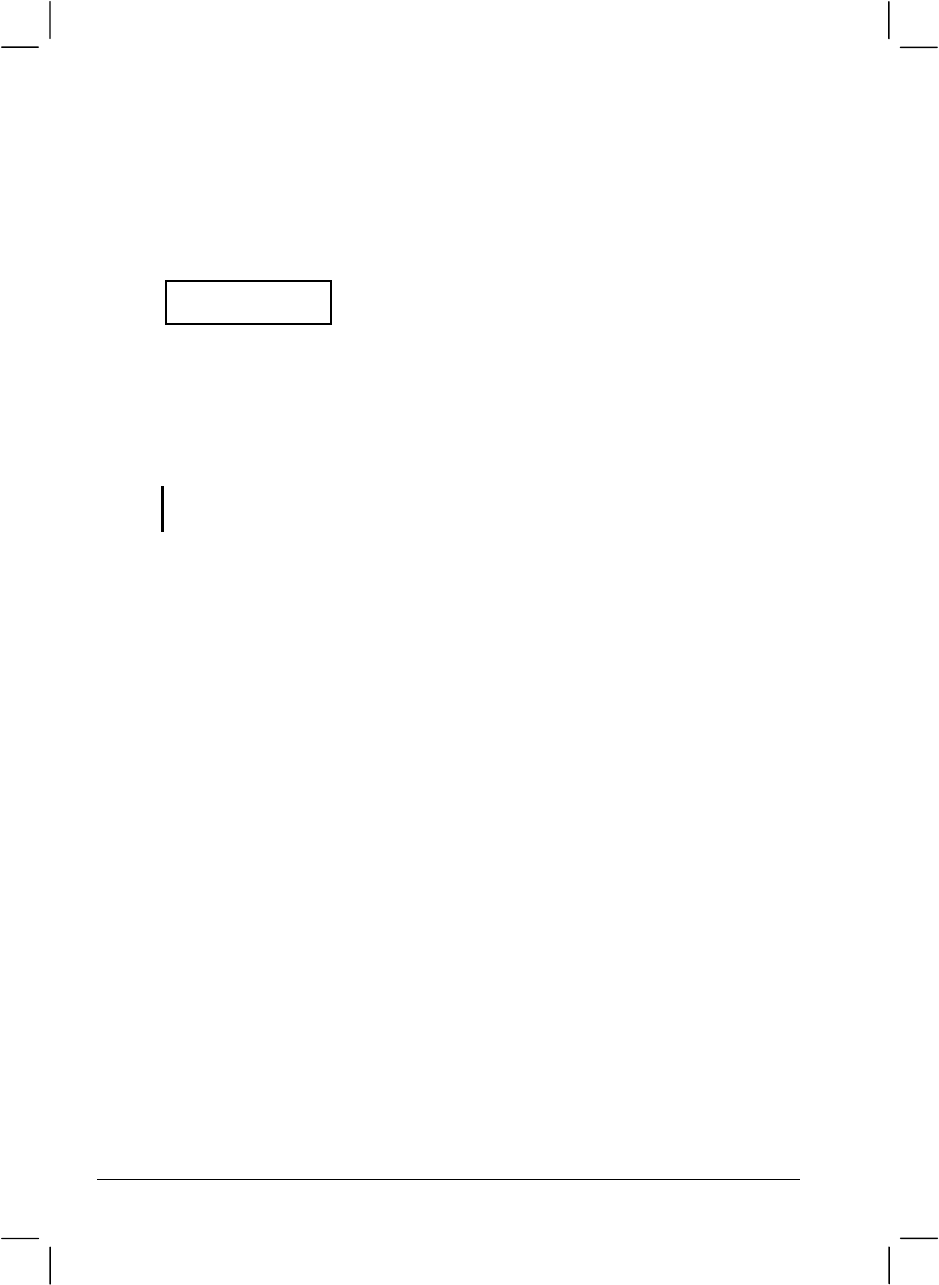
8VLQJ%,266HWXS
%RRW0HQX
The Boot pull-down menu sets the sequence of the devices to be searched
for the operating system.
Boot Device
Boot Device sets the sequence of booting. The devices include Hard
Disk C, CD-ROM Drive, Floppy Disk Drive and LAN Boot. If you set the
first boot device to LAN Boot, the system will boot from the LAN server
first.
127(,I\RXVHWDOOERRWLQJRSWLRQVWRWKHVDPHGHYLFHWKHQWKHFRPSXWHUZLOOWU\WR
ERRWIURPWKDWGHYLFHRQO\
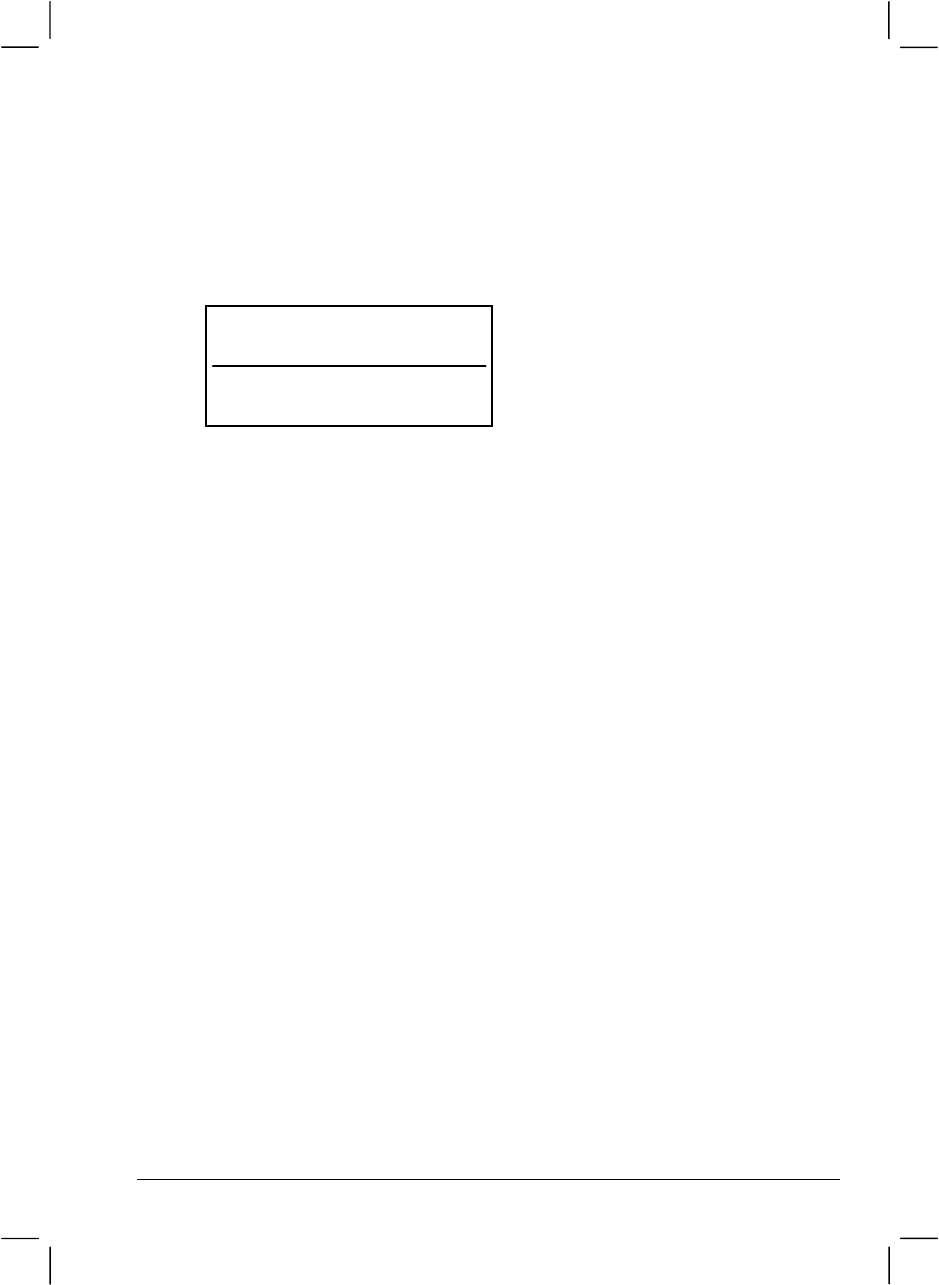
8VLQJ%,266HWXS
([LW0HQX
The Exit pull-down menu displays ways of exiting SCU. After finished
with your settings, you must save and exit so that the new settings can
take effect.
Save Changes and Exit
Discard Changes and Exit
Get Default Values
Load Previous Values
Save Changes and Exit saves the changes you have made and exits
SCU.
Discard Changes and Exit exits SCU without saving the changes you
have made.
Get Default Values loads factory default values for all the items.
Load Previous Values loads CMOS values before running SCU.

CHAPTER 6
Installing Software Drivers
To take full advantage of the unique features of your computer, some
operating systems require custom software, known as drivers, to be
installed.
If you purchased the computer with Windows pre-installed, your dealer
may have already installed the drivers. If not, you need to install the
drivers using the CD supplied with your computer.
This chapter describes how to install the drivers.
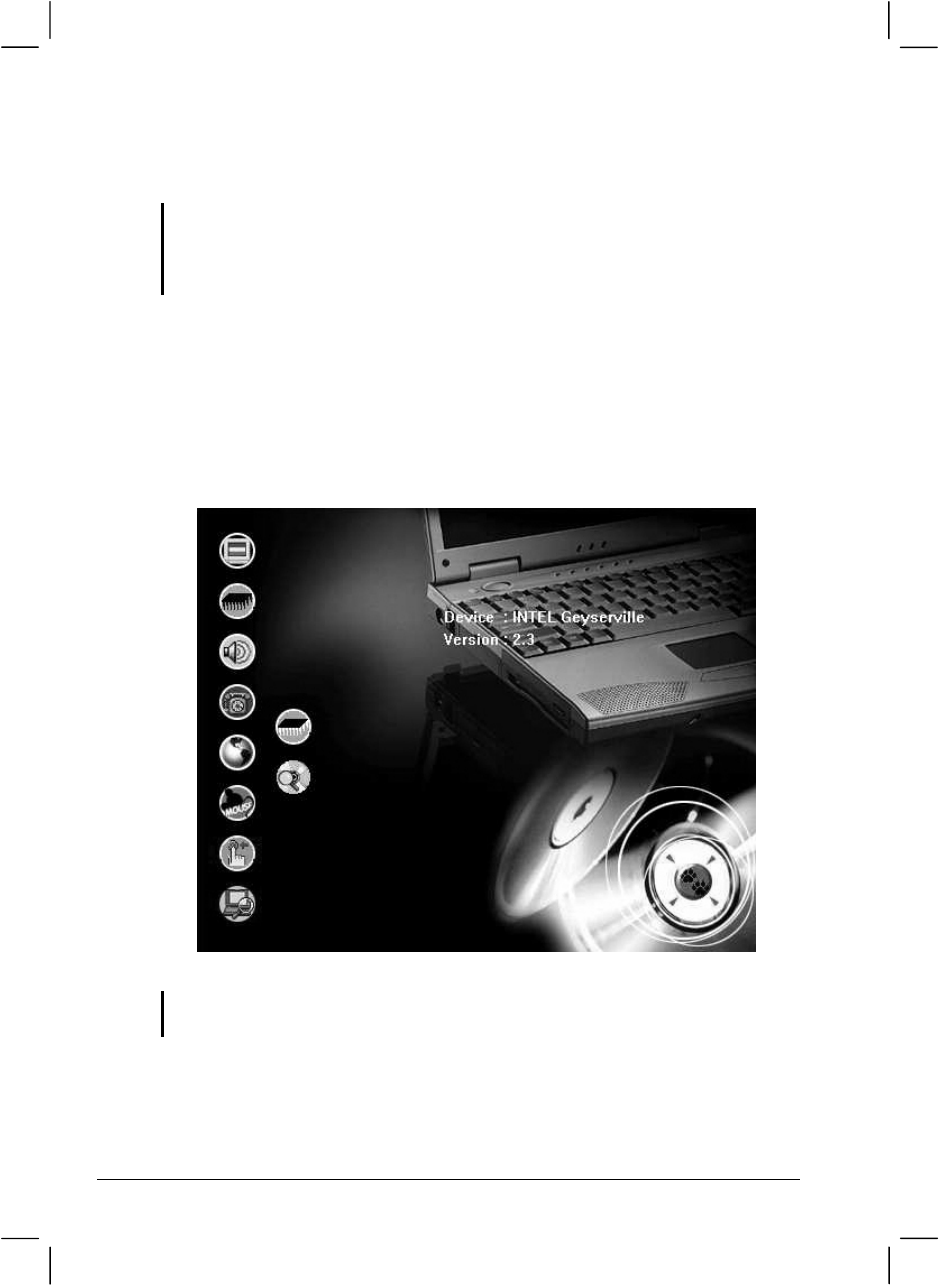
,QVWDOOLQJ6RIWZDUH'ULYHUV
+RZWR8VHWKH&'
127(
z 7KHGULYHUVPD\KDYHEHHQXSGDWHGDIWHUWKLVPDQXDOZDVSXEOLVKHG)RUGULYHU¶V
XSJUDGHSOHDVHFRQWDFW\RXUGHDOHU
z 7KLV&'VXSSRUWV:LQGRZV:LQGRZV0HDQG:LQGRZV;3RQO\
An autorun program is provided on the driver CD to help you easily
install the drivers. As you insert the CD, the autorun program
automatically starts. If you need to start the program manually, run the
Setup.exe program on the CD.
The main screen appears as shown next:
127(7KHLFRQVDSSHDULQJRQWKHOHIWVLGHGHSHQGRQWKHRSHUDWLQJV\VWHP\RXDUH
XVLQJDVZHOODVWKHDYDLODELOLW\RIWKHKDUGZDUHGHYLFHRQ\RXUFRPSXWHU
To install the intended driver, just click on the corresponding icon on the
left side and the installation will start. The icons and drivers are described
next:
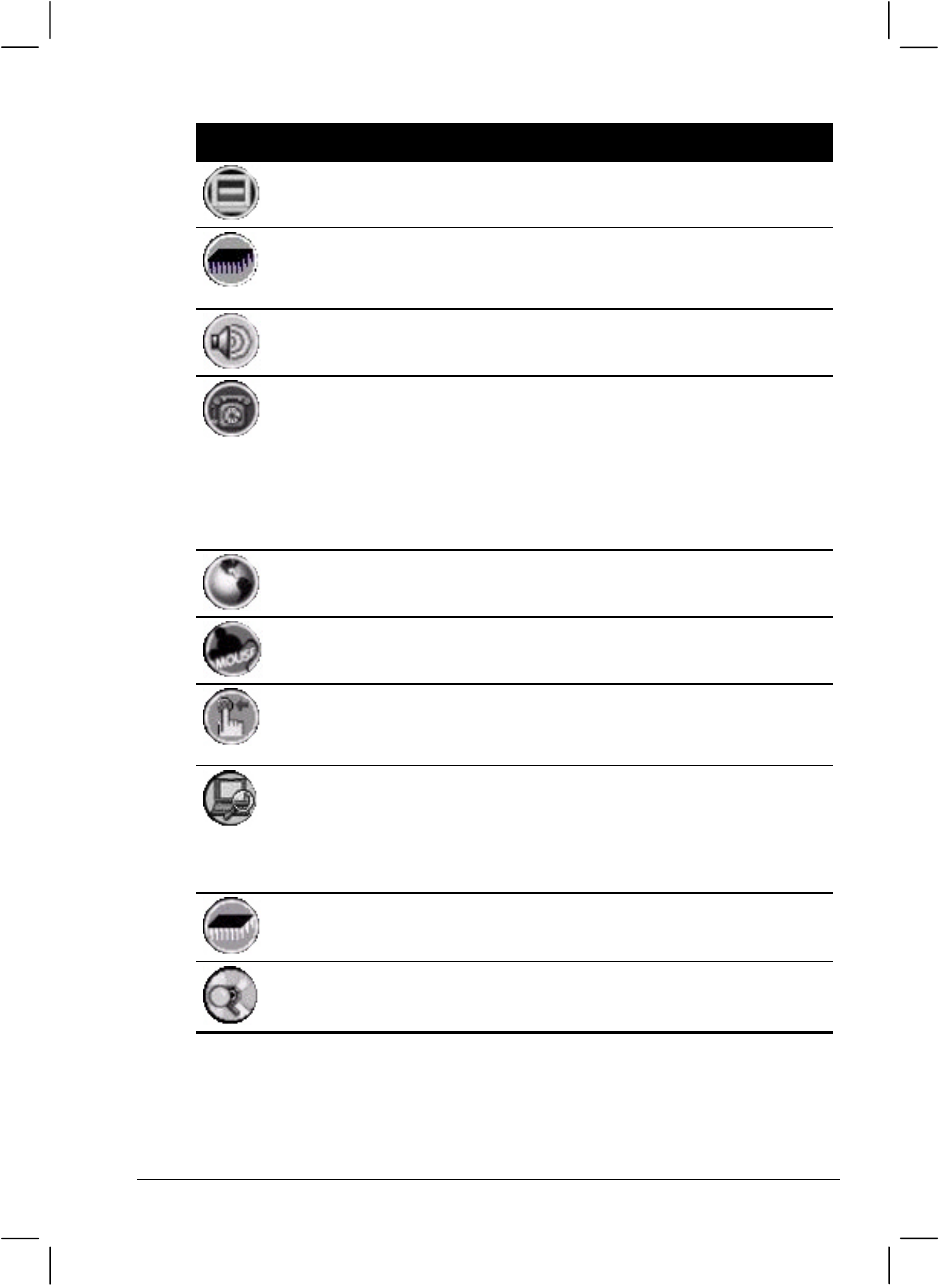
,QVWDOOLQJ6RIWZDUH'ULYHUV
Icon Name Description
Video driver Installs the driver that allows you to select high-
resolution displays with richer colors.
AGP driver Installs the AGP 4X/133 driver to ensure the full
function of the VGA and other drivers.
127(7KLVIXQFWLRQLVIRU:LQGRZV;3RQO\
Audio driver Installs the driver that allows you to take full
advantage of the audio subsystem.
Modem driver Installs the driver that allows you to use the modem
function of the computer.
127()RU:LQGRZV0HVHOHFW6SHFLI\WKHORFDWLRQ
RIWKHGULYHU$GYDQFHGZKHQWKH$GG1HZ+DUGZDUH
:L]DUGZLQGRZDSSHDUVWKHQFOLFN1H[W&OLFN1H[W
DJDLQDQGWKHV\VWHPZLOODXWRPDWLFDOO\ORFDWHWKHFRUUHFW
GULYHU
LAN driver Installs the driver that allows you to use the network
function of the computer.
Touchpad
driver
Installs the driver that allows you to take full
advantage of the touchpad features.
Easy Start
Button driver
Allows you to define the Easy Start buttons. (For
information on installing and using the utility, see
“Other Drivers and Utilities” later in this chapter.)
Power
Management
utility
Allows you to optimize the power consumption of
CPU.
127(7KLVLWHPLVDYDLODEOHRQO\ZKHQWKH&38VXSSRUWV
WKH*H\VHUYLOOHIHDWXUHDQG\RXGRQRWQHHGWRLQVWDOOWKLV
GULYHUZKHQXVLQJ:LQGRZV;3
IR Module
Select guide
Shows how to set the IR module for the operating
system used.
Browse CD Browses the contents of this CD.
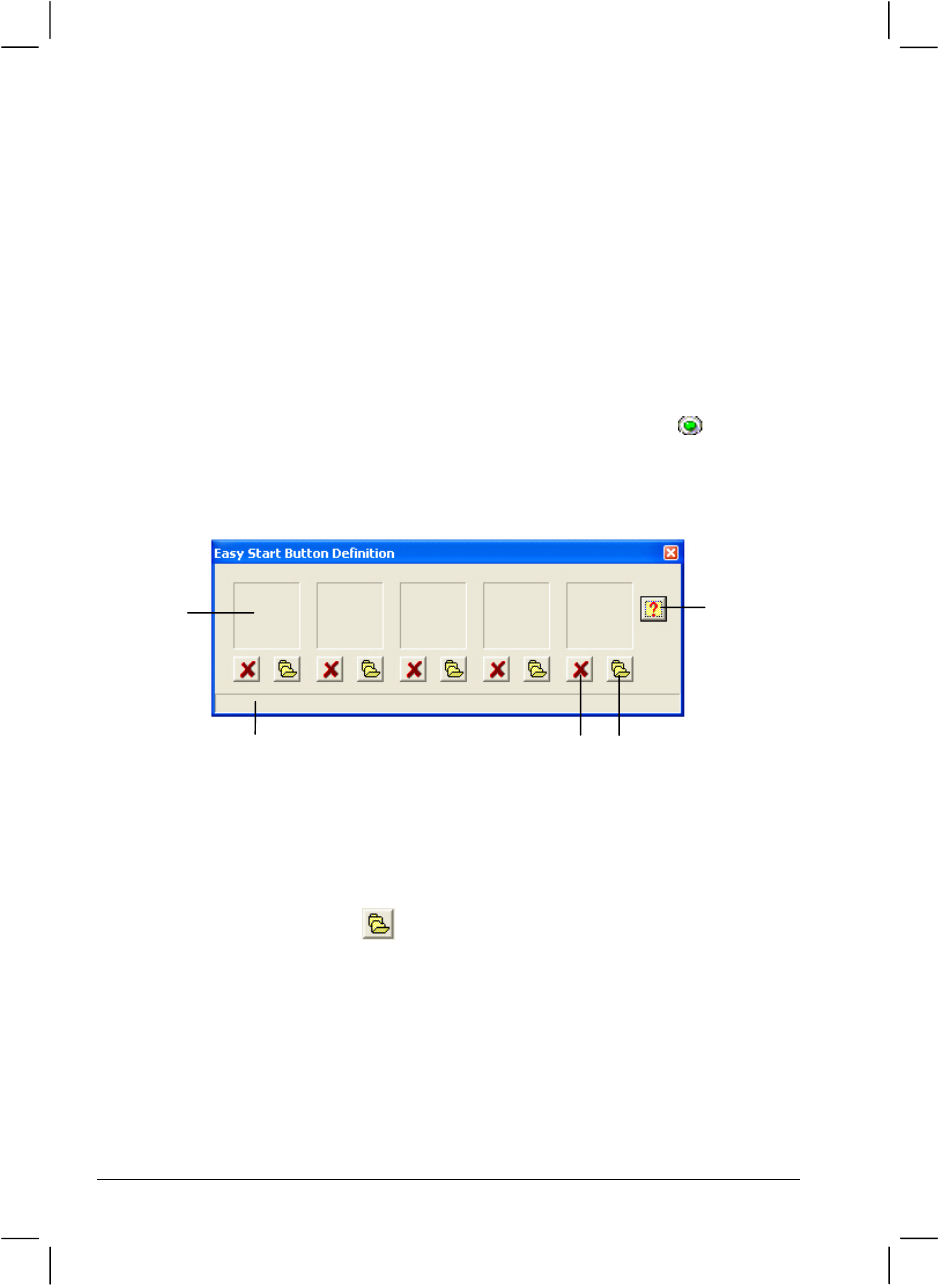
,QVWDOOLQJ6RIWZDUH'ULYHUV
2WKHU'ULYHUVDQG8WLOLWLHV
(DV\6WDUW%XWWRQ8WLOLW\
The ESB (Easy Start Button) utility allows you to define the five Easy
Start buttons.
8VLQJWKH(6%8WLOLW\
To start the utility, double-click the Easy Start Button icon on the
taskbar. The Easy Start Button Definition window appears as shown
next.
Defining the buttons:
The five boxes in the window represent the five user-definable buttons.
To assign a program to a button, you can drag and drop the program icon
or shortcut icon from the Windows desktop to the corresponding box. Or
you can click the Open icon under the box to pop up the Open dialog
box as shown next and select the desired program. Then, click Open to
complete the process.
Box
Program Location / Instruction
Version
Information
OpenCancel
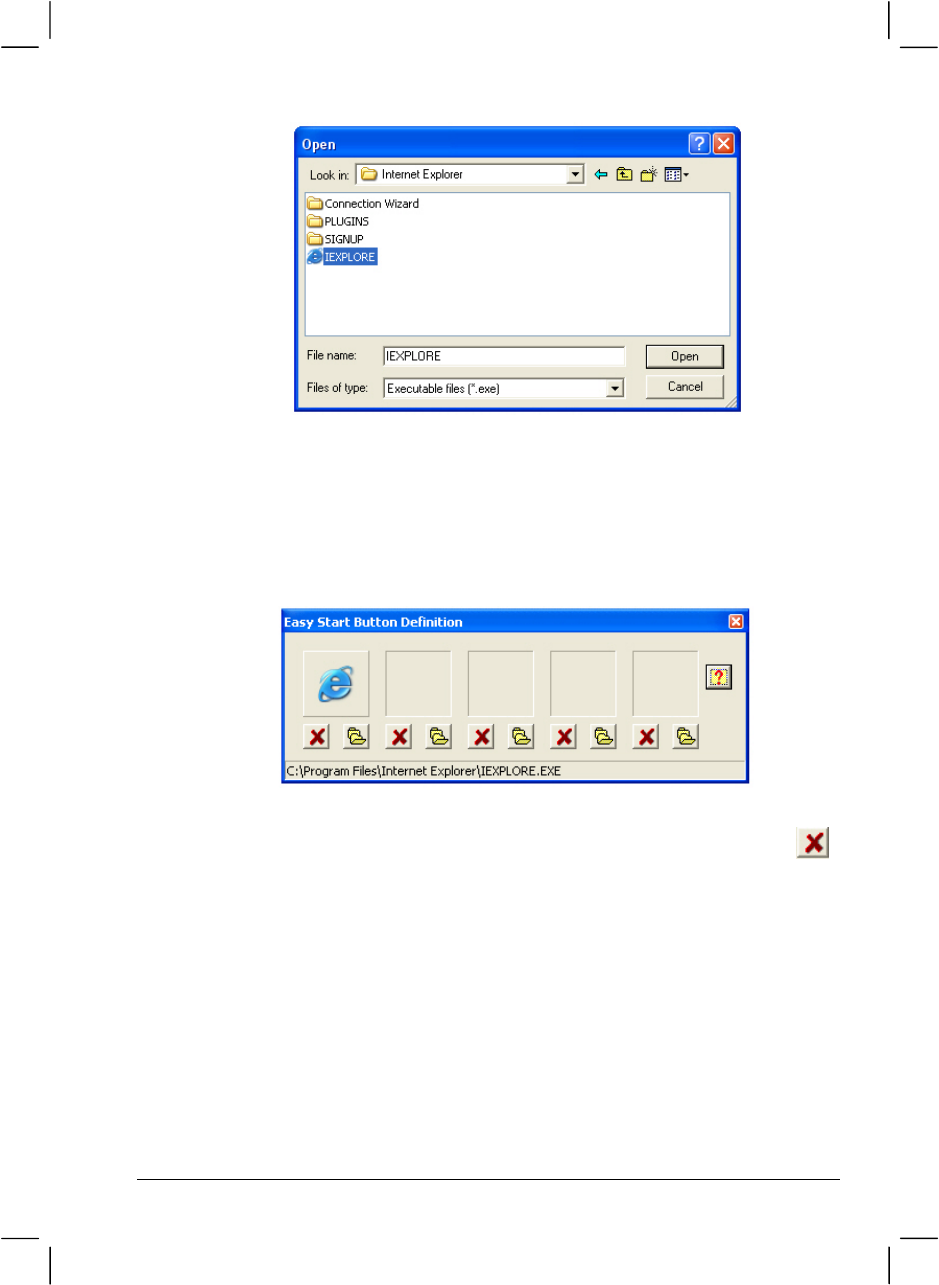
,QVWDOOLQJ6RIWZDUH'ULYHUV
The appropriate icon will then appear in the box as shown next. To launch
the program, you can simply press the corresponding Easy Start button,
or, if the Easy Start Button Definition window is open, you can
double-click the box containing the icon.
If you want to cancel the assignment of a program, click the Cancel
icon under the box.
:LUHOHVV/$18WLOLW\
Depending on your model, a Mini PCI card may be supplied with your
computer.
Through the wireless LAN utility, the Mini PCI card allows you to
wirelessly connect the Internet for the mobile data communication as an
alternative for the wired network.

,QVWDOOLQJ6RIWZDUH'ULYHUV
To use the wireless LAN utility, first make sure that the correct driver is
installed.

CHAPTER 7
Caring for the Computer
Taking good care of your computer will ensure a trouble-free operation
and reduce the risk of damage to your computer.
This chapter gives you guidelines covering these areas of maintenance:
z How to protect the computer
z What to note when using and storing the computer
z How to clean the computer
z What to note when using the battery pack
z What to note when traveling with the computer

&DULQJIRUWKH&RPSXWHU
3URWHFWLQJWKH&RPSXWHU
To safeguard the integrity of your computer data as well as the computer
itself, you can protect the computer in several ways as described in this
section.
8VLQJWKH3DVVZRUG
The power-on password protects your computer against unauthorized
use. If the password is set, the prompt requesting for the password appears
on the screen whenever the computer is turned on.
The password is set via the BIOS setup program. See “Security Menu” in
Chapter 5 for instructions.
8VLQJWKH&DEOH/RFN
You can use a Kensington-type cable lock to protect your computer
against theft. The cable lock is available in most computer stores.
To use the lock, loop the lock cable around a stationary object such as a
table. Insert the lock to the Kensington lock hole and turn the key to
secure the lock. Store the key in a safe place.
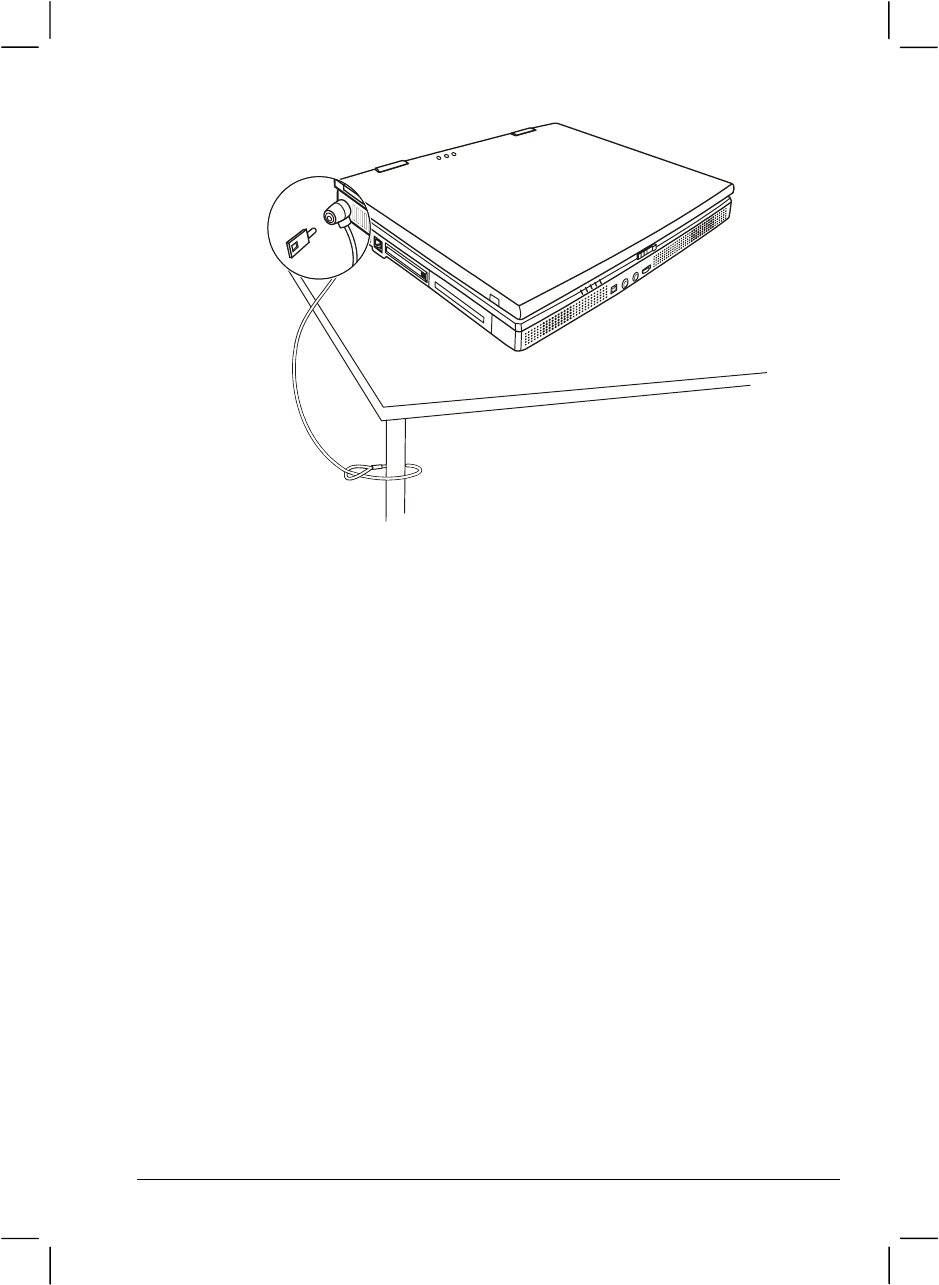
&DULQJIRUWKH&RPSXWHU
8VLQJDQ$QWL9LUXV6WUDWHJ\
New viruses are always being developed nowadays and they are attacking
computers even more easily with emails so commonly used worldwide.
The security feature of the BIOS protects the boot sector of the hard disk.
To enable the function, see “Disk Menu” in Chapter 5 for instructions.
You can also install a virus-detecting program to monitor potential
viruses that could damage your files.

&DULQJIRUWKH&RPSXWHU
7DNLQJ&DUHRIWKH&RPSXWHU
/RFDWLRQ*XLGHOLQHV
z Use the computer where the temperature is between 10°C (50°F) and
35°C (95°F).
z Avoid placing the computer in a location subject to high humidity,
extreme temperatures, mechanical vibration, direct sunlight, or heavy
dust.
z Do not cover or block any ventilation openings on the computer. For
example, do not place the computer on a bed, sofa, rug, or other
similar surface. Otherwise, overheating may occur that results in
damage to the computer.
z Keep the computer at least 13 cm (5 inches) away from electrical
appliances that can generate a strong magnetic field such as a TV,
refrigerator, motor, or a large audio speaker.
z Do not move the computer abruptly from a cold to a warm place. A
temperature difference of more than 10°C (18°F) will cause
condensation inside the unit, which may damage the storage media.
z Do not place the computer on an unsteady surface.
*HQHUDO*XLGHOLQHV
z Do not place heavy objects on top of the computer when it is closed as
this may damage the display.
z The screen surface is easily scratched. Do not use paper towels to
clean the display. Avoid touching it with your fingers, pen, or pencil.
z To maximize the life of the backlight in the display, allow the
backlight to automatically turn off as a result of power management.
Avoid using a screen saver or other software that prevents the power
management from working.

&DULQJIRUWKH&RPSXWHU
&OHDQLQJ*XLGHOLQHV
z Never clean the computer with its power on.
z Use a soft cloth moistened with water or a non-alkaline detergent to
wipe the exterior of the computer.
z Gently wipe the display with a soft, lint-free cloth. Do not use alcohol
or detergent on the display.
z Dust on the IR port can interfere with data transfer. Wipe the port
with a soft, dry cloth.
z Dust or grease on the touchpad can affect its sensitivity. Clean the pad
by using adhesive tape to remove the dust and grease on its surface.
%DWWHU\3DFN*XLGHOLQHV
z Recharge the battery pack when it is nearly discharged. When
recharging, make sure the battery pack is fully charged. Doing so may
avoid harm to the batter pack.
z Operate the computer with the battery pack installed even when using
external power. This ensures that the battery is fully charged.
z If you will not be using the computer for a long period of time (more
than two weeks), remove the battery pack from the computer.
z If you remove the battery pack, make sure the battery terminals do not
contact any conductors such as metal objects or water. Otherwise, the
battery may become unusable as a result of a short circuit.
z If you need to store the battery pack, store it in a cool, dry place.
Never allow the temperature to exceed 60°C (140°F).
z Do not leave the battery pack in storage for more than 6 months
without recharging it.

&DULQJIRUWKH&RPSXWHU
:KHQ7UDYHOLQJ
z Before traveling with your computer, make a backup of your hard
disk data into floppy disks or other storage devices. As an added
precaution, bring along an extra copy of your important data.
z Make sure the battery pack is fully charged.
z Make sure the computer is turned off and the top cover is securely
closed.
z Do not leave objects in between the keyboard and closed display.
z Disconnect the AC adapter from the computer and take it with you.
Use the AC adapter as the power source and as a battery-charger.
z Hand-carry the computer. Do not check it in as luggage.
z If you need to leave the computer in the car, put it in the trunk of the
car to avoid exposing the computer to excessive heat.
z When going through airport security, it is recommended that you
send the computer and floppy disks through the X-ray machine (the
device you set your bags on). Avoid the magnetic detector (the device
you walk through) or the magnetic wand (the hand-held device used
by security personnel).
z If you plan to travel abroad with your computer, consult your dealer
for the appropriate AC power cord for use in your country of
destination.

CHAPTER 8
Troubleshooting
Computer problems can be caused by hardware, software, or both. When
you encounter any problem, it might be a typical problem that can easily
be solved.
This chapter tells you what actions to take when solving common
computer problems. It is divided into three sections:
z Preliminary checklist
z Solving common problems
z Resetting the computer

7URXEOHVKRRWLQJ
3UHOLPLQDU\&KHFNOLVW
Here are helpful hints to follow before you take further actions when you
any encounter problem:
z Try to isolate which part of the computer is causing the problem.
z Make sure that you turn on all peripheral devices before turning on
the computer.
z If an external device has a problem, make sure that the cable
connections are correct and secure.
z Make sure that the configuration information is properly set in the
BIOS setup program.
z Make sure that all the device drivers are correctly installed.
z Make notes of your observations. Are there any messages on the
screen? Do any indicators light? Do you hear any beeps? Detailed
descriptions are useful to the service personnel when you need to
consult one for assistance.
If any problem persists after you follow the instructions in this chapter,
contact an authorized dealer for help.
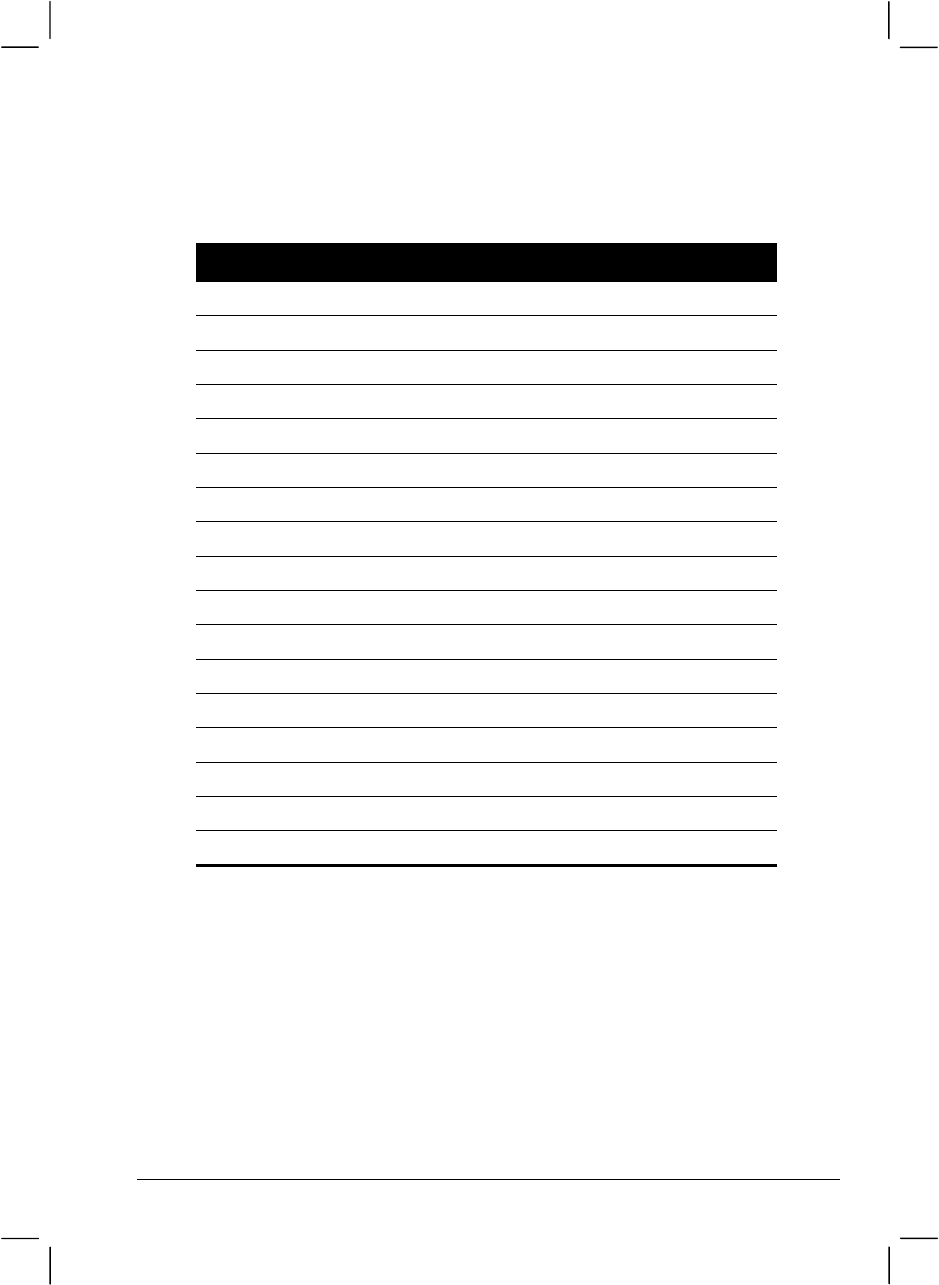
7URXEOHVKRRWLQJ
6ROYLQJ&RPPRQ3UREOHPV
For easy reference, the problems are divided into these categories.
Problem Type Go to
Battery Problems P. 8-4
CD Drive Problems P. 8-4
Display Problems P. 8-5
Floppy Disk Drive Problems P. 8-7
Hardware Device Problems P. 8-8
Hard Disk Drive Problems P. 8-8
Infrared Problems P. 8-9
Keyboard, Mouse, and Touchpad Problems P. 8-9
LAN Problems P. 8-10
Modem Problems P. 8-10
PC Card Problems P. 8-10
Power Management Problems (for Windows) P. 8-11
Printer Problems P. 8-12
Software Problems P. 8-12
Sound Problems P. 8-12
Startup Problems P. 8-13
Other Problems P. 8-14

7URXEOHVKRRWLQJ
%DWWHU\3UREOHPV
The battery does not charge (Battery Charge indicator does not light
orange).
z Make sure that the AC adapter is properly connected.
z Make sure that the battery is not too hot or cold. Allow time for the
battery pack to return to room temperature.
z Make sure that the battery pack is installed correctly.
z Make sure that the battery terminals are clean.
The operating time of a fully charged battery becomes shorter.
z If you often partially recharge and discharge, the battery might not be
charged to its full potential. Initialize the battery to solve the problem.
(See “Initializing the Battery Pack” in Chapter 3 for instructions.)
The battery operating time indicated by the battery meter does not
match the actual operating time.
z The actual operating time can be different from the estimated time,
depending on how you are using the computer. If the actual operating
time is much less than the estimated time, initialize the battery. (See
“Initializing the Battery Pack” in Chapter 3 for instructions.)
&''ULYH3UREOHPV
The CD drive cannot read a CD.
z Make sure that the CD is correctly seated in the tray, with the label
facing up.
z Make sure that the CD is not dirty. Clean the CD with a CD cleaning
kit, available in most computer stores.
z Make sure that the CD drive driver is installed correctly.
z Make sure that the computer supports the CD or the files contained.
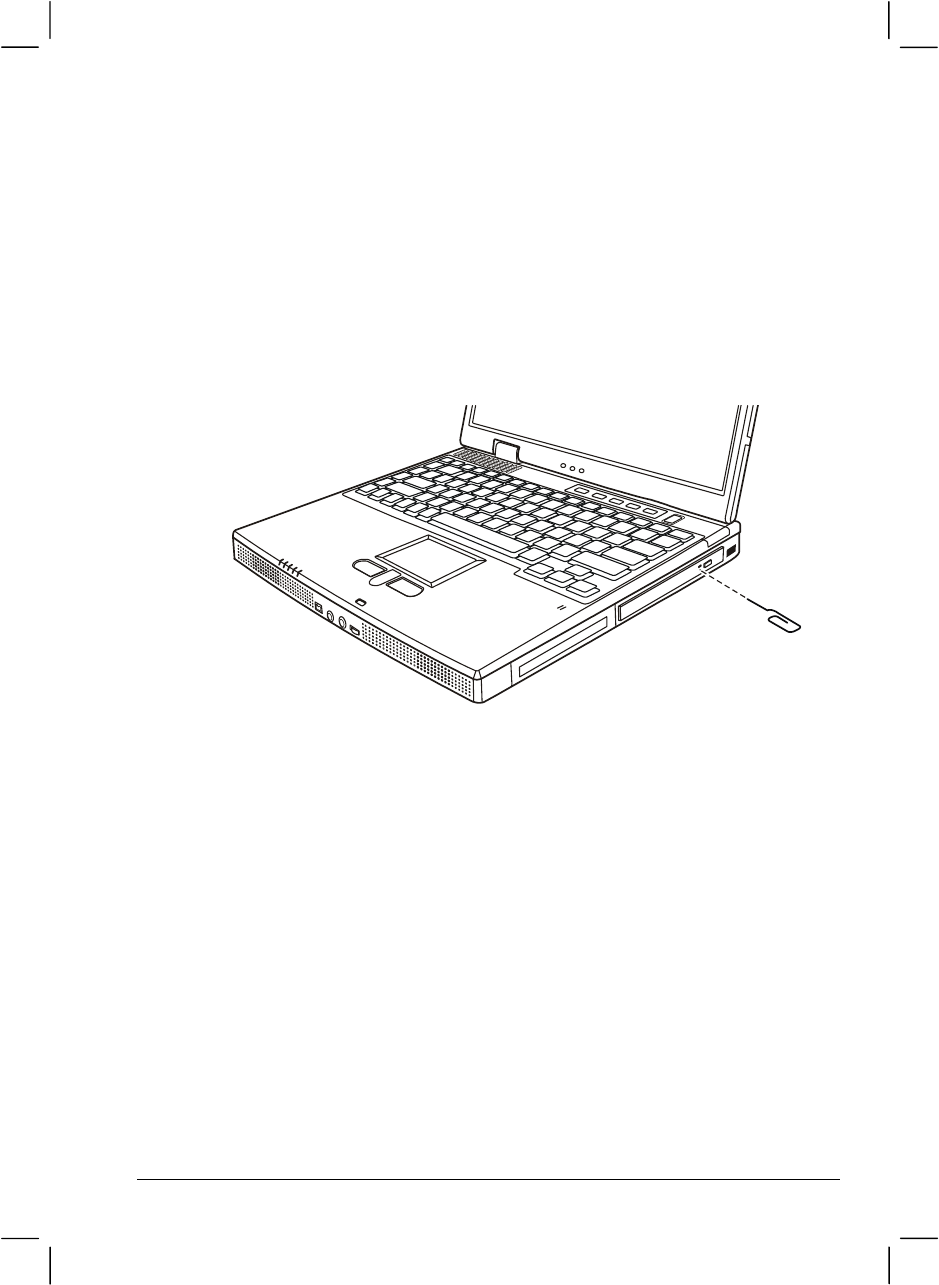
7URXEOHVKRRWLQJ
You cannot eject a CD.
z The CD is not properly seated in the drive. Manually release the CD
following the method described next:
1. Turn off the system.
2. Insert a small rod, such as a straightened paper clip, into the
drive’s manual eject hole and push firmly to release the tray.
3. Pull the tray out until fully extended, and then remove the CD.
'LVSOD\3UREOHPV
Nothing appears on the screen.
z During operation, the screen may automatically turn off as a result of
power management. Press any key to see if the screen comes back.
z The brightness level might be too low. Increase brightness by
pressing )Q+).
z The display output might be set to an external device. To switch the
display back to the LCD, press )Q+), or change the display through
the settings in Display Properties.
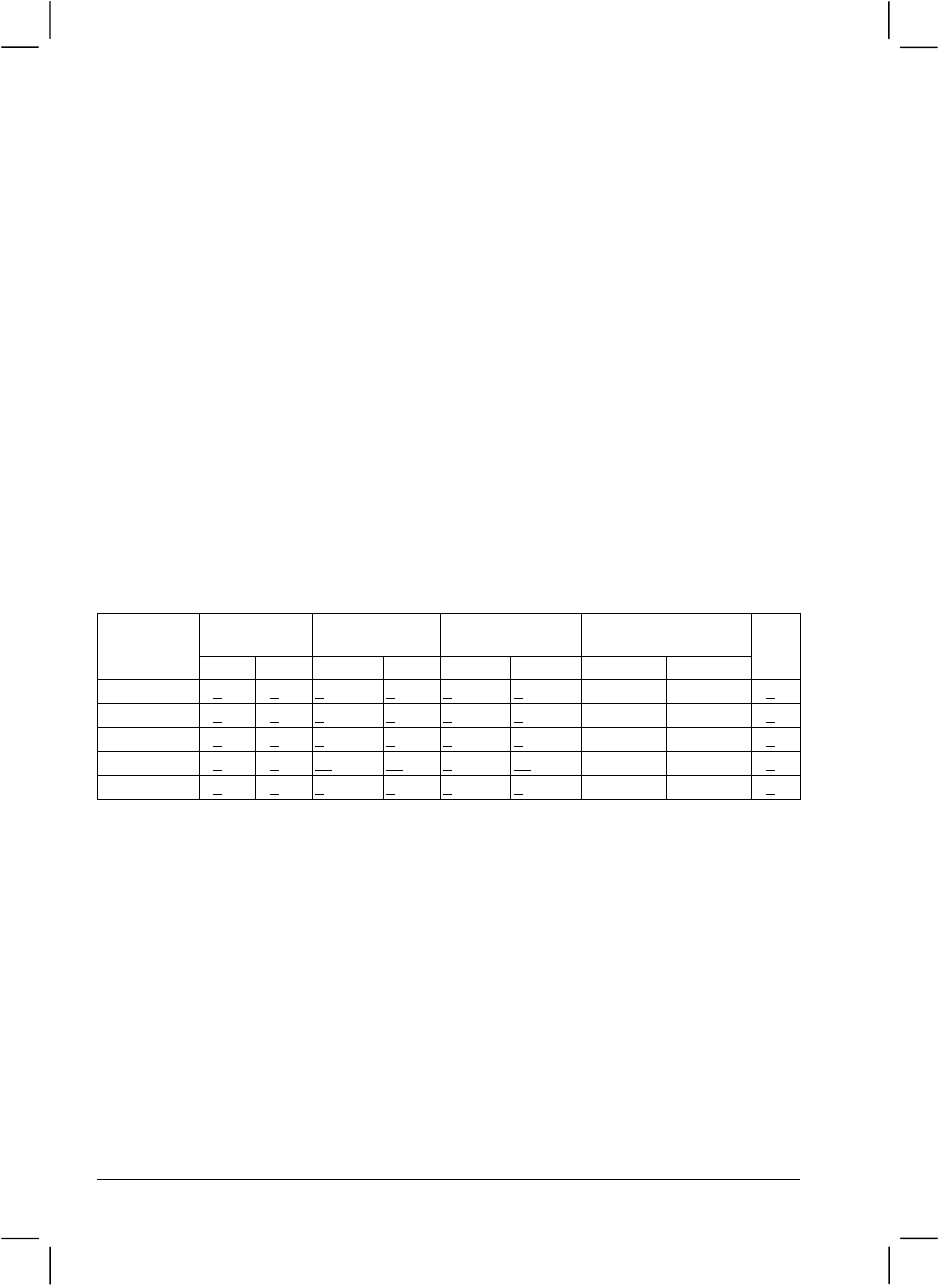
7URXEOHVKRRWLQJ
The characters on the screen are dim.
z Adjust the brightness and/or contrast.
Bad dots appear on the display at all times.
z A small number of missing, discolored, or bright dots on the screen
are an intrinsic characteristic of TFT LCD technology. It is not
regarded as a LCD defect.
Term definition:
Bright dots When the LCD screen is lighted, dots appear bright
at a dark area. Red/green/blue bright dots also
count.
Dark dots When the LCD screen is lighted, dots appear black
at bright areas.
Distance between
defective dots The minimum distance between two defective dots.
Adjacent defective dots Defective dots within a radius of 10 mm.
Defective dots Distance between
defective dots
Two adjacent
defective dots
Three or more adjacent
defective dots
LCD Type
Bright Dark Bright Dark Bright Dark Bright Dark
Total
12.1" SVGA N<5 N<5 <15mm <15mm <2 Pairs <2 Pairs Not allowed Not allowed N<8
13.3" XGA N<5 N<7 <15mm <15mm <2 Pairs <2 Pairs Not allowed Not allowed N<9
14.1" XGA N<5 N<7 <15mm <15mm <2 Pairs <2 Pairs Not allowed Not allowed N<9
15" XGA N<8 N<8 <15mm <15mm <2 Pairs <2 Pairs Not allowed Not allowed N<10
18" XGA N<9 N<15 <5mm <20mm <3 Pairs <5 Pairs Not allowed Not allowed N<20
Resolution cannot be adjusted to desired setting.
z Make sure that the video driver is installed correctly.
The external monitor displays nothing.
z Make sure that the monitor is turned on.
z Make sure that the monitor’s signal cable is properly connected.
z Switch the display to the monitor by pressing )Q+)or change the
display through the settings in Display Properties.

7URXEOHVKRRWLQJ
The TV displays nothing.
z Make sure that the TV is turned on and switched to the video mode.
z Make sure that the TV’s signal cable is properly connected.
z Make sure that the TV System is set correctly in the BIOS SCU
program.
z Switch the display to the TV by pressing )Q+)or change the display
through the settings in Display Properties.
Simultaneous display does not work.
z Make sure that you turn on the external monitor before turning on the
computer.
z Press)Q+) or change the display through the settings in Display
Properties to toggle through the five display options.
)ORSS\'LVN'ULYH3UREOHPV
The disk drive does not work.
z Make sure that the disk drive is properly connected.
z If you are using Windows 98, make sure that the disk drive driver is
installed correctly.
The Floppy Disk Drive In-use Indicator stays on.
z Make sure that the floppy disk is not physically damaged.
z Make sure that the floppy disk is inserted correctly.
The disk drive cannot write to a floppy disk.
z Make sure that the floppy disk is formatted.
z Make sure that the floppy disk is not write-protected.
z Make sure that you are writing to the correct drive.
z Make sure that there is enough space left on the floppy disk.
z Make sure that the floppy disk is not physically damaged.

7URXEOHVKRRWLQJ
The disk drive cannot read a floppy disk.
z Make sure that the floppy disk is formatted.
z Make sure that you are reading the correct drive.
+DUGZDUH'HYLFH3UREOHPV
The computer does not recognize a newly installed device.
z The device may not be correctly configured in the SCU program. Run
the SCU program to identify the new type.
z Make sure if any device driver needs to be installed. (Refer to the
documentation that came with the device.)
z Make sure if the device needs any jumper or switch settings. (Refer to
the documentation that came with the device.)
z Check the cables or power cords for correct connections.
z For an external device that has its own power switch, make sure that
the power is turned on.
+DUG'LVN'ULYH3UREOHPV
The computer cannot find the hard disk drive after it is turned on.
z Make sure that the hard disk type is configured correctly in the SCU
program.
The hard disk drive error message appears on the screen.
z The hard disk drive has defects. Ask your dealer for help.
The hard disk drive operations seem slow.
z The data files stored on the hard disk drive may be fragmented. Use a
tool such as Window’s Disk Defragmenter to defragment the files.
The hard disk drive in-use indicator glows without blinking.
z The data files stored on the hard disk drive may be fragmented. Use a
tool such as Window’s Disk Defragmenter to defragment the files.

7URXEOHVKRRWLQJ
,QIUDUHG3UREOHPV
The IR port does not work.
z Make sure that the IR ports of the two device face each other within a
±15-degrees angle and 1 meter (3 feet) distance and there are no
obstructions in between.
z Make sure that the device connected is using an equivalent speed.
z Make sure that the IrDA Fast Infrared Port is set to HP HSDL-
2300/3600.
z Make sure that the IR port configuration is set correctly in the SCU
program.
z If you are printing to an infrared printer, make sure that the
appropriate driver is installed.
z If you are using any file transfer functions, make sure that both the
computer and the IR device have the appropriate software running.
z Make sure that there is no device radiating infrared rays, such as
remote-controlled devices or wireless headphones, near the computer
or device.
z Make sure that no direct sunlight or fluorescent lamps are near the
computer or device.
z Make sure that the IR ports are clean.
.H\ERDUG0RXVHDQG7RXFKSDG3UREOHPV
The keyboard does not respond.
z Try connecting an external keyboard. If it works, contact an
authorized dealer, as the internal keyboard cable might be loose.
The numeric keypad is disabled.
z Make sure that the 1XP/RFN is switched on. (Check if the Num Lock
Indicator lights green or not.)

7URXEOHVKRRWLQJ
The external keyboard does not work.
z Make sure that the keyboard cable is properly connected.
The touchpad does not work, or the pointer is difficult to control
with the touchpad.
z Make sure that the touchpad is clean.
/$13UREOHPV
I cannot access the network.
z Make sure that the LAN driver is correctly installed.
z Make sure that the LAN cable is properly connected to the RJ-45
connector and the network hub.
z Make sure that the network configuration is appropriate.
z Make sure that the user name or password is correct.
0RGHP3UREOHPV
The modem does not work.
z Make sure that the modem driver is correctly installed.
z Make sure that the telephone line is properly connected.
z Make sure that the COM port in the communication software is
correctly set.
z Turn off power management.
3&&DUG3UREOHPV
The PC Card does not work.
z Make sure that the PC Card is correctly seated.

7URXEOHVKRRWLQJ
z If the card requires an IRQ (interrupt request), make sure that there is
one available.
The PC Card stops communicating properly.
z The application may have been reset when the computer is turned off
or in Standby mode. Exit and restart the application.
3RZHU0DQDJHPHQW3UREOHPVIRU:LQGRZV
The computer does not enter Standby or Hibernation mode
automatically.
z If you have a connection to another computer, the computer does not
enter Standby or Hibernation mode if the connection is actively in
use.
z Make sure that the Standby or Hibernation time-out is enabled.
The computer does not enter Standby or Hibernation mode
immediately.
z If the computer is performing an operation, it normally waits for the
operation to finish.
The computer does not resume from Standby or Hibernation mode.
z The computer automatically enters Standby or Hibernation mode
when the battery pack is empty. Do any one of the following:
− Connect the AC adapter to the computer.
− Replace the empty battery pack with a fully charged one.
The computer does not enter Hibernation mode with the )Q+) hot
keys.
z Make sure that the Hibernation function is specified for the sleep
button.
z If you are using Windows 98, make sure that the hibernation partition
or file exists.
z You might be using a PC Card that prevents the computer from
entering Hibernation mode. To enter the mode, stop the
communication program and then remove the card or stop the card.

7URXEOHVKRRWLQJ
3ULQWHU3UREOHPV
The printer does not work.
z Make sure that the printer is turned on (if it comes with an
independent power source) and is online (ready to use).
z Make sure that the printer’s signal cable is properly connected.
z Make sure that the printer driver is correctly installed.
z Make sure that you have assigned the printer port correctly in your
operating system or application program.
z Make sure that the printer port is enabled in the SCU program.
The printer prints garbled information.
z Make sure that the printer driver is correctly installed.
z Make sure that the printer cable is properly connected.
6RIWZDUH3UREOHPV
An application program does not work correctly.
z Make sure that the software is correctly installed.
z If an error message appears on the screen, consult the software
program’s documentation for further information.
z If you are sure the operation has stopped, reset the computer. (See
“Resetting the Computer” in this chapter.)
6RXQG3UREOHPV
No sound is produced.
z Make sure that the volume control is not set too low.
z Make sure that the audio driver is correctly installed.
z Make sure that the computer is not in Standby mode.

7URXEOHVKRRWLQJ
z If using an external speaker, make sure that the speaker is properly
connected.
Distorted sound is produced.
z Make sure that the volume control is not set too high or too low. In
most cases, a high setting can cause the audio electronics to distort the
sound.
The sound system does not record.
z Adjust the playback or recording sound levels.
The external microphone or audio device does not work.
z Make sure that the microphone is connected to the proper connector
on the computer.
z Make sure that your computer is equipped with the driver needed.
z Click the speaker symbol on the taskbar and check the Windows
volume control.
z Check the volume control of your computer.
6WDUWXS3UREOHPV
When you turn on the computer, it does not respond and the Power
Indicator does not light green.
z If you are using an external AC power, make sure that the AC adapter
is correctly and securely connected. If so, make sure that the electrical
outlet works properly.
z If you are using the battery power, make sure that the battery is not
discharged.
When you turn on the computer, it stops after POST.
z Restart your computer.

7URXEOHVKRRWLQJ
The message “Operating system not found” appears on the screen
after you turn on the computer.
z Make sure that there is no floppy disk in the floppy disk drive. If there
is, remove it and restart the system.
z If this message appears when you are booting from the hard disk,
insert a bootable disk in the floppy disk drive and check the condition
of the hard disk.
z Make sure that the hard disk is set correctly in the SCU program.
The message “Invalid system disk” or “Disk error” appears on the
screen after you turn on the computer.
z If you are deliberately trying to boot from a floppy disk, replace the
disk with a bootable one and press any key to continue booting.
z If you are booting from the hard disk, make sure that there is no
floppy disk in the floppy disk drive. If there is, remove it and restart
the system.
z If this message appears when you are booting from the hard disk,
insert a bootable disk in the floppy disk drive and check the condition
of the hard disk.
z Make sure that the hard disk is set correctly in the SCU program.
2WKHU3UREOHPV
The date/time is incorrect.
z Correct the date and time via the operating system or SCU program.
z After you have performed everything as described above and still
have the incorrect date and time every time you turn on the computer,
the RTC (Real-Time Clock) battery is at the end of its life. Call an
authorized dealer to replace the RTC battery.

7URXEOHVKRRWLQJ
5HVHWWLQJWKH&RPSXWHU
You may have to reset (reboot) your computer on some occasions when
an error occurs and the program you are using hangs up.
If the system operation seems to hang up, first wait. It is possible that the
system is processing data. Periodically check the hard disk drive in-use
indicator, if it flashes irregularly, the program may be accessing data and
preventing you from using the keyboard. If you are sure the operation has
stopped and you cannot use the “restart” function of the operating system,
reset the computer.
Reset the computer by any one of these methods:
z Press&WUO+$OW+'HO.
z If the above action does not work, turn off the system. Wait for at
least five seconds and turn it on again.
&$87,215HVHWWLQJZLOOFDXVHDQ\XQVDYHGGDWDWREHORVW
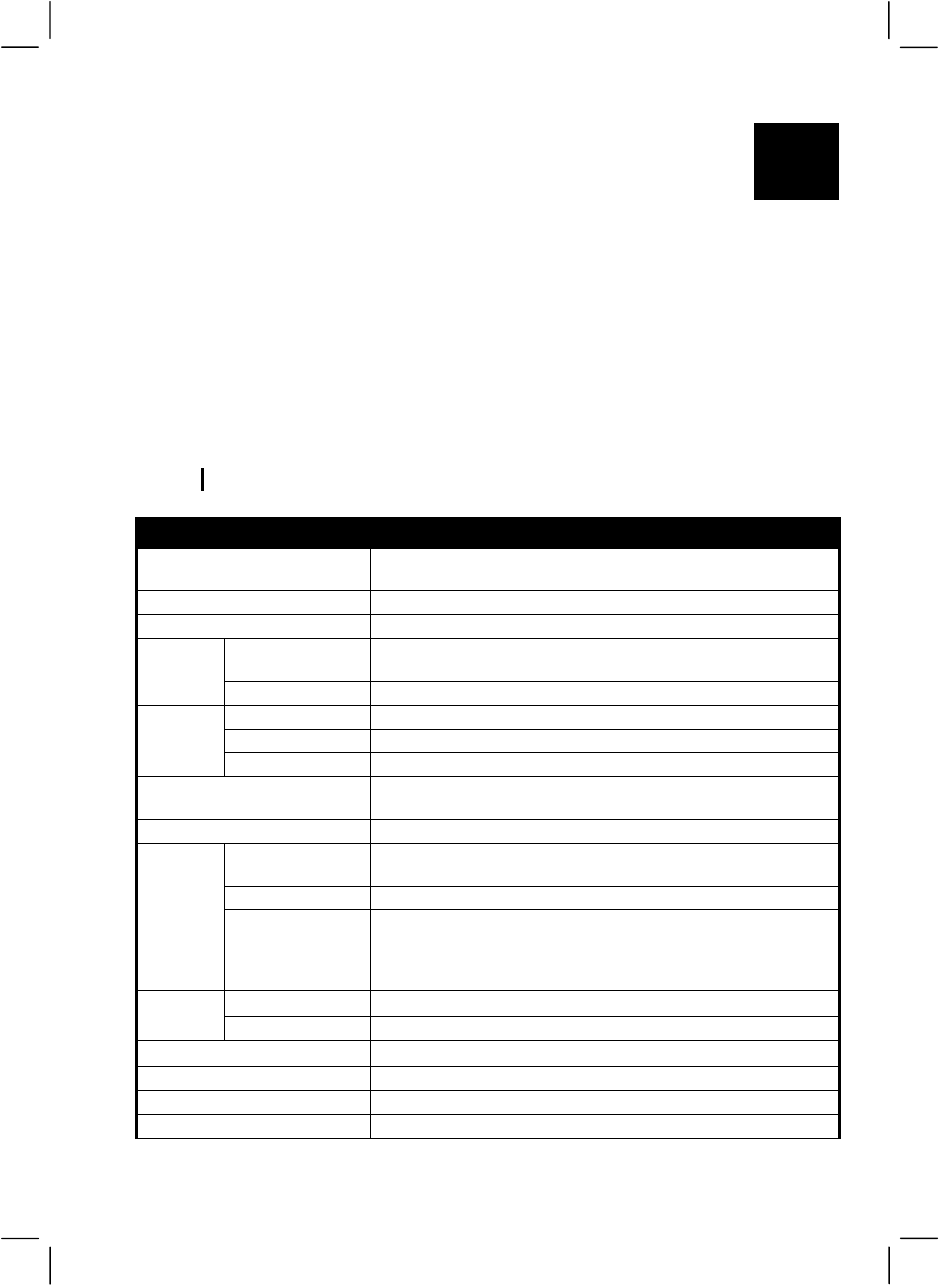
APPENDIX A
Specifications
127(6SHFLILFDWLRQVDUHVXEMHFWWRFKDQJHZLWKRXWDQ\SULRUQRWLFH
Parts Specifications
CPU Mobile/Desktop Intel Pentium 4 Processor and Celeron Processor,
mPGA 478 socket
Cache Memory 256/512 KB on-die (integrated with CPU)
ROM BIOS 256 KB Flash EEPROM
System 2 x 200 pin DDR-SODIMM socket for expansion, support
PC1600/PC2100 DDR module, up to 1024 MB
RAM
Video 8/16/32/64 MB (shared from system memory, 32MB by default)
Panel 14.1/15-inch TFT XGA LCD, resolution up to 1024×768
Video controller Integrated in SiS650, Ultra AGP
Display
Video ports VGA port, S-video connector
Keyboard Standard keys, numeric keypad, 12 function keys, a special Fn
(Function) key and Windows keys
Pointing device PS/2-compatible touchpad with 2 buttons and scroll button
Floppy disk drive
(external)
3.5-inch, 1.44 MB, USB (optional)
Hard disk drive 2.5-inch, 9.5mm high, IDE, Ultra DMA 33/66/100 supported
Storage
device
CD/DVD/
CD-RW/Combo
drive
24X CD-ROM
8X DVD-ROM (optional)
8X8X24X CD-RW (optional)
8X8X8X24X Combo (optional)
Audio controller ALC201, AC’97Audio
Audio port Two audio ports for Mic-in / Line-out
PC Card TypeǨx 1, PCMCIA 2.1 compliant, CardBus support
I/O ports ECP/EPP parallel port, four USB ports, FIR/SIR port, IEEE 1394 port
Modem 56 Kbps V.90 MDC internal Fax Modem
LAN Fast Ethernet, 10/100 Mbps auto-negotiation
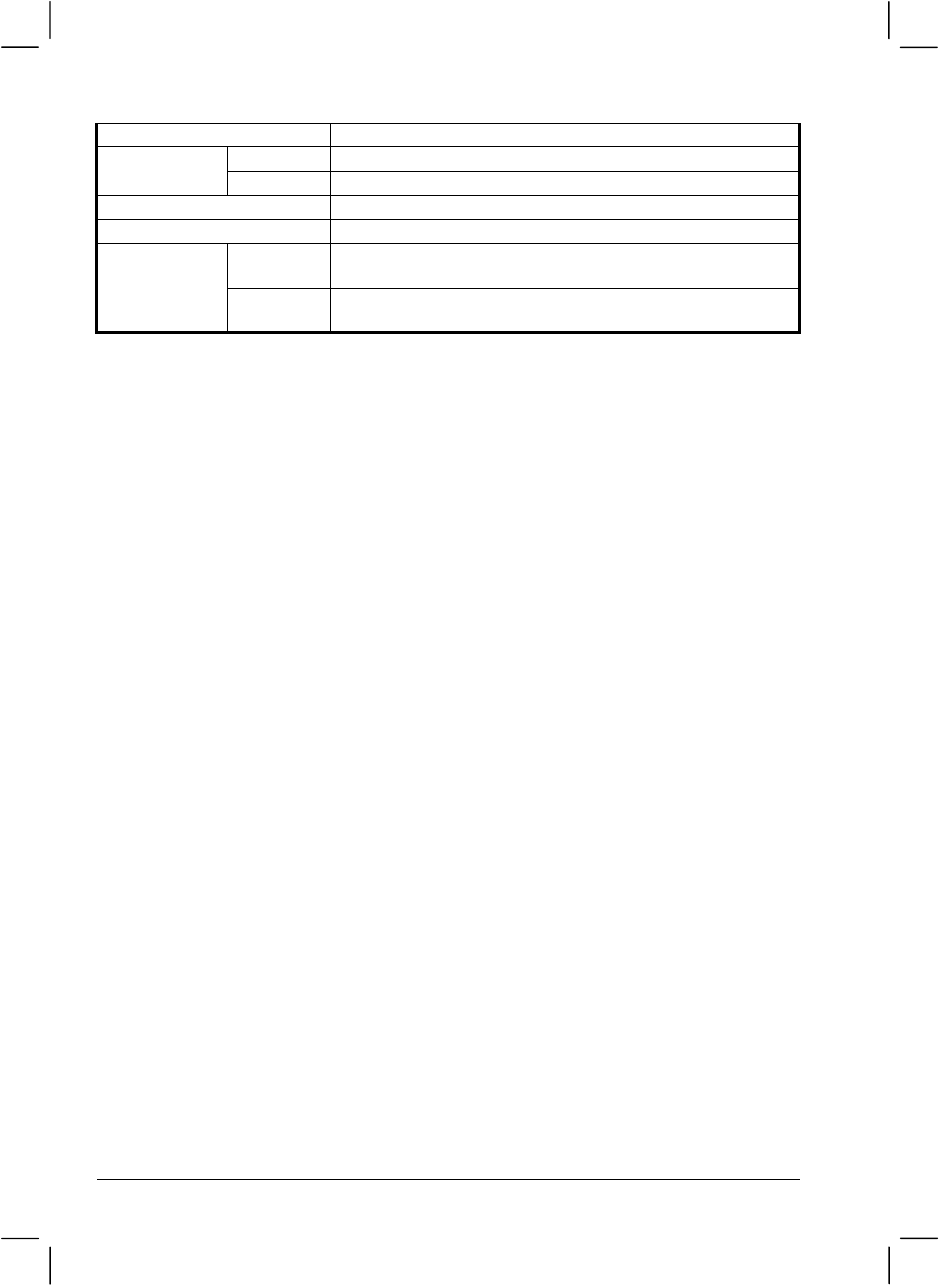
$ 6SHFLILFDWLRQV
Wireless LAN Mini PCI (optional)
AC adapter Universal AC adapter 90W; input: 100∼240V, 50/60Hz AC
Power
Battery 9-cell 2000mAH Li-ION battery
Dimension (W×D×H) 12.9×10.8×1.5/1.8 inch (328×274×37/46 mm)
Weight 7.5 lb (3.4 kg)
Temperature Operating: 10°C (50°F) to 35°C (95°F)
Storage: 0°C (32°F) to 60°C (140°F)
Environment
Humidity Operating: 10% to 90% non-condensing
Storage: 5% to 90% non-condensing

,QGH[ ,
Index
A
AC, 3-2
AC adapter, 3-2, A-2
Connecting, 1-2
AC power
Connecting, 1-2
ACPI, 3-7
Alt key, 2-4
Anti-Virus, 7-3
APM, 3-7
ASK, 4-7
Audio driver, 6-3
Audio output connector, 1-9, 2-22
Audio subsystem, A-1
Connecting external audio devices, 2-22
Driver installation, 6-3
Feature, 2-21
Troubleshooting, 8-13
B
Backspace key, 2-4
Battery Low, 3-5
Battery pack, 1-6, 3-3, A-2
Battery Low, 3-5
Charging, 3-3
Checking the battery level, 3-4
Initializing, 3-4
Replacing, 3-4
Taking care, 7-5
Troubleshooting, 8-4
BIOS, 5-1
BIOS SETUP, 5-1
Booting, 2-2
Brightness, 2-8
C
Cache, A-1
Caps Lock, 2-5
Indicator, 1-9
CardBus, 4-10
CD. See CD drive
CD drive, 1-6, 2-17, A-1
Inserting a CD, 2-18
In-use indicator, 1-9
Troubleshooting, 8-4
CD-ROM drive. See CD drive
CD-RW drive. See CD drive
Charging, 3-3
Cleaning the computer, 7-5
Click, 2-11
COM port
Mode setting, 5-7
Setting, 5-7
Connecting external devices
IEEE 1394 device, 4-9
IR device, 4-7
Monitor, 4-2
Parallel device, 4-5
TV, 4-3
USB device, 4-6
Cover
Opening, 1-3
CPU, A-1
CRT monitor. See Monitor
Ctrl key, 2-4
Cursor, 2-5

, ,QGH[
Cursor-control key, 2-5
D
Date, 5-5, 8-14
DC, 3-2
Dimension of the computer, A-2
Display mode, 2-19
Double-click, 2-11
Drag and drop, 2-11
Drive A, 2-14
Drive C, 2-16
Drive D, 2-17
Driver installation, 6-1
DVD-ROM drive. See CD drive
E
Easy Start button, 1-11, 2-13
Defining the button, 6-4
Easy Start button driver
Driver installation, 6-3
ECP, 4-5
EEPROM, A-1
Environmental specifications, A-2
EPP, 4-5
ESB. See Easy Start button
Esc key, 2-4
Euro symbol, 2-7
F
FIR, 4-7
Floppy disk drive, 2-14, A-1
Connecting, 2-14
Ejecting floppy disks, 2-15
Inserting floppy disks, 2-15
Troubleshooting, 8-7
Fn key, 2-8
Function key, 2-8
H
Hard disk drive, 1-7, 2-16, A-1
In-use indicator, 1-9
Troubleshooting, 8-8
Hibernation, 2-3, 3-7, 3-8
Troubleshooting, 8-11
Hot keys, 2-8
Humidity, A-2
I
IEEE 1394 device
Connecting, 4-9
IEEE 1394 port, 1-9
Indicator
Caps Lock, 1-9
CD/DVD/CD-RW/Combo drive, 1-9
Hard disk drive, 1-9
Num Lock, 1-9
Scroll Lock, 1-9
IR device
Connecting, 4-7
IR port, 1-6
Troubleshooting, 8-9
IrDA. See IR port
K
Kensington lock, 1-7, 7-2
Keyboard, 1-10, 2-4, A-1
Troubleshooting, 8-9
L
LAN, 2-24, A-1
Connector, 1-7
Driver installation, 6-3
Troubleshooting, 8-10
LAN driver, 6-3
LCD, 1-10, 2-19, A-1
Switching on and off with hot keys, 2-9
Troubleshooting, 8-5
Line-out. See Audio output connector
Location of the computer, 7-4
Low battery. See Battery Low

,QGH[ ,
M
Microphone, 1-10, 2-21
Microphone connector, 1-9, 2-22
Modem, 2-23, A-1
Driver installation, 6-3
Troubleshooting, 8-10
Modem driver, 6-3
Monitor
Connecting, 4-2
Mouse
Troubleshooting, 8-9
N
Network. See LAN
Num Lock, 2-4
Indicator, 1-9
Numeric key, 2-6
O
Operating system, 1-5, 2-2
P
Parallel device
Connecting, 4-5
Parallel port, 1-8, 4-5
Mode setting, 5-7
Setting, 5-7
Pause key, 2-5
PC Card, 4-10, A-1
Inserting, 4-10
Removing, 4-11
Slot, 1-7
Troubleshooting, 8-11
PCMCIA, 4-10
Point, 2-11
Pointing device, A-1
POST, 1-5
Power, A-2
Power button, 1-10, 2-2
Power connector, 1-8
Power Management, 3-7
Troubleshooting, 8-11
Power-On Self Test. See POST
Print Screen key, 2-5
Printer
Troubleshooting, 8-12
R
RAM, A-1
Rebooting, 8-15
Resetting, 8-15
Restarting, 8-15
RJ-11, 1-8, 2-23
RJ-45, 1-7, 2-24
ROM BIOS, A-1
S
Saving power, 3-9
Screen. See LCD
Scroll, 2-11
Scroll button, 1-10
Scroll Lock, 2-5
Indicator, 1-9
Security
BIOS setting, 5-9
Protecting the computer with lock, 7-2
Protecting the computer with password,
7-2
Shift key, 2-4
Shutting down, 1-5, 2-2
Simultaneous display, 2-19
SIR, 4-7
Sleep button, 2-9
Software
Troubleshooting, 8-12
Software driver, 6-1
Speaker, 1-9, 2-21
Connecting external speakers, 2-22
Specifications, A-1
Standby, 2-2, 3-7
Troubleshooting, 8-11
Startup, 2-2
Troubleshooting, 8-13
S-video connector, 1-8

, ,QGH[
T
Telephone line
Connecting, 2-23
Connector, 1-8
Temperature, A-2
TFT, 2-19
Time, 5-5, 8-14
Touchpad, 1-10, 2-10, A-1
Configuring, 2-12
Driver installation, 6-3
Troubleshooting, 8-9
Touchpad driver, 6-3
Traveling with the computer, 7-6
Troubleshooting, 8-1
Battery problem, 8-4
CD drive problem, 8-4
Display problem, 8-5
Floppy disk drive problem, 8-7
Hard disk drive problem, 8-8
Hardware problem, 8-8
Infrared problem, 8-9
Keyboard problem, 8-9
LAN problem, 8-10
Modem problem, 8-10
Mouse problem, 8-9
Other problem, 8-14
PC Card problem, 8-11
Power Management problem, 8-11
Printer problem, 8-12
Software problem, 8-12
Sound problem, 8-13
Startup problem, 8-13
Touchpad problem, 8-9
Turning off, 1-5, 2-2
Turning on, 1-4
TV
Connecting, 4-3
TV
BIOS, 5-6
Typewriter key, 2-4
U
Upgrading the computer, 4-12
USB device
Connecting, 4-6
USB port, 1-8, 4-6
V
VGA port, 1-8
Video driver, 6-3
Video subsystem
Configuring, 2-19
Driver installation, 6-3
Feature, 2-19
Video controller, A-1
Video RAM, A-1
Virus, 7-3
Volume control, 1-9, 2-21
W
Weight of the computer, A-2
Windows, 1-5
Windows key, 2-7